Jun 19, 2025
All 208 Amazon Fees (and counting…)

You probably noticed, that some Amazon seller fees are not well described on Seller Central, or even worse - not described at all.
Get Your Amazon Fees Under Control with Shopkeeper
You can bookmark this page as a reference, to come back and look up any fee you were charged and would like to know more about.
Table of Contents
- A2Z Guarantee Recovery
- ABA Fee
- Advertise Catalog
- Advertise Coupons
- Advertise Deals
- Advertise Excess FBA Inventory
- Advertise Items with Low Traffic
- Advertise New Products
- Advertise Seasonal Products
- Advertise Top Selling Items
- Amazon Accelerator Fee
- Amazon Exclusives Fee
- Amazon For All Fee
- Amazon Shipping Chargebacks
- Amazon Shipping Charges
- Amazon Shipping Reimbursement
- Amazon Upstream Processing Fee
- Amazon Upstream Storage Transportation Fee
- Automated Campaign
- Bubblewrap Fee
- FBM Bump
- Buyer Recharge
- Buy with Prime CS Error Non Itemized
- Buy with Prime Customer Refund
- FBM Carriage
- Cast a Wide Net
- Catch All
- Category Targeting
- Chargeback Recovery
- CLI Planned Fee Reimbursement
- COD Chargeback
- COD Item Charge
- COD Item Tax Charge
- COD Order Charge
- COD Order Tax Charge
- COD Shipping Charge
- COD Shipping Tax Charge
- Commission
- Commission Correction
- Compensated Clawback
- Coupon Redemption Fee
- CReturn Wrong Item
- CSBA Fee
- CS Error Items
- Customer Return HRR Unit Fee
- FBA Customer Return Per Order Fee
- FBA Customer Return Per Unit Fee
- FBA Customer Return Weight Based Fee
- Debt Adjustment
- Delivery Fulfillment Fee
- FBA Delivery Services Fee
- Digital Services Fee
- Digital Services Fee FBA
- Disbursement Correction
- FBA Disposal Fee
- EPR Pay on Behalf Eco-contribution - EEE
- EPR Pay on Behalf Eco-contribution - Toys
- EPR Pay on Behalf Service Fee - EEE
- EPR Pay on Behalf Service Fee - Toys
- EPSO Chargeback Fee
- EPSO Cross-Border Fee
- EPSO Payment Auth Fee On Finalize
- EPSO Payment Settle Fee On Finalize
- Estimated Commission
- Estimated FBA Fees
- Estimated Principal
- Estimated Tax
- Excess inventory
- Export Charge
- Failed Disbursement
- FBA001 Auto
- FBA Fee
- FBA Per Order Fulfillment Fee
- FBA Per Unit Fulfillment Fee
- Fee Adjustment
- Free Replacement Refund Items
- Generic Deduction
- Get Paid Faster Fee
- Gift Wrap Charge
- Gift Wrap Chargeback
- Gift Wrap Commission
- Gift Wrap Tax
- Global Inbound Transportation Duty
- Global Inbound Transportation Freight
- Goodwill
- High Volume Listing Fees
- Import Taxes Amount
- Inbound Carrier Damage
- FBA Inbound Convenience Fee
- FBA Inbound Defect Fee
- FBA Inbound Shipment Carton Level Info Fee
- FBA Inbound Transportation Fee
- FBA Inbound Transportation Program Fee
- FBA Inbound Transportation Service Fee
- Increase Visibility on Low Traffic Items
- Inspection Amount
- FBA Inventory Fee
- Incorrect Fees Items
- FBA International Inbound Freight Fee
- FBA International Inbound Freight Tax And Duty
- Inventory Placement Fee
- Item TDS
- Labeling Fee
- Local Shipping Amount
- FBA Long Term Storage Fee
- Lost Or Damaged Reimbursement
- Low Value Goods Tax - Other
- Low Value Goods Tax - Principal
- Low Value Goods Tax - Shipping
- Manufacturing Amount
- Marketplace Facilitator Regulatory Fee - Principal
- Marketplace Facilitator Tax
- Marketplace Facilitator VAT - Principal
- Marketplace Facilitator VAT - Restocking Fee
- Marketplace Facilitator VAT - Shipping
- MFN Delivery Service Fee
- MFN Postage Fee
- MFN Shipmate Cost
- Misc Adjustment
- Multichannel Order Damage
- Multichannel Order Late
- Multichannel Order Lost
- FBA Multitier Per Unit Fee
- Non-subscription Fee Adjustment
- Opaque Bagging Fee
- FBA Overage Fee
- Paid Services Fee
- Payment Method Fee
- Payment Retraction Items
- Payment Retraction Non-Itemized
- PoA Per Unit Fulfillment Fee
- POA Service Fee
- Points Adjusted
- Policy Violation
- Polybagging Fee
- Postage Billing - Carrier Pickup
- Postage Billing - Congestion Charge
- Postage Billing - Delivery Area Surcharge
- Postage Billing - Delivery Confirmation
- Postage Billing - Fuel Surcharge
- Postage Billing - Import Duty
- Postage Billing - Insurance
- Postage Billing - Oversize Surcharge
- Postage Billing - Postage
- Postage Billing - Postage Adjustment
- Postage Billing - Signature Confirmation
- Postage Billing -Tracking
- Postage Billing - Transaction Fee
- Postage Billing - VAT
- Postage Refund - Carrier Pickup
- Postage Refund - Congestion Charge
- Postage Refund - Delivery Area Surcharge
- Postage Refund - Delivery Confirmation
- Postage Refund - Fuel Surcharge
- Postage Refund - Import Duty
- Postage Refund - Insurance
- Postage Refund - Oversize Surcharge
- Postage Refund - Postage
- Postage Refund - Postage Adjustment
- Postage Refund - Signature Confirmation
- Postage Refund - Tracking
- Postage Refund - Transaction Fee
- Postage Refund - VAT
- Premium Experience Fee
- Prep Fee Refund
- Pricing Error
- Prime Wardrobe Reimbursement
- Prime Wardrobe Reimbursement Manual
- Principal
- Product Cost VAT
- Product VAT
- Production
- Promotion Meta Data Definition Value
- Promotions
- ReCommerce Grading And Listing Charge
- ReCommerce Grading And Listing Refund
- Re-Evaluation
- Referral Fee
- Refund Admin Fee
- Refund Commission
- Region Shipping Amount
- Regulatory Fee
- Reimbursement Clawback
- Remote Fulfillment Credit
- FBA Removal Fees
- Removal Order Damaged
- Removal Order Lost
- Renewed Program Fee
- Reserve Credit
- Reserve Debit
- Restocking Fee
- Return Postage Billing - Carrier Pickup
- Return Postage Billing - Delivery Area Surcharge
- Return Postage Billing - Delivery Confirmation
- Return Postage Billing - Fuel Surcharge
- Return Postage Billing - Oversize Surcharge
- Return Postage Billing - Postage
- Return Postage Billing - Postage Commission
- Return Postage Billing - Tracking
- Return Postage Billing - Transaction Fee
- Return Postage Billing - VAT
- Return Shipping
- Reversal Reimbursement
- Run Lightning Deal Fee
- SAFET Reimbursement Charge
- Sales Commission
- Sales Tax Collection Fee
- Sales Tax Service Fee
- Seller Rewards
- FBM Shipment
- FBM Shipping
- Shipping Charge
- Shipping Chargeback
- FBM Shipping Fee
- Shipping Holdback Fee
- Shipping Promo
- Shipping Tax
- STAR Storage Billing
- STAR Storage Fee
- Subscription
- Subscription Fee Correction
- FBA Storage Fee
- Taping Fee
- Tax
- Tax Collected At Source
- Technology Fee
- FBA Transportation Fee
- FBA Try Before You Buy Multitier Per Unit Fee
- Variable Closing Fee & Fixed Closing Fee
- VAT Amazon Technology Fee
- VAT Fiscal Representation Fee
- VAT Manufacturing
- VAT Partner Fee
- VAT Product Cost
- VAT Purchase
- VAT Registration Fee
- VAT Transfer Fee
- Vine Fee
- Warehouse Damage
- Warehouse Damage Exception
- Warehouse Lost
- Warehouse Lost Manual
A2Z Guarantee Recovery
A2ZGuaranteeRecovery describes the credit note that Amazon gives to sellers in the event that an A-Z warranty case ends in the sellers' favor. This credit signifies a settlement in the seller's favor and compensates for any losses suffered as a result of the dispute. In essence, it pays vendors for any returns or exchanges that clients receive as part of the A-Z Guarantee scheme. This credit remark certifies the seller's compliance with Amazon guidelines and dedication to client happiness. By guaranteeing that sellers receive payment when conflicts are settled in their favor, it also contributes to the upkeep of fairness and trust in the marketplace.
ABA Fee
ABAFee is often referred to as the "Amazon Buy Box Adjustment Fee." It is payable to sellers who win the Buy Box but do not meet specific performance requirements established by Amazon. It's a penalty cost for failing to meet Amazon's minimum standards for merchants to remain competitive in the Buy Box. This fee is intended to motivate vendors to improve their performance indicators to better serve Amazon's consumers.
Advertise Catalog
This is a fee charged to the seller for running a broad campaign that promotes most or all of the products in their catalog. The goal is to drive visibility across the seller’s entire product offering. This is a seller advertising cost.
-
Advertise Catalog_ONB is an advertising fee charged to the seller as part of an onboarding program designed to quickly promote their full catalog. It’s usually offered to new sellers to help jumpstart traffic and sales. This is a seller-side campaign fee.
-
Advertise Catalog_Opt applies to an optimized version of the catalog ad campaign, using Amazon’s automation and performance data to improve reach and efficiency. It’s still a seller-paid advertising expense, designed to get better ROI on large catalog promotions.
Advertise Coupons
This is a seller fee for advertising products that currently have coupons enabled. It helps increase visibility of these offers in search results and deal pages, attracting discount-seeking shoppers. The cost is paid by the seller.This is a seller fee for advertising products that currently have coupons enabled. It helps increase visibility of these offers in search results and deal pages, attracting discount-seeking shoppers. The cost is paid by the seller.
Advertise Deals
This fee is charged to sellers who are running ads on limited-time promotions like Lightning Deals or Best Deals. These campaigns help boost traffic during the promotion period and are a form of paid visibility for the seller.
Advertise Excess FBA Inventory
This is a seller advertising fee aimed at moving overstocked or slow-selling FBA inventory. Amazon suggests or runs these campaigns to help sellers avoid long-term storage fees by encouraging sales. The seller pays for the ad spend.
Advertise Items with Low Traffic
This is a fee charged to the seller for advertising products that are not receiving much organic traffic. The campaign helps bring attention to underperforming listings. It’s a seller-driven marketing cost.
-
Advertise Items with Low Traffic_ONB - This version of the low traffic campaign is part of a new seller onboarding flow. It targets listings with little visibility and helps new sellers gain traction. The seller is responsible for this ad fee.
-
Advertise Items with Low Traffic_Opt - An optimized campaign for low-traffic products, this fee reflects advertising costs paid by the seller to improve performance using Amazon’s algorithmic suggestions. It’s part of a strategy to rescue slow listings.
Advertise New Products
This fee is for campaigns that focus on newly launched listings. It’s designed to help sellers generate early traffic and sales velocity. The seller pays this as part of their ad strategy.
Advertise Seasonal Products
This is a seller fee for promoting products relevant to specific seasons or holidays, such as summer gear or Christmas décor. These campaigns help sellers tap into seasonal demand and trends.
Advertise Top Selling Items
This is a fee charged to the seller for campaigns centered around their best-performing products. These campaigns often have a high return on ad spend, and sellers pay to maintain top product visibility.
-
Advertise Top Selling Items_Opt is the top-selling item campaign uses Amazon’s performance data to optimize ad placements. The fee is paid by the seller and is intended to increase efficiency and profitability on already popular listings.
Amazon Accelerator Fee
For merchants who enroll in Amazon's Launchpad program, there is an additional fee known as the AmazonAcceleratorFee. This initiative supports startups and emerging brands by increasing their awareness and providing marketing assistance. The Accelerator Fee is additional to Amazon's standard selling fees and is typically calculated as a percentage of each sale.
Link Your Amazon Account Now
Amazon Exclusives Fee
The AmazonExclusivesFee is a fee charged by Amazon to sellers who want to enroll their products in the Amazon Exclusives program. This program is designed for sellers who have unique and innovative products and want to showcase them exclusively on Amazon.
Amazon For All Fee
AmazonForAllFee describes a charge for Amazon services that are intended to increase accessibility or encourage diversity. This fee may be part of programs or initiatives designed to support sellers or enhance customer experiences across diverse demographics. For the most up-to-date information on this cost, it is recommended to consult your Seller Central account or Amazon's official paperwork, as the specifics and intent may differ.
Amazon Shipping Chargebacks
Penalties known as AmazonShippingChargebacks are levied against sellers or outside logistics companies who violate Amazon's particular shipping regulations. Inaccurate labeling, poor packaging, missed shipping dates, inappropriate routing, or a lack of paperwork can all lead to these problems. When shipments to Amazon's fulfillment centers don't meet the necessary requirements, chargebacks happen, and a seller's revenue may suffer from repeated infractions. To avoid these fines, you must adhere to Amazon's shipping policies.
Amazon Shipping Charges
When using Amazon's fulfillment services to ship their products, sellers must pay Amazon shipping charges. These fees change according to the product's weight, size, and delivery time. Shipping, packing, and storage are all covered by fees for Fulfillment by Amazon (FBA). Merchant Fulfilled Network (MFN) merchants are in charge of their own delivery and pricing. Shipping may be included in the Prime membership for products that qualify for Prime, but sellers are still responsible for fulfillment fees.
Amazon Shipping Reimbursement
Amazon Shipping Reimbursement reimburses sellers for inventory that is misplaced, damaged, or handled improperly. Issues like misplaced or broken goods, improper customer returns, inaccurate fulfillment, and delays are all covered by reimbursements. Based on the value of the impacted inventory, Amazon reimburses sellers who submit claims.
Learn About the New Reimbursement Claim Deadlines
Amazon Upstream Processing Fee
AmazonUpstreamProcessingFee is a fee associated with Amazon's inventory management and supply chain services. This includes handling inventory before it gets to the fulfillment centers, labeling, packing, and ensuring the products satisfy Amazon's specifications. In addition, the cost consists of extra services like quality inspections and other essential processes to guarantee that the goods are prepared for transportation and storage. This charge supports the upkeep of quality and efficiency in Amazon's supply chain.
Amazon Upstream Storage Transportation Fee
Inventory moved from an upstream storage facility—which is located outside of Amazon's primary fulfillment centers—to an Amazon fulfillment center is subject to a transportation fee called AmazonUpstreamStorageTransportationFee. With the charge covering the cost of transportation, this service assists sellers in managing inventory by storing extra merchandise in less expensive storage facilities and moving it to Amazon's warehouses when needed.
Automated Campaign
This is a fee for an Amazon-run campaign where Amazon automatically selects keywords and targeting based on the seller’s product content. It’s an advertising charge to the seller and is meant to simplify ad setup.
Bubblewrap Fee
When products need to be packaged with bubble wrap, there is a fee known as the BubblewrapFee. It ensures that sellers are charged for the additional materials required to protect their items during transit, maintaining the quality of the goods while in Amazon's fulfillment network.
FBM Bump
FBM Bump is charged when an FBM seller's listing is granted a higher ranking or "bump" in search results or on the product page, potentially improving visibility and sales. The particular nature and conditions of this fee can vary, but it is usually part of Amazon's efforts to regulate and optimize the placement of FBM listings in its marketplace.
Get FBM Fees Breakdown in Seconds
Buyer Recharge
The BuyerRecharge is a fee charged to sellers when buyers pay with prepaid method such as gift cards. This fee helps Amazon cover the costs of processing these payments and varies based on the payment method and country of origin. Sellers should consider this fee because it influences their overall selling costs on the marketplace.
Buy with Prime CS Error Non Itemized
BUY_WITH_PRIME_CS_ERROR_NON_ITEMIZED appears to be related to an error or problem with customer support in the "Buy with Prime" program. The "Buy with Prime" function enables sellers to provide Prime benefits (quick delivery and easy returns) directly on their own websites. The CS_ERROR_NON_ITEMIZED component indicates that this price is for a non-itemized issue, which means that the error or expense is not broken down by product or service.
For example, if Amazon encounters a customer service difficulty when fulfilling an order through the "Buy with Prime" program, such as a system error at checkout or a delivery issue, this fee may be charged to offset the associated costs. It could be around $5, but it's most likely situational and unpredictable.
Buy with Prime Customer Refund
BUY_WITH_PRIME_CUSTOMER_REFUND is applied when Amazon processes a customer refund via the "Buy with Prime" program. If a buyer purchases a product through "Buy with Prime" and decides to return it, Amazon refunds the customer and charges the seller for the refund. The charge could cover the cost of processing the return or any associated services.
FBM Carriage
FBM Carriage refers to the shipping and handling fees incurred by a seller when fulfilling orders directly through the Fulfilled by Merchant (FBM) service. This fee covers the costs associated with packaging, transporting, and delivering products directly to customers rather than using Amazon's fulfillment services. The FBM Carriage Fee is calculated using parameters such as shipping mode, distance, and the size and weight of the objects being sent.
Cast a Wide Net
This campaign is a broad reach strategy where Amazon targets a wide audience, often beyond your typical customer base. The fee is paid by the seller and is meant to discover new customer segments.
-
Cast a Wide Net_OOC - "OOC" stands for "Out of Category." This version of the broad targeting campaign reaches customers browsing unrelated product categories. It’s a seller-paid fee designed to expand market exposure.
-
Cast a Wide Net_SO - "SO" stands for "Similar Offers." This campaign targets shoppers who are browsing products similar to yours, including those sold by competitors. The fee is paid by the seller to gain a competitive edge.
Catch All
These are typically generic ad campaigns or buckets created in Sponsored Ads (like Sponsored Products or Sponsored Brands) to capture broad or leftover traffic.
-
"SO" might stand for "Sponsored Offers"
-
"SSO" could mean "Sponsored Store Offers" or a similar variation depending on the ad setup
These are often used when campaigns are designed to grab residual traffic from non-targeted or lower-priority keywords.
Category Targeting
This refers to category-level advertising targeting in Amazon Ads.
Instead of targeting specific keywords, you're choosing to show your ads to shoppers browsing within certain product categories (e.g., "Sports Nutrition").
It helps increase visibility within related listings, especially during product launches or when testing performance across broad audiences.
Chargeback Recovery
ChargeBackRecovery is a fee that sellers must pay when a customer disputes a charge and requests a chargeback from their bank. This fee helps Amazon cover the costs associated with managing and resolving these disputes.
CLI Planned Fee Reimbursement
The process of paying Amazon sellers for planned fees, such fulfillment or referral fees, is referred to as CLI_PLANNED_FEE_REIMBURSEMENT. It makes sure that sellers get paid for any fees that they are entitled to but that were either levied in error or changed as a result of policy changes. This aids sellers in controlling expenses and preserving profitability.
COD Chargeback
CODChargeback is a fee applied to sellers when a customer disputes a Cash on Delivery (COD) order and demands a refund. This charge covers the costs of processing the dispute. Sellers should be aware of this fee because it impacts their total expenses when COD chargebacks occur. Sellers should be aware of this fee because it might influence their total profitability, particularly if they receive frequent COD chargebacks. Understanding and handling COD orders efficiently can help to reduce the occurrence of such fees.
Track Your Chargebacks
COD Item Charge
CODItemCharge applies to individual items in a Cash on Delivery (COD) order. It covers the additional fees associated with processing each item when paid for via Cash on Delivery (COD) .
COD Item Tax Charge
CODItemTaxCharge is a fee charged to sellers to handle the tax associated with items made via Cash on Delivery (COD). It is applied to each individual item in a COD order. This fee covers the additional costs associated with processing and collecting the tax amount when clients pay in cash at the time of delivery. Since COD payments require specific handling and additional administrative work to ensure that the tax is properly managed and recorded, this charge helps Amazon cover those extra expenses.
COD Order Charge
CODOrderCharge is a fee charged to sellers when customers pay for their goods using Cash on Delivery (COD) per order. This fee is meant to offset the additional costs associated with accepting and processing COD payments, such as the logistical fees involved in collecting cash from clients at the time of delivery.
COD Order Tax Charge
CODOrderTaxCharge is charged on the total order amount if the customer selects Cash on Delivery (COD) as the payment method. It includes the expenses related to managing and gathering the tax for the entire purchase.
COD Shipping Charge
CODShippingCharge is a charge that sellers incur for managing and shipping orders that are paid for using Cash on Delivery (COD). This fee includes additional expenses for shipping cash on delivery orders, such as managing payment collection upon receipt.
Start Tracking Your Shipping Fees Now
COD Shipping Tax Charge
The CODShippingTaxCharge is a charge sellers must pay to cover the tax linked to shipping orders paid through the Cash on Delivery (COD) method. This charge covers the extra expenses related to handling and dealing with the shipping fee for cash on delivery purchases. When a customer chooses Cash on Delivery (COD), the tax on the shipping fee must be computed, gathered, and managed distinctly.
Commission
Amazon earns a variable sales fee, commonly known as a Commission or referral fee, from your sales on their platform. This fee is a core charge for the privilege of selling on Amazon and is typically 15% of the gross sales, varying by category. While the most common fee is 15%, it can range from 6% for personal computers to 96% for warranties. For example, if you sell a $1000 PC, your commission to Amazon would be $60, and for a $100 warranty, the commission would be $96. It's important to check the official Amazon list of commission fees for accurate and up-to-date information as these fees can change.
Commission Correction
CommissionCorrection represents an adjustment to previously assessed Amazon referral commissions. It may occur when an order is refunded, updated, or re-categorized into a different commission structure.v
Compensated Clawback
| Clawback is also called Reversal Reimbursement, MISSING_FROM_INBOUND_CLAWBACK, COMPENSATED_CLAWBACK. |
|---|
Compensated Clawback is when Amazon takes back ("claws back") the money that they paid you as a reimbursement before.
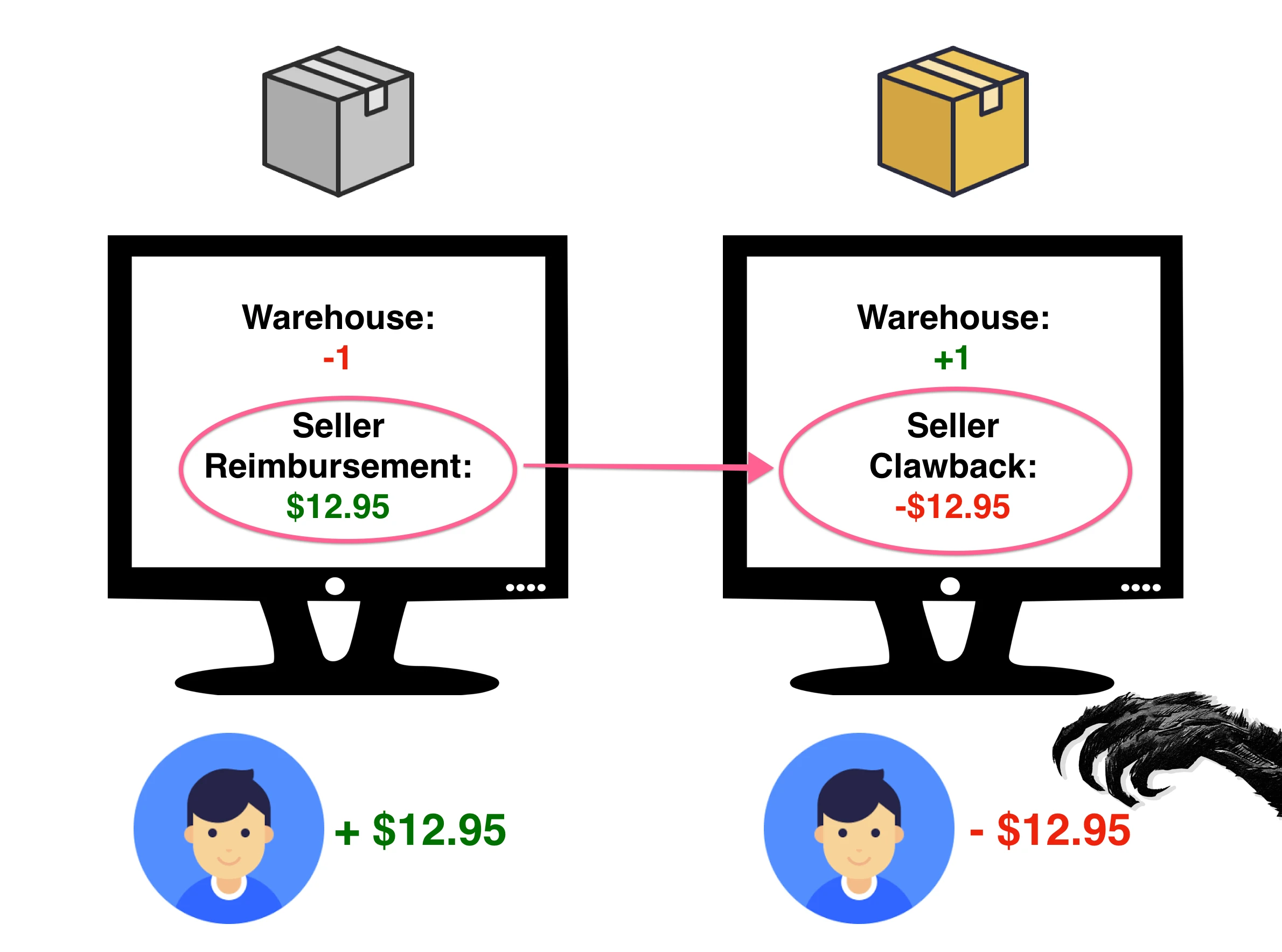
You could just watch this video I recorded about Amazon Clawbacks, instead of reading this section:
Here's a typical clawback event story:
Step 1. Amazon warehouse loses or damages your product, so they issue you a reimbursement to compensate for it. It is called FBA Inventory Reimbursement, and it looks like this in Seller Central:
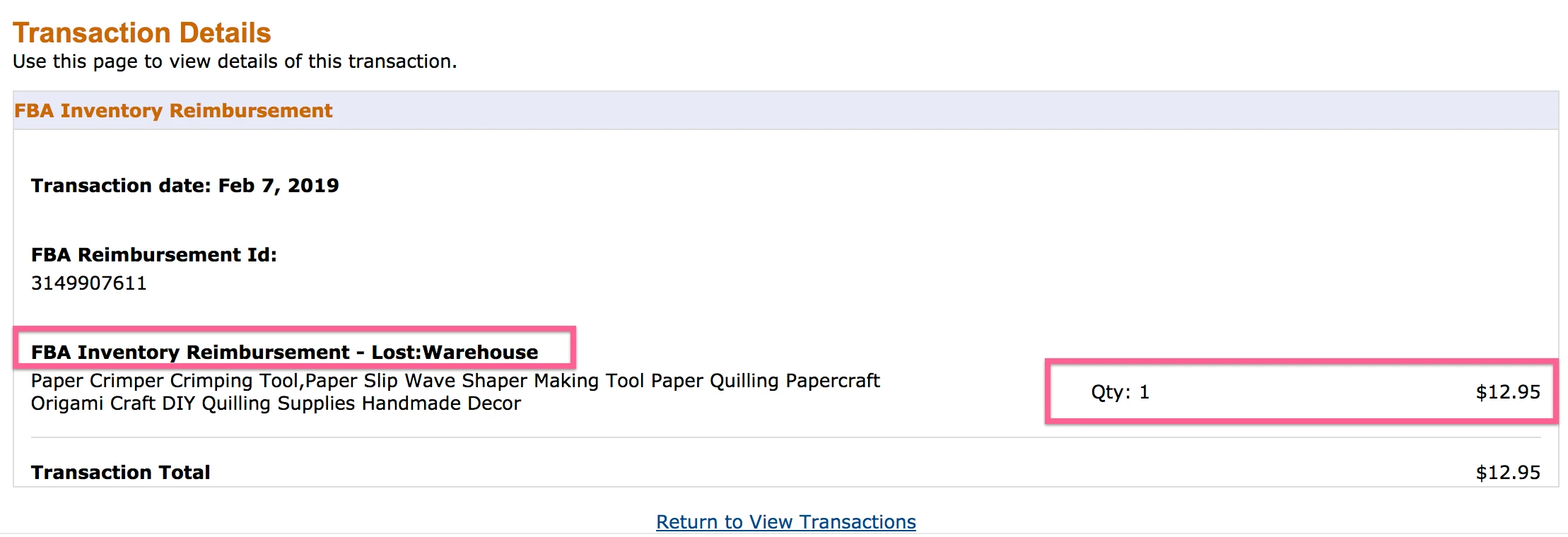
Step 2: Amazon later rediscovers/finds lost item, so they take back ("claw back") the previously reimbursed amount. The Compensated Clawback is recorded as a negative Inventory Reimbursement event (they charge you):
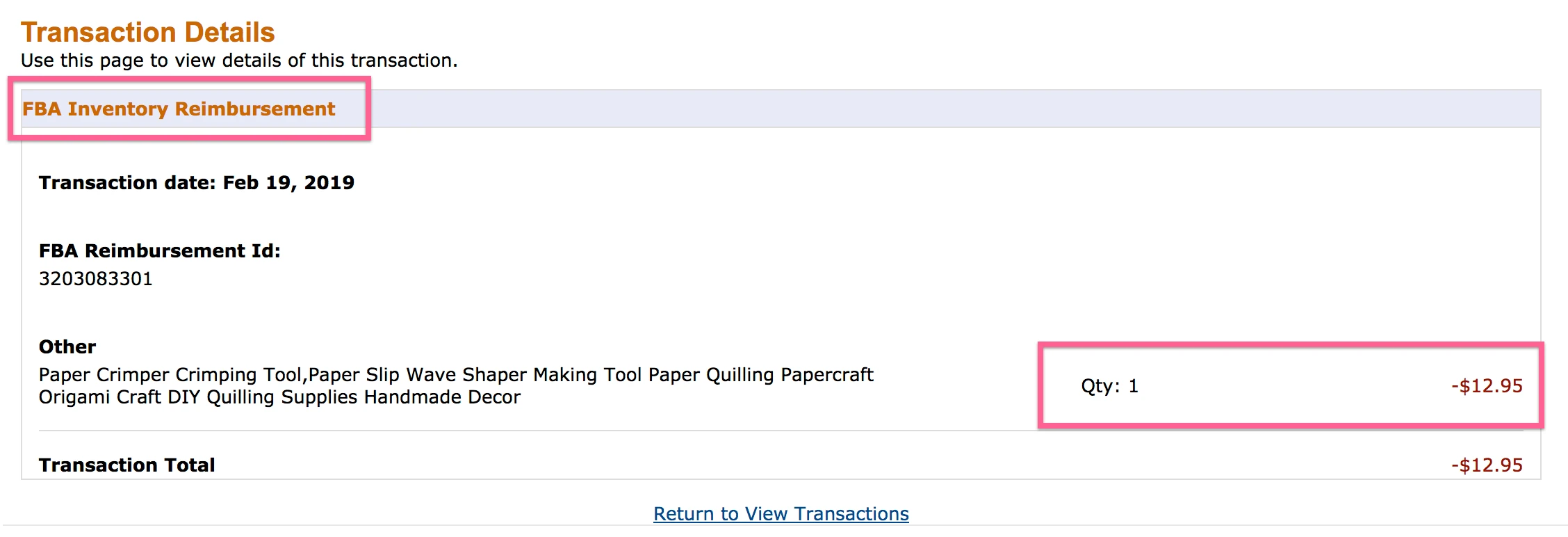
Most likely you will first stumble upon Step 2 transaction in your Transaction reports, and you won't be able to easily track down what was the original reason for the reimbursement and what date it happened.
To find the original event, you will have to go to your Reimbursements Report on Seller Central:
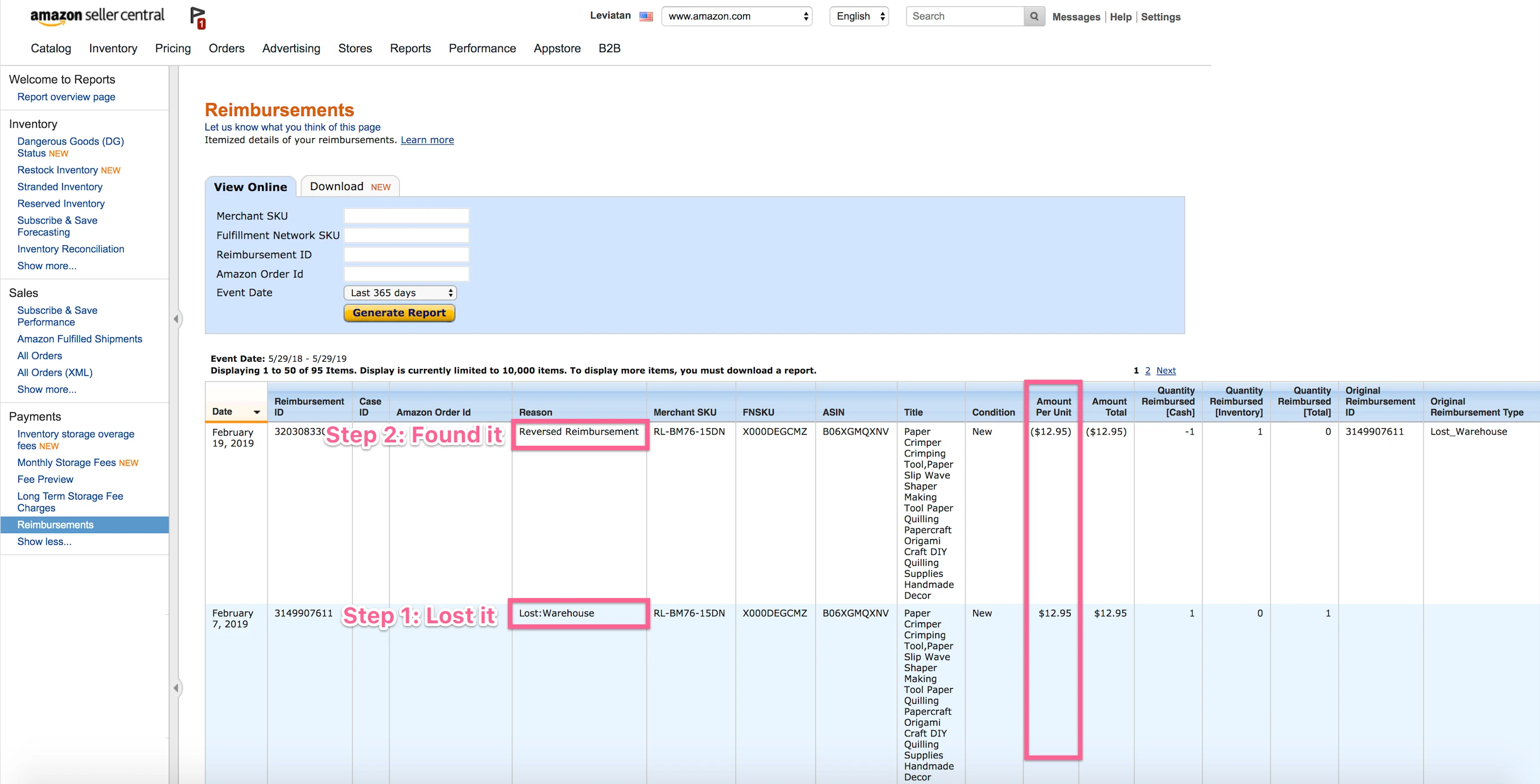
It becomes clear from Reimbursement Report, that the item was lost by the warehouse and 12 days later found again.
Shopkeeper will track both the Reimbursement and the Compensated Clawback, and assign both financial transactions to the affected ASIN:
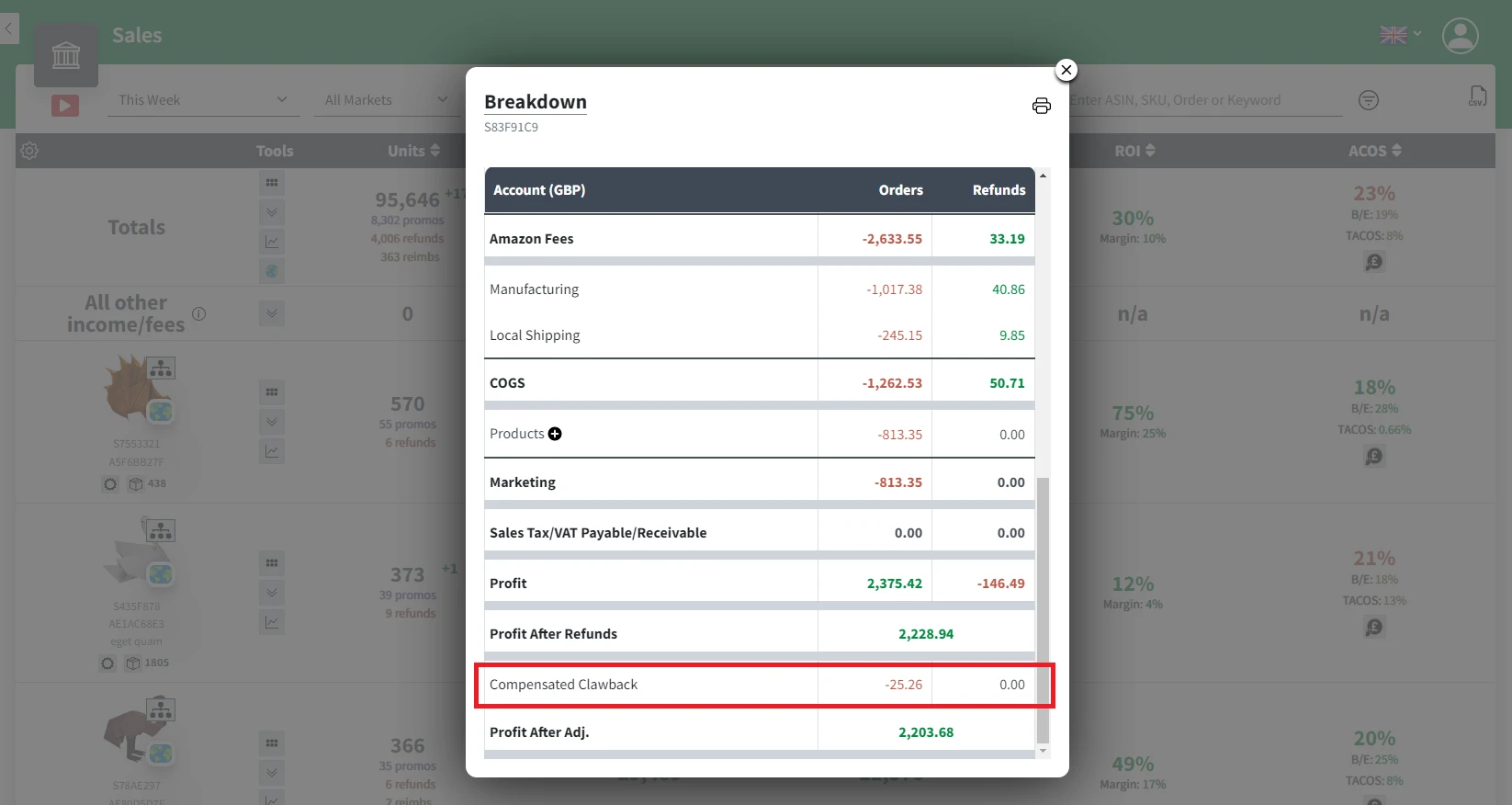
Shopkeeper will also account for the fact that when you lose a unit, you incur Manufacturing and Shipping costs for it.
Let's say your costs for one unit are these:
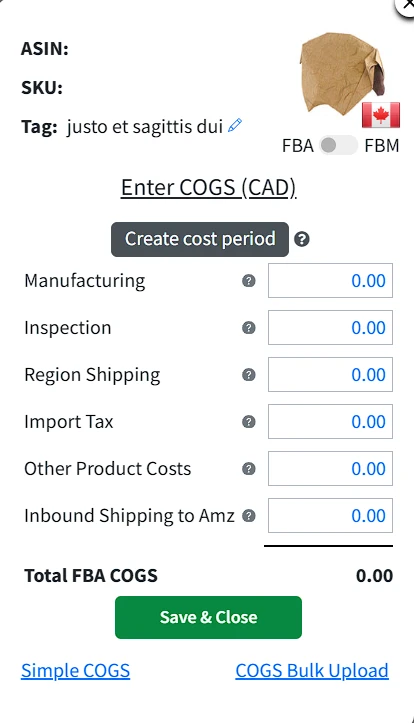
When Amazon loses your item and sends you some money for it to reimburse you, then you want to offset that income with your costs for the lost item - manufacturing, shipping, import tax, etc. Otherwise it would just look like you made 12.95 in profit.
Shopkeeper subtracts your costs for the unit, on the day Amazon loses it:
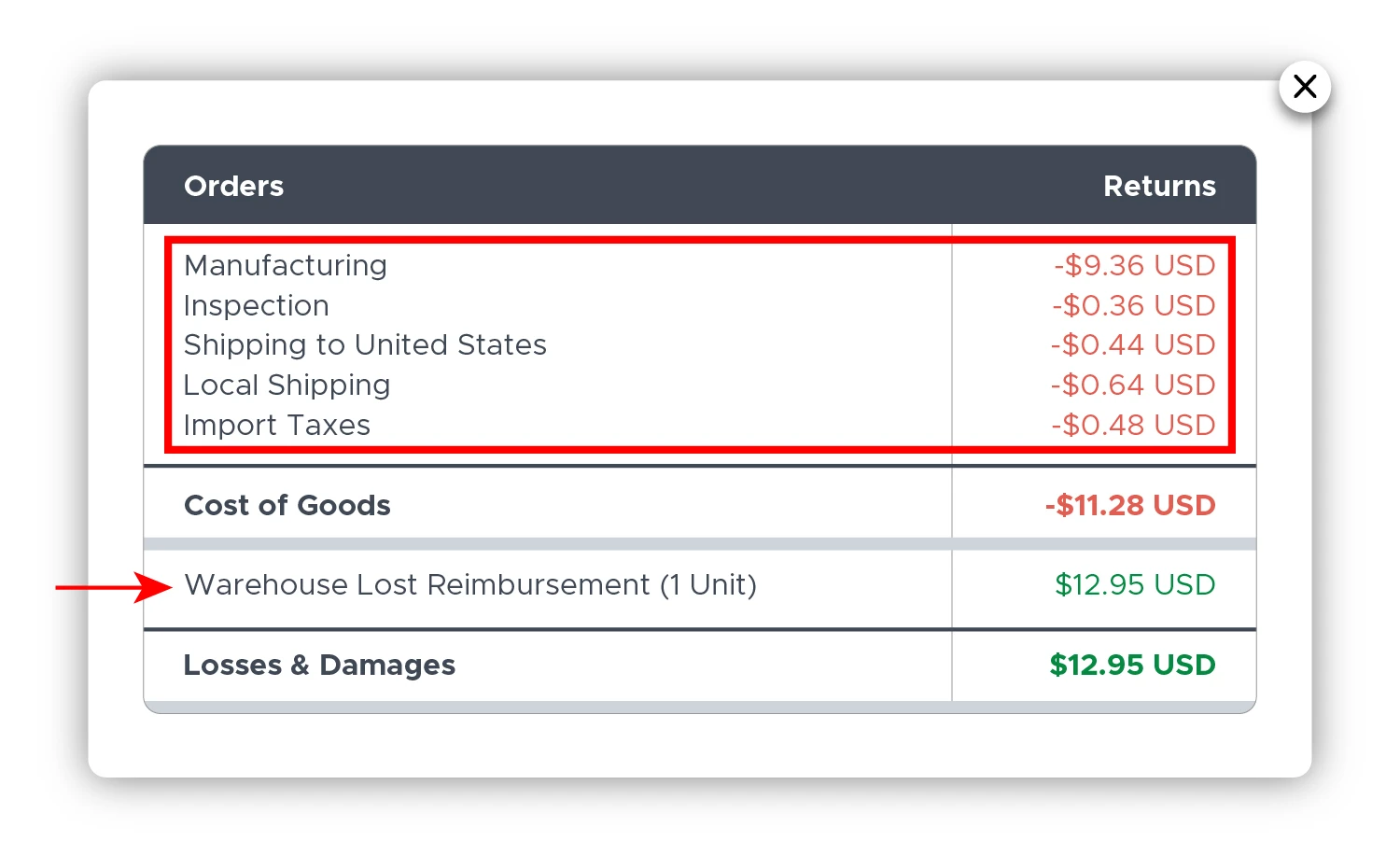
When the clawback is issued and reimbursement gets reversed 12 days later, Shopkeeper puts back the Manufacturing and other custom costs for your product, to your balance.
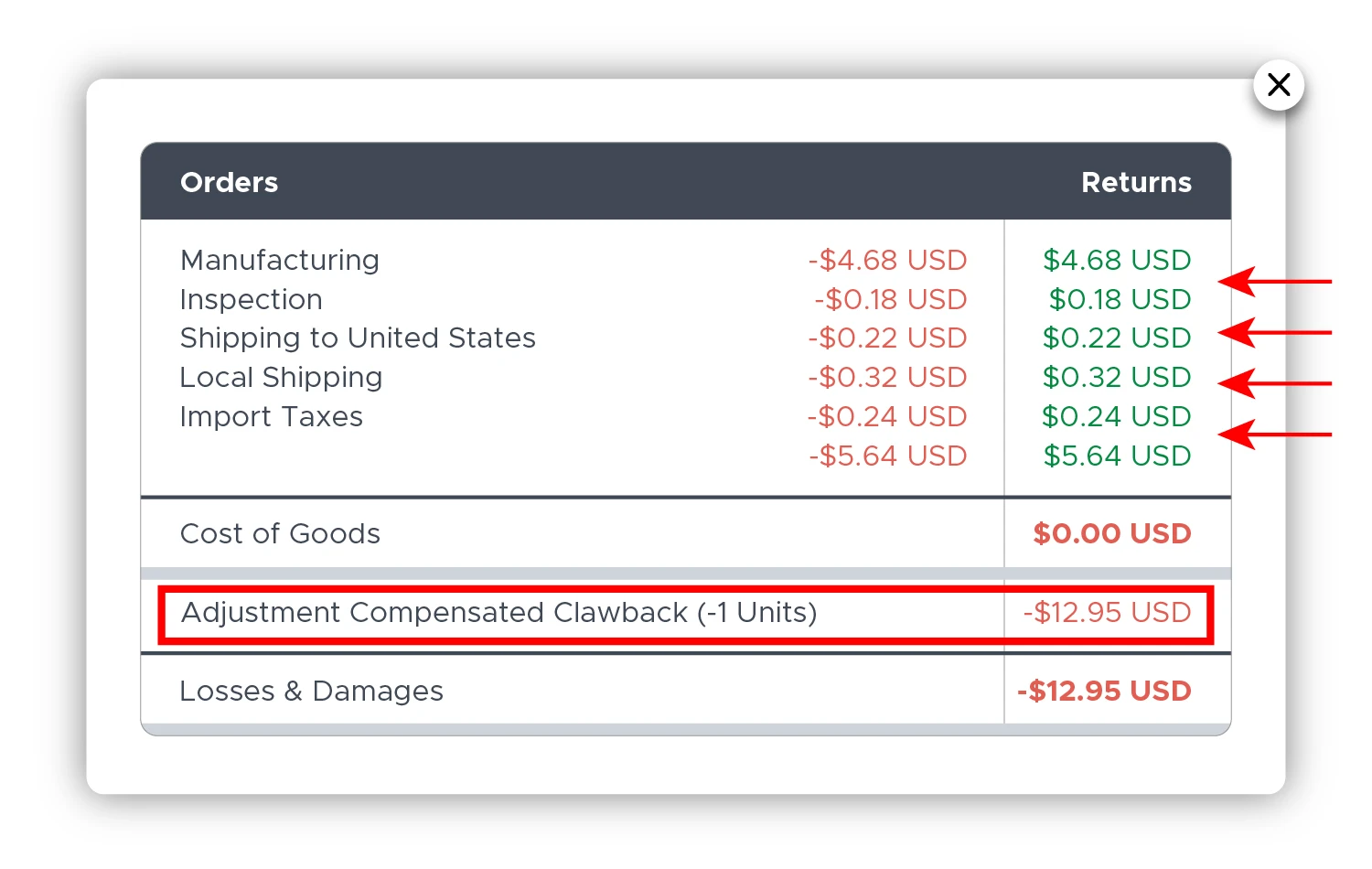
Because Amazon found your lost unit, it means you don't want to actually show the costs yet - the item is still in your warehouse. Manufacturing and other costs of goods will be applied when the next sale comes in or another unit is lost.
Missing from Inbound Clawback is also a Reversal Reimbursement, but applied specifically in cases where a previous reimbursement was issued due to units missing in the inbound delivery process.
For example, if UPS truck was bringing 300 units to Amazon warehouse, but only 200 arrived - Amazon will issue a Reimbursement for 100 units to you. If they later magically find the missing units, Amazon will "claw back" the reimbursed amount from you:
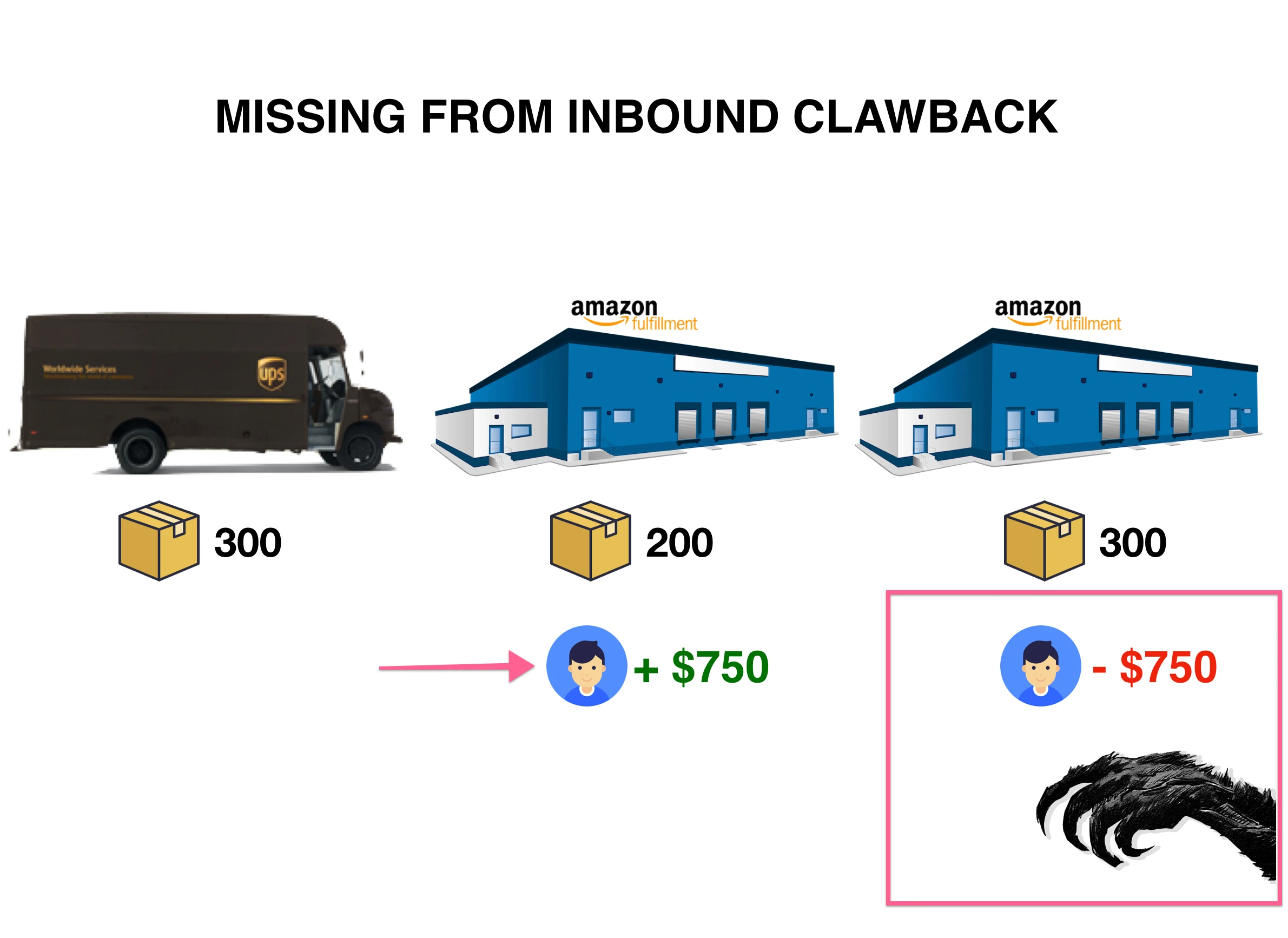
Manage Clawbacks Now
Coupon Redemption Fee
Amazon charges sellers a fee called the CouponRedemptionFee when shoppers use coupons during checkout for discounts. This fee covers the costs of managing coupon redemptions. Amazon charges a $0.60 redemption fee per coupon used. The fee varies based on factors like the product type and discount amount. Sellers should consider this fee when planning prices and promotions. Understanding and budgeting for the Coupon Redemption Fee helps sellers manage costs and make the most of their coupon offers to attract customers and boost sales.
CReturn Wrong Item
| CReturn Wrong item is also called CRETURN_WRONG_ITEM. |
|---|
CRETURN_WRONG_ITEM is a reimbursement, issued to you by Amazon on FBA orders, when a customer returns a wrong item to the Amazon warehouse after a refund.
So basically customer buys a 32GB USB Stick from you, files a refund, and then sends back in the wrong item, for example, 10GB USB Stick instead.
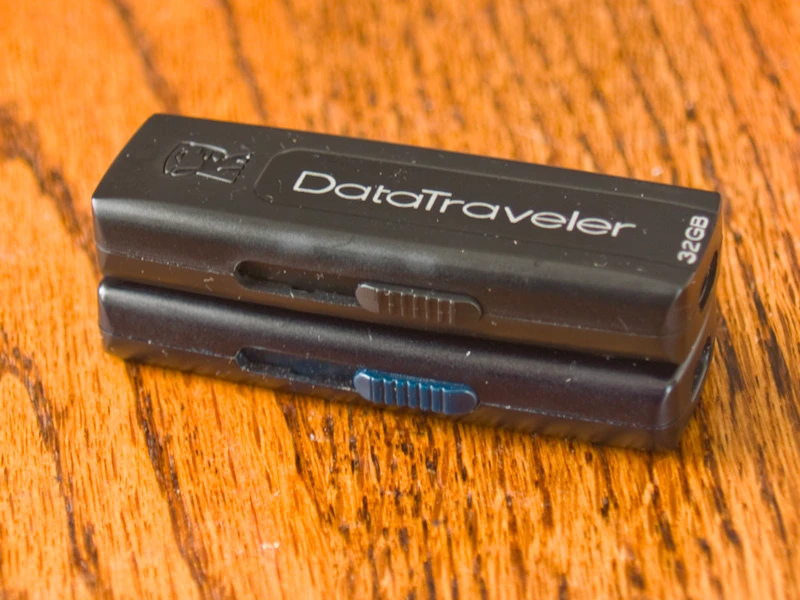
This is similar to normal Inventory Reimbursement, when a customer does not return the item back to Amazon in 45 days. With Inventory Reimbursement, when an item is refunded, but not physically returned to the warehouse in 45 days - Amazon charges your customer and gives you a reimbursement for the item.
The same happens with CReturn Wrong Item Reimbursement. When a customer returns the item back to Amazon, but it's not the item he purchased, Amazon assumes that he did not return the item and charges the customer for it, reimbursing you at the same time.
Here is how you will see CRETURN_WRONG_ITEM reimbursement in Shopkeeper:
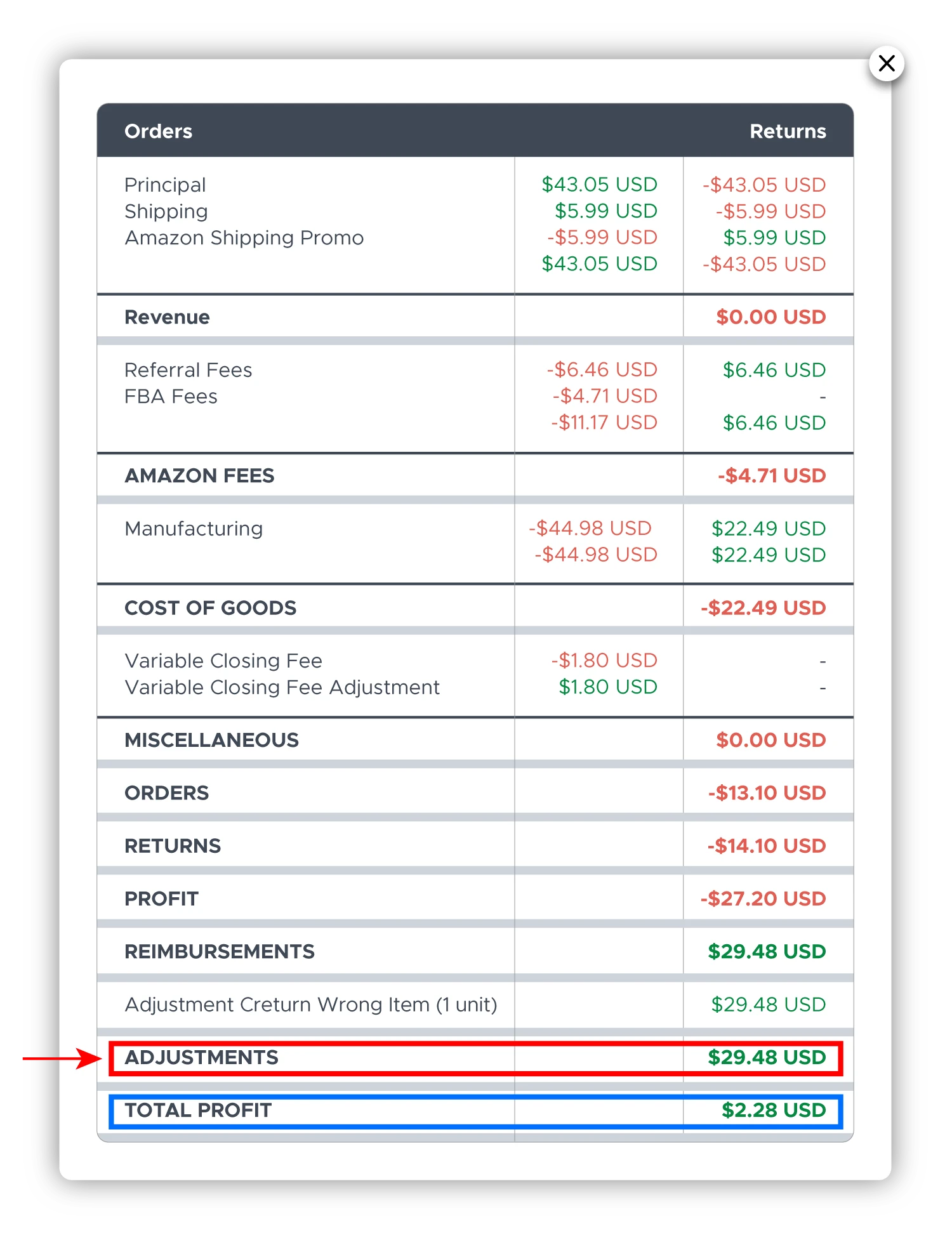
Instead of showing $-27.20 loss due to a refund, Shopkeeper takes into account Reimbursement for this unit, and shows you total profit of $2.28.
The way Shopkeeper shows it together in one view, lets you see a more complete picture of what happened with this particular order. Now you know that each refunded item which is not returned properly, actually makes you $2.28 USD in profit.
You should be happy when customers are Switcheroos or Forgetfuls. Amazon charges them and you recoup some money from a refund, when normally you would be just losing money.

CReturn Wrong Item reimbursement is only issued automatically on AFN (Amazon-fulfilled) orders. That is, only when Amazon is the one handling the returns.
If your order was MFN (Merchant-fulfilled), then you will have to file a SAFE-T claim, to get a similar reimbursement.
Note: this is an article in Progress, another 49 fees to be added in the next two months.
CSBA Fee
The CSBAFee is a fee charged to Amazon sellers for customer service support, which helps to ensure that customers receive timely and professional assistance. If a seller chooses to conduct customer service through Amazon and incurs fees connected with managing returns or resolving customer inquiries, the CSBAFee will cover these costs. For example, if a consumer complains about a purchase and Amazon resolves it on the seller's behalf, the CSBAFee will be deducted from the seller's account.
CS Error Items
| CS Error Items is also called CS_ERROR_ITEMS, CS_ERROR_NON_ITEMIZED, CSErrorNonItemized |
|---|
This is an error adjustment, related to or performed by customer service department.
Most often it's a positive deposit to your account, made after Amazon overcharges you on something. To correct previous charges, they issue a deposit to you which shows up in Other transactions:

Sometimes an order-id is associated with it, and sometimes it is not.
Shopkeeper shows this adjustment either on a particular order-id, like this:
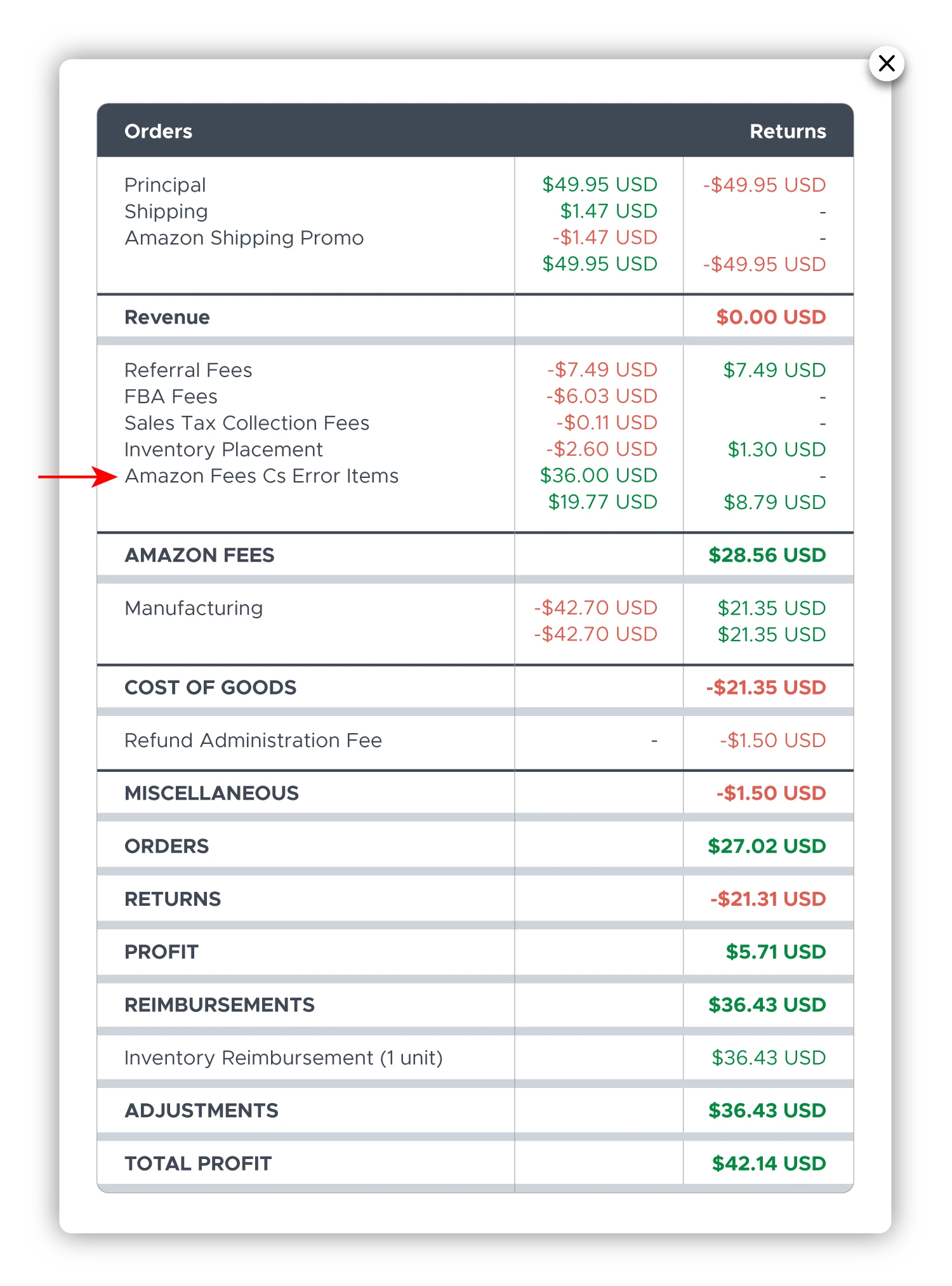
..or on the ASIN on the day that it was charged:
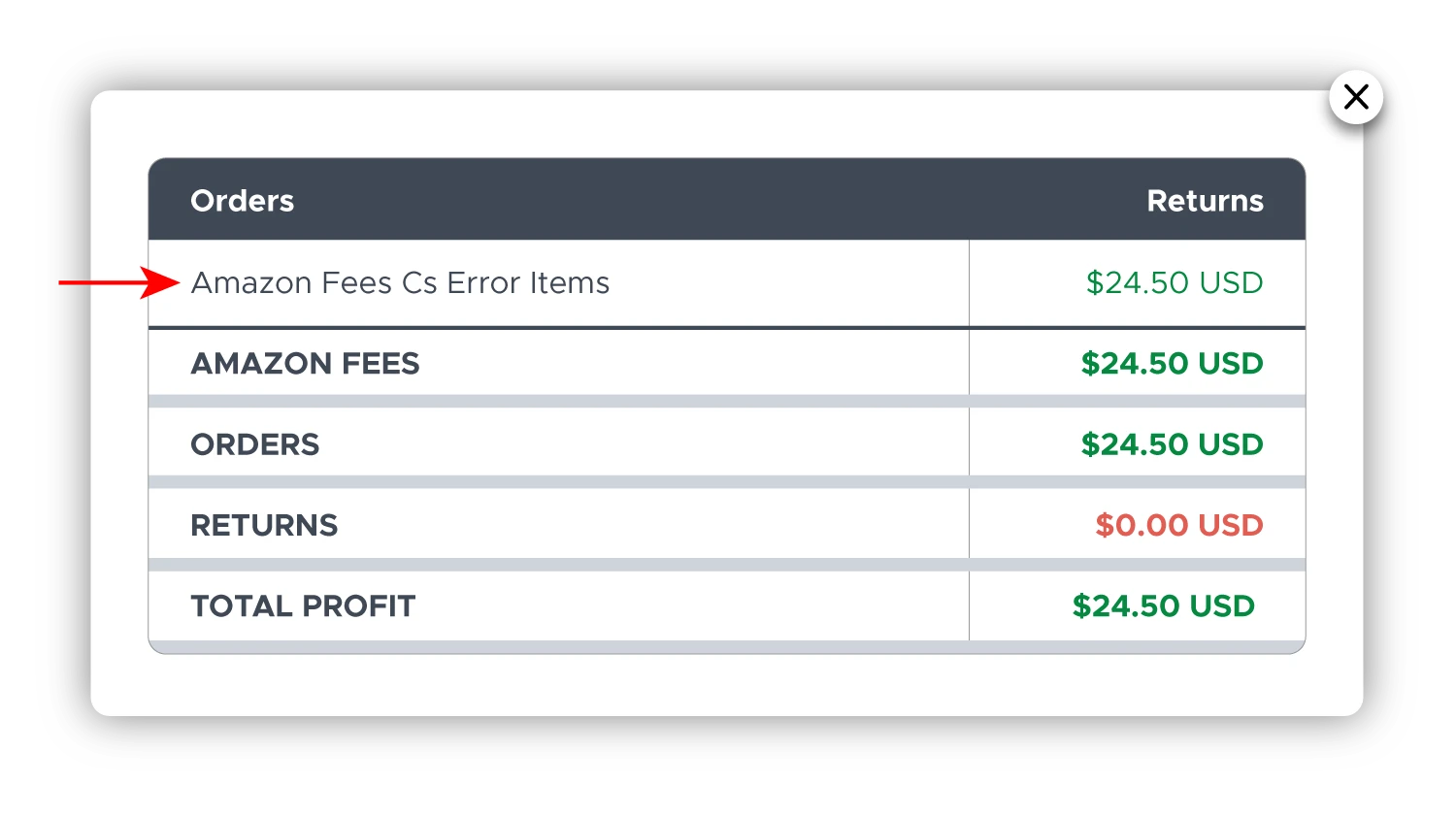
Even if a product had no sales on that day, Shopkeeper will still show all financial activity that happened during that day and is related to that product. For example, here, Amazon Seller Fees were adjusted in a CS Error Items transaction.
Customer Return HRR Unit Fee
CustomerReturnHRRUnitFee is charged when a customer returns a High Return Rate (HRR) unit fulfilled by Amazon. It helps cover the processing, inspection, and reintegration of returned items back into inventory.
FBA Customer Return Per Order Fee
FBACustomerReturnPerOrderFee is incurred when a consumer returns an item delivered by FBA. It often applies to goods categories that provide free returns, such as clothing and shoes. The fee is per returned order, which means that each time a buyer returns a product fulfilled by Amazon, the seller is paid a fee for processing the return.
FBA Customer Return Per Unit Fee
When a customer returns an item, sellers are charged a FBACustomerReturnPerUnitFee. The seller's account balance is debited for this fee, which is applied on a per-unit basis. It includes a range of expenses associated with handling returned goods, such as inspection, possible repackaging, and restocking. The particular cost of the fee may change based on things like the type of product being returned and how it was in when it got to Amazon's fulfillment center. This charge should be taken into account by sellers when analyzing their total cost of operations and profitability on the marketplace.
See How Return Fees Impact Your Profits
FBA Customer Return Weight Based Fee
FBACustomerReturnWeightBasedFee is a fee based on the weight of an item returned by a customer under the FBA program. It reflects the cost of return shipping and restocking services for heavier or oversized products.
Debt Adjustment
Debt Adjustment refers to the process where Amazon corrects any errors or discrepancies in a seller's account balance. This could happen for various reasons, such as refunds given to customers, reimbursements for lost or damaged items, adjustments for fees, or fixing overpayments or underpayments.
Amazon regularly checks accounts to make sure all financial transactions between sellers and the platform are accurate. Debt adjustments may show up on a seller's account statement as changes to balance out any mistakes that occur while doing business on Amazon. For more specific information about debt adjustments, sellers should contact Amazon's seller support or refer to their financial documents.
Delivery Fulfillment Fee
The charge that sellers pay to pick, package, and send goods to buyers is known as the Delivery Fulfillment Fee. The cost of Fulfilment by Amazon (FBA) is determined on the item's dimensions, weight, and delivery time. Seller Fulfilled Prime allows sellers to meet Prime delivery requirements while paying for their own shipping. This charge guarantees that the logistics of delivering goods to clients are controlled.
FBA Delivery Services Fee
FBADeliveryServicesFee is the amount for transporting the product to the consumer, which includes packing, handling, and shipping. It depends on the item's size and weight. For a modest item, like a book, the delivery charge could be roughly $3. For a larger, heavier item, such as a microwave, the price could be $10 or higher.
Digital Services Fee
Amazon charges DigitalServicesFee for providing digital services, typically applied to the sale of digital goods or media. It helps support the infrastructure needed to deliver digital content like eBooks, software, and media files.
Digital Services Fee FBA
DigitalServicesFeeFBA is a digital services fee applied specifically to products fulfilled by Amazon (FBA). It supports the delivery of digital functionality or services tied to the FBA-distributed product.
Disbursement Correction
DisbursementCorrection is an adjustment made to a prior payment to fix errors, account for refunds, or correct miscalculated fees. For example, if Amazon paid a seller $500 initially but subsequently found out that $30 should have been taken for a returned item, they will make this right by deducting $30 from the seller's subsequent payment.
FBA Disposal Fee
When Amazon handles the disposal of your FBA goods, you'll be charged a FBADisposalFee. This fee includes the costs associated with managing and getting rid of inventory that can't be resold, like damaged, expired, or unsuitable items. The specific fee amount varies based on the size and weight of the item being disposed of.
Calculate Your FBA Fees
EPR Pay on Behalf Eco-contribution - EEE
This is an eco-contribution fee Amazon collects and pays on your behalf for Electrical and Electronic Equipment (EEE) sold in regions where EPR regulations apply (e.g., France, Germany).
The fee supports proper recycling and disposal of electronic products.
It’s based on the product type, weight, and local EPR rules.
EPR Pay on Behalf Eco-contribution - Toys
This fee is similar but applies specifically to toys under EPR regulations.
Amazon handles the registration and reporting and charges sellers a fee to cover the required eco-contributions.
The goal is to ensure proper end-of-life management (e.g., recycling) of toy products.
EPR Pay on Behalf Service Fee - EEE
This is a service fee Amazon collects for managing Extended Producer Responsibility (EPR) compliance for electrical and electronic equipment (EEE). It covers administrative efforts Amazon undertakes to report and remit eco-contributions on behalf of sellers in regulated markets.
EPR Pay on Behalf Service Fee - Toys
This fee supports Amazon’s management of Extended Producer Responsibility (EPR) obligations for toy products. It includes compliance services for reporting, registering, and submitting environmental fees in jurisdictions where required.
EPSO Chargeback Fee
EPSO stands for "European Payment Services Organization." This group handles payment services and fees on Amazon's European sites. If a transaction is disputed and reversed due to a chargeback, the EPSOChargebackFee is charged. This fee covers the costs of managing and resolving the dispute.
EPSO Cross-Border Fee
The EPSOCrossBorderFee is imposed for transactions involving multiple nations or regions. It covers the additional costs associated with processing foreign transactions, such as currency conversion and regulatory compliance.
EPSO Payment Auth Fee On Finalize
EPSOPaymentAuthFeeOnFinalize takes place when Amazon verifies that there are sufficient funds to finish the transaction and the buyer's payment method—such as a credit card—is validated. Once the payment method has been approved, a fee is applied to cover the cost of the verification process.
EPSO Payment Settle Fee On Finalize
EPSOPaymentSettleFeeOnFinalize charged by Amazon when the transaction is completed and funds are transferred from the buyer's account to the seller's account. This process is called "settlement." It takes place when Amazon transfers the payment and the order has been fulfilled. This charge pays for the expenses associated with handling the payment and ensuring that the seller receives the money.
Estimated Commission
EstimatedCommission is the fee charged by Amazon for facilitating the sale of goods on their marketplace. It is typically a proportion of the product's selling price, which varies by category. This charge is also known as a referral fee because Amazon directs the buyer to your listing. The proportion can range from 6% to 45%, depending on the type of item sold, with the majority of categories ranging between 8% and 15%.
For example, if you're selling a laptop in the Electronics category and Amazon's referral fee is 8%, selling a laptop for $100 will result in an Estimated Commission of $8. So, out of the $100 sale, Amazon receives $8 in compensation for hosting the listing and connecting you with the customer.
Estimated FBA Fees
When using Fulfillment by Amazon (FBA), Amazon charges fees for storing, packaging, shipping, handling, and customer service related to your product. EstimatedFBAFees are determined based on the size, weight, and duration your product remains in Amazon's warehouse. Larger or heavier items incur higher fees, while smaller, lighter items have lower charges. For returnable products, FBA fees also include the cost of processing returns.
For instance, if you sell a phone case, a small, standard-sized item, the FBA fee might be around $3.50. Thus, when you sell the phone case for $100, Amazon will deduct $3.50 to cover fulfillment costs, including picking, packing, and shipping the item.
Calculate FBA Fees
Estimated Principal
EstimatedPrincipal is the product's gross retail price before fees and taxes are deducted. This is effectively the total price the buyer pays for the product, excluding shipping, handling, and taxes. It is the "principal" or core portion of the transaction that the seller earns before Amazon charges fees.
If a buyer pays $100 for your product, the Estimated Principal will be $100. This amount does not include any further deductions, such as taxes or Amazon fees. This value shows the amount that the customer has agreed to pay for the item.
Estimated Tax
EstimatedTax is the sales tax that Amazon collects from buyers on behalf of the vendor. Sales tax rates vary according to the buyer's location and the local tax rules in their state or country. Sellers using Amazon Marketplace Tax Collection (MTC) can have Amazon compute and collect the tax at checkout, then remit it to the relevant tax body. The seller often does not handle these funds directly, but they are shown as part of the transaction.
Let’s say, if you sell a product for $100 and the buyer lives in a state with a 7% sales tax, Amazon will charge $7 in taxes. So the buyer pays a total of $107, but you only receive $100 (less Amazon's costs). The additional $7 is collected by Amazon and remitted to the government. Amazon collects the $7 tax, which is then paid directly to the local tax authorities rather than the seller.
Excess inventory
This fee is applied when a seller holds unsold or slow-moving inventory in Amazon’s fulfillment centers beyond optimal levels. It incentivizes sellers to manage inventory more efficiently and avoid unnecessary storage usage.
Export Charge
ExportCharge is any of the several fees that come with sending goods from vendors to buyers in other nations. Higher international transportation costs than domestic shipments are one example of this, as are any customs fees and taxes levied by the destination nation, which can differ according to the kind and value of the product. Sellers may also be charged handling costs for ordering from overseas and currency conversion fees if transactions are made in different currencies. Managing these fees and making sure that foreign shipping laws are followed are frequently the sellers' responsibilities, depending on the selling model. When selling internationally, sellers must take into account the various expenses associated with exporting goods, which are collectively referred to as export charges.
Failed Disbursement
When a payment distribution to a seller is unsuccessful, Amazon refers to the situation as a FailedDisbursement. This usually happens when there are problems with the bank account details that have been submitted, including an incorrect account number or routing number, or when there are other barriers impeding the transfer of money.
If a disbursement fails, Amazon tries to process the payment more than once. Every failed attempt is recorded under the FailedDisbursement category. To help with settlement and to keep track of past payment problems, these attempts are documented.
Sellers should take immediate action to resolve any problems that are preventing payments from being made, such as updating their bank account details or settling any unresolved disputes with their financial institution. They can guarantee seamless and fast.
FBA001 Auto
An automated FBA fulfillment fee that covers picking, packing, and shipping of orders. It is typically generated for standard orders processed through Amazon's Fulfillment by Amazon service.
FBA Fee
| FBA Fee is also called Fulfillment by Amazon Fee, FBA Pick & Pack Fee, FBAPerOrderFulfillmentFee, FBAPerUnitFulfillmentFee, FBAWeightBasedFee |
|---|
FBA stands for Fulfilment by Amazon. You pay an FBA fee if you store your products at Amazon warehouse and Amazon ships them to your customers for you. This includes shipping, refund management & support, inventory pick & pack, stocking, counting, delivering, loading etc.

FBA fee constantly keeps changing, mostly increasing. It's now roughly 2.50-5.50 USD per small item.
You can check current FBA fees here:
FBA Fees for Amazon North America
Check Your FBA Fee Breakdown
FBA Per Order Fulfillment Fee
FBAPerOrderFulfillmentFee is a flat fee charged per order fulfilled through Amazon’s FBA network. It covers the handling, packaging, and delivery of items regardless of quantity in the order.
FBA Per Unit Fulfillment Fee
FBAPerUnitFulfillmentFee applies per individual unit fulfilled by Amazon under the FBA service. It accounts for the operational costs associated with picking, packing, and shipping each item.
Fee Adjustment
Any change to the fees a seller pays Amazon is usually referred to as a FeeAdjustment charge on Amazon. This can occur for a number of reasons, including adjustments to past payments, modifications to service costs, or modifications pertaining to refunds or incentives. In essence, it is a method by which Amazon reconciles fees in response to modifications or additions to a seller's account or transactions. A fee adjustment typically means that the fees you were initially charged have changed.
Free Replacement Refund Items
FREE_REPLACEMENT_REFUND_ITEMS is used to monitor customer support actions when customers receive a free replacement or a refund for an item because of problems such as damage, flaws, or non-delivery.
Although it's not a direct charge, sellers may still be affected financially. If Amazon offers a customer a refund or replacement, the seller may have to pay the cost of the item out of their account. However, in certain circumstances, particularly when Amazon bears the responsibility (e.g., through Fulfillment by Amazon or FBA), sellers may receive reimbursement for these reimbursements or replacements.
Generic Deduction
GenericDeduction is applied to a seller's account and is frequently associated with other charges like refunds, special offers, or balance adjustments that have an effect on the seller's total. It helps guarantee correct charge charging and lowers the seller's overall earnings or balance. Sellers can check their account statements or get in touch with Amazon Seller Support with particular inquiries.
Get Paid Faster Fee
GetPaidFasterFee is a fee charged to sellers who choose to receive payments faster than the regular payment schedule. For example, if a seller prefers to be paid sooner for their sales rather than wait for the standard payout time, they can select this option, and Amazon will charge an extra fee for the faster payment service. This fee is deducted from the seller's earnings in exchange for quicker access to the funds.
Gift Wrap Charge
| Gift Wrap Charge is also called gift-wrap-price. |
|---|
Gift wrap charge is a fee your customers pay to get their purchased products wrapped in gift paper and have a card sent with it as well.
To have the Gift Wrap option enabled on your listings, you have to select these checkboxes in Seller Central:
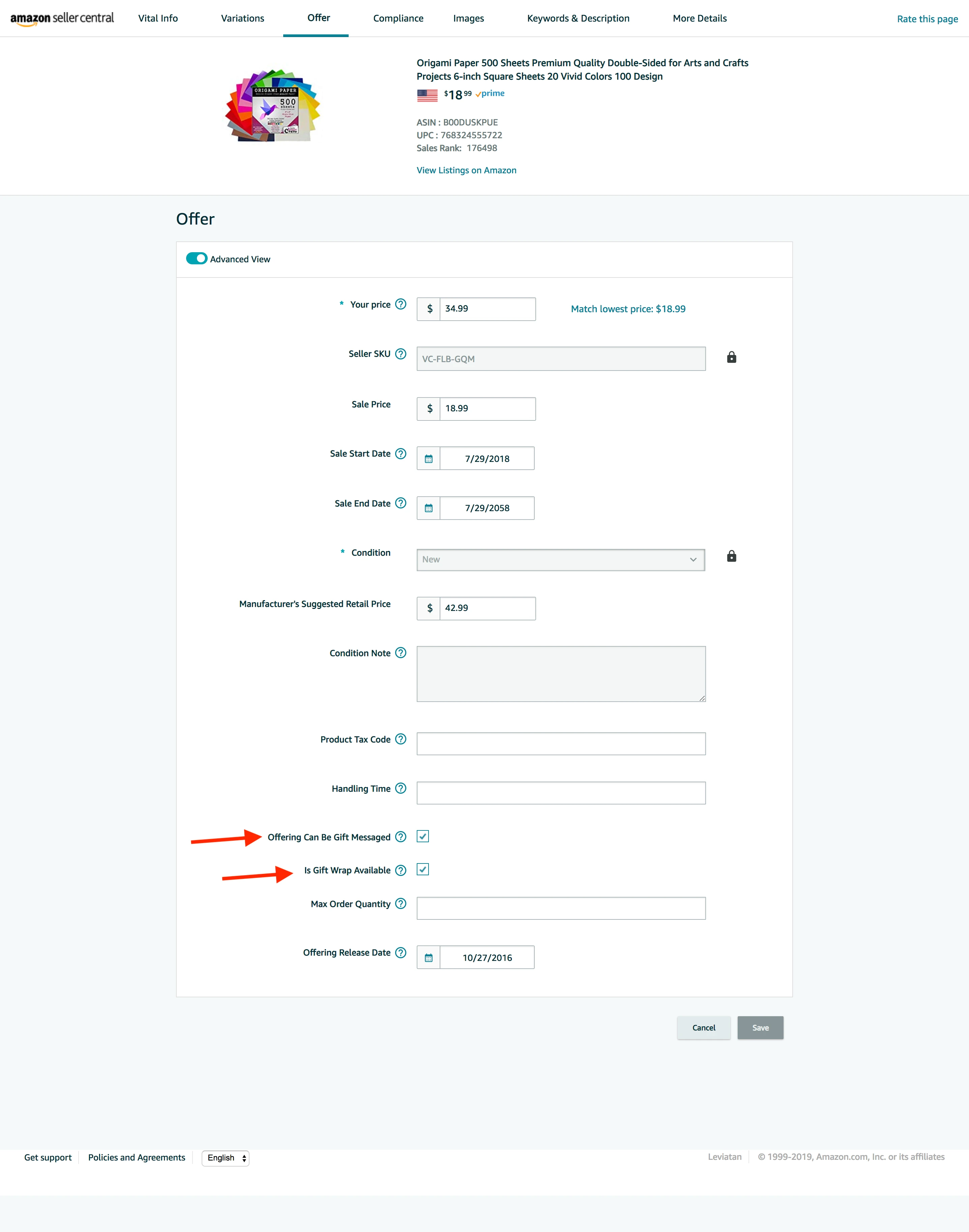
That way the buyers can see Gift Options when checking out:
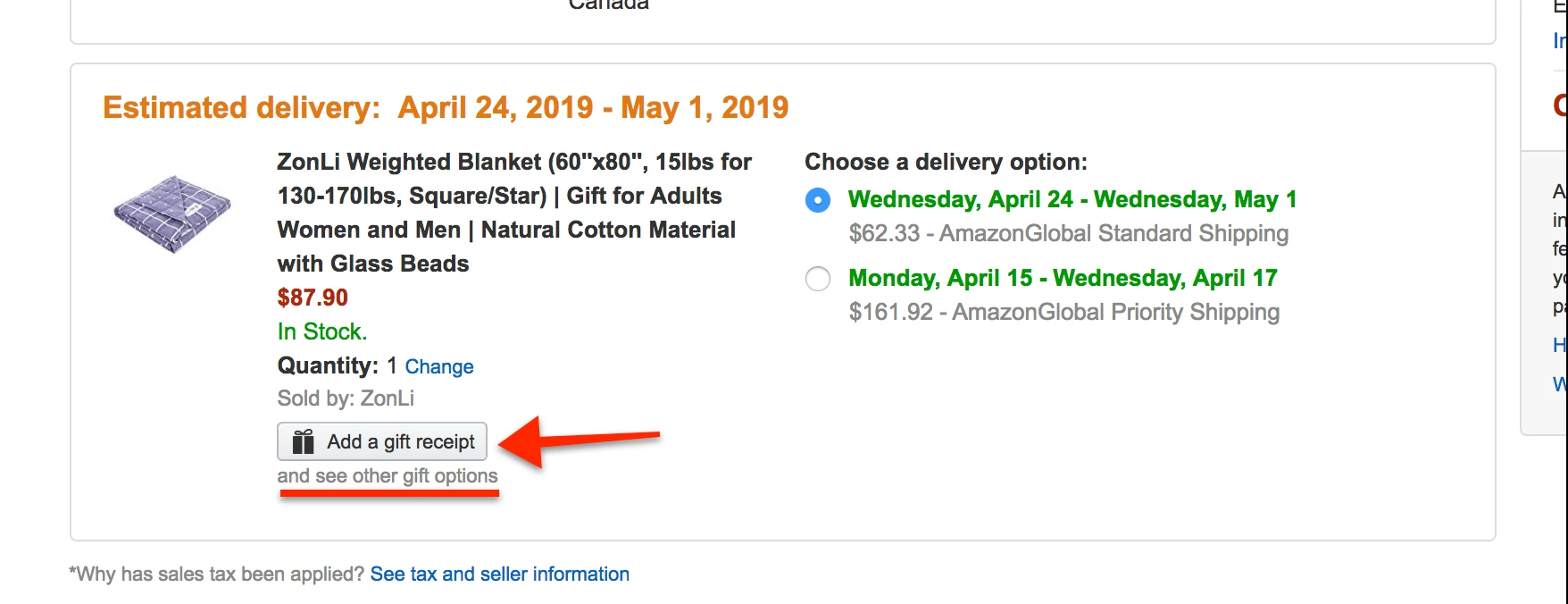
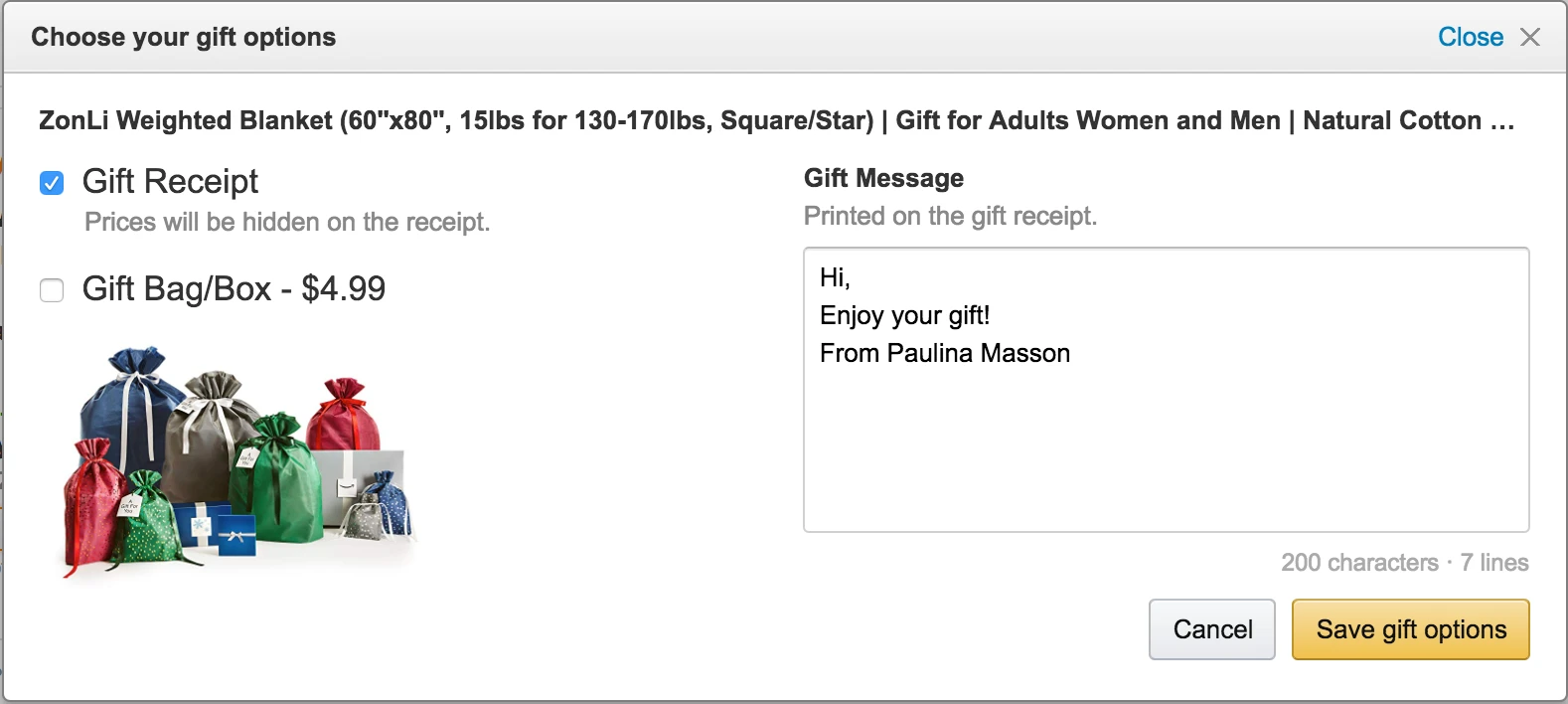
You may ask, ok, but who is doing the actual gift wrapping?
If your listing is Amazon-fulfilled (FBA), then Amazon does the gift wrapping and they also keep the gift wrap charge. All you need to do is enable the gift wrap options on your listings like above, and it will just automatically become available for your buyers.
If your listing is Merchant-fulfilled, you will be the one doing the gift wrapping. For this option to be fully enabled, you will need to setup a few extra things in your Seller Central. First, go to Settings->Gift Options:
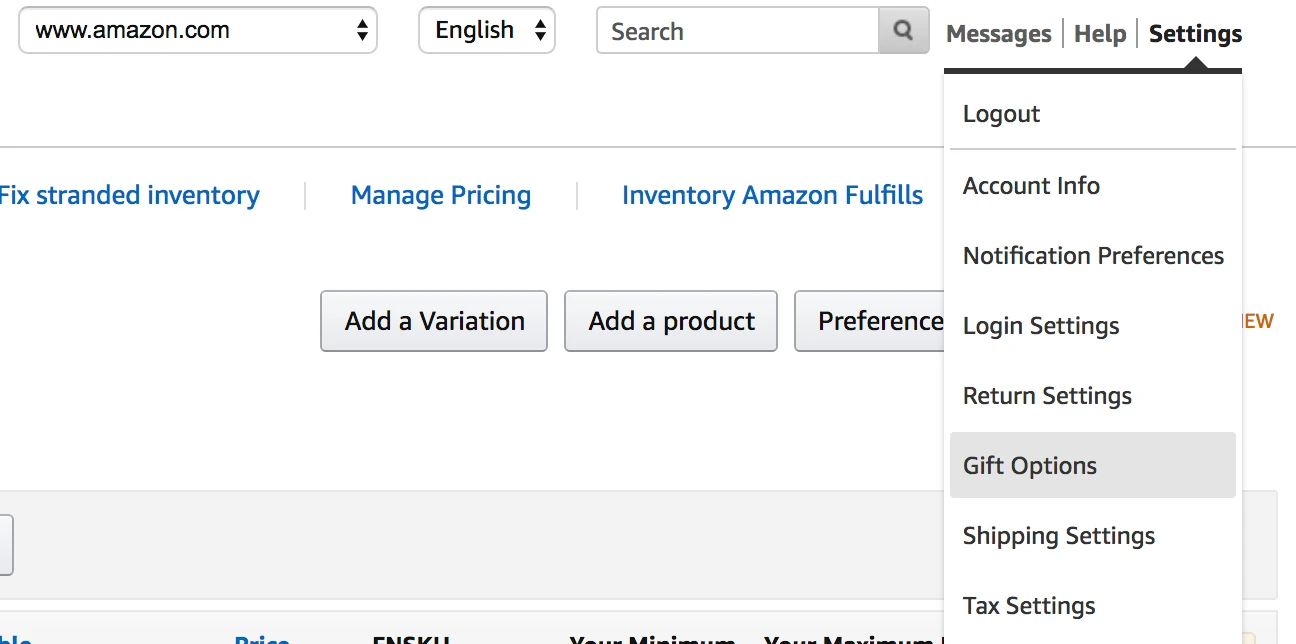
Then, create Gift Wrap options for your customers and set the gift wrap prices:
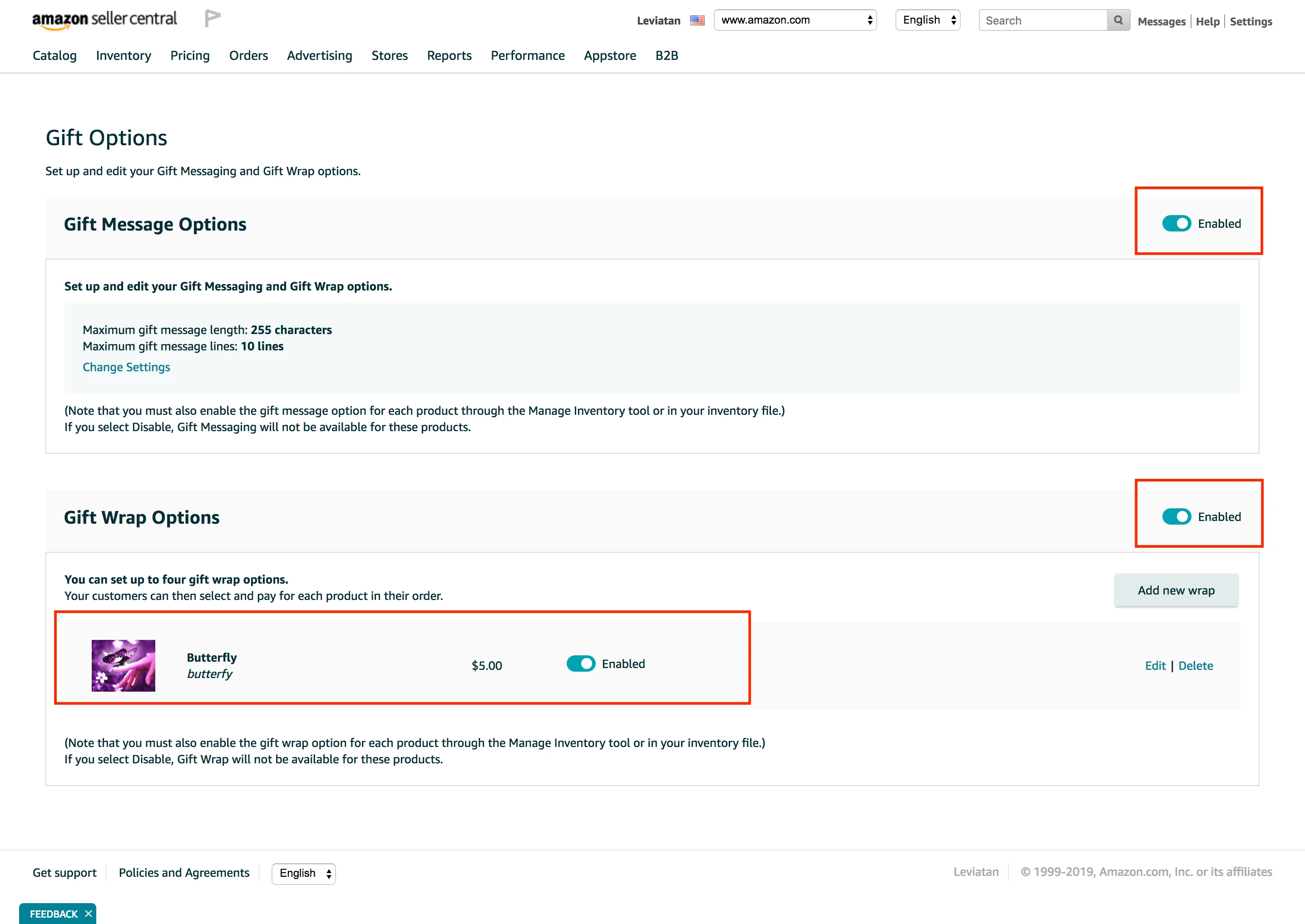
Then your buyers will be presented with your Gift Wrap options, and Amazon will send you all collected Gift Wrap Charges along with your payout.
Review Your Gift Wrap Fees
Gift Wrap Chargeback
| GiftwrapChargeback appears in your transactions together with a Gift Wrap Charge, in cases where Amazon is the one doing the Gift Wrapping. |
|---|
That is, when your listing is FBA (Amazon-Fulfilled), Amazon is collecting a gift wrap charge from your customers and it appears in your transactions as your revenue. But because it's not you who is doing the gift wrapping, Amazon is also adding in a Gift Wrap Chargeback, to immediately take the collected Gift Wrap Charge away from you.
Unfortunately, this inflates your revenue figure:
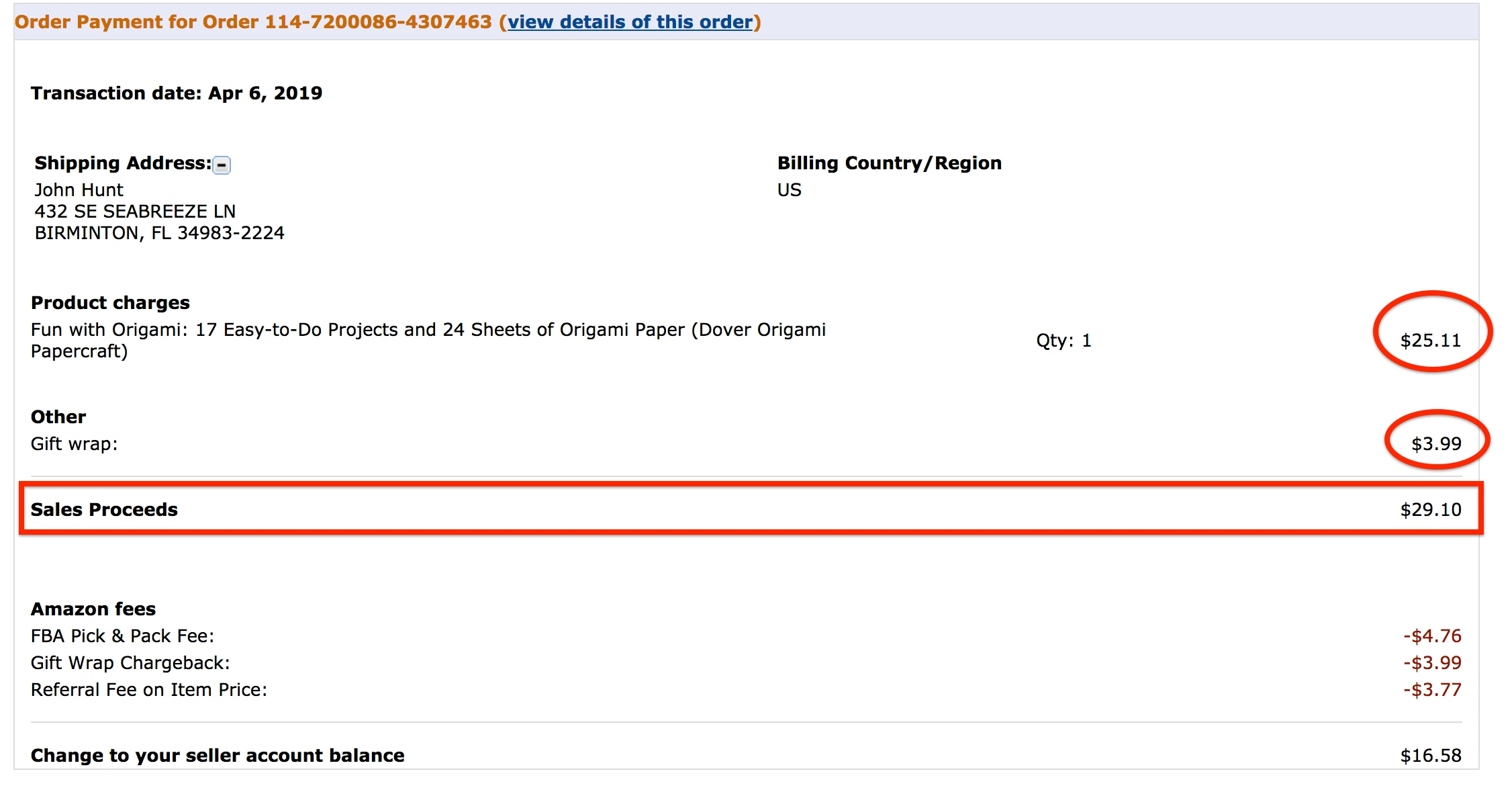
If you want to do a financial analysis, or present your numbers to investors/partners, you shouldn't really use inflated Revenue that Amazon shows in their downloadable reports. It is better to use apps like Shopkeeper, which normalize your revenue, still showing all relevant transactions from Amazon:
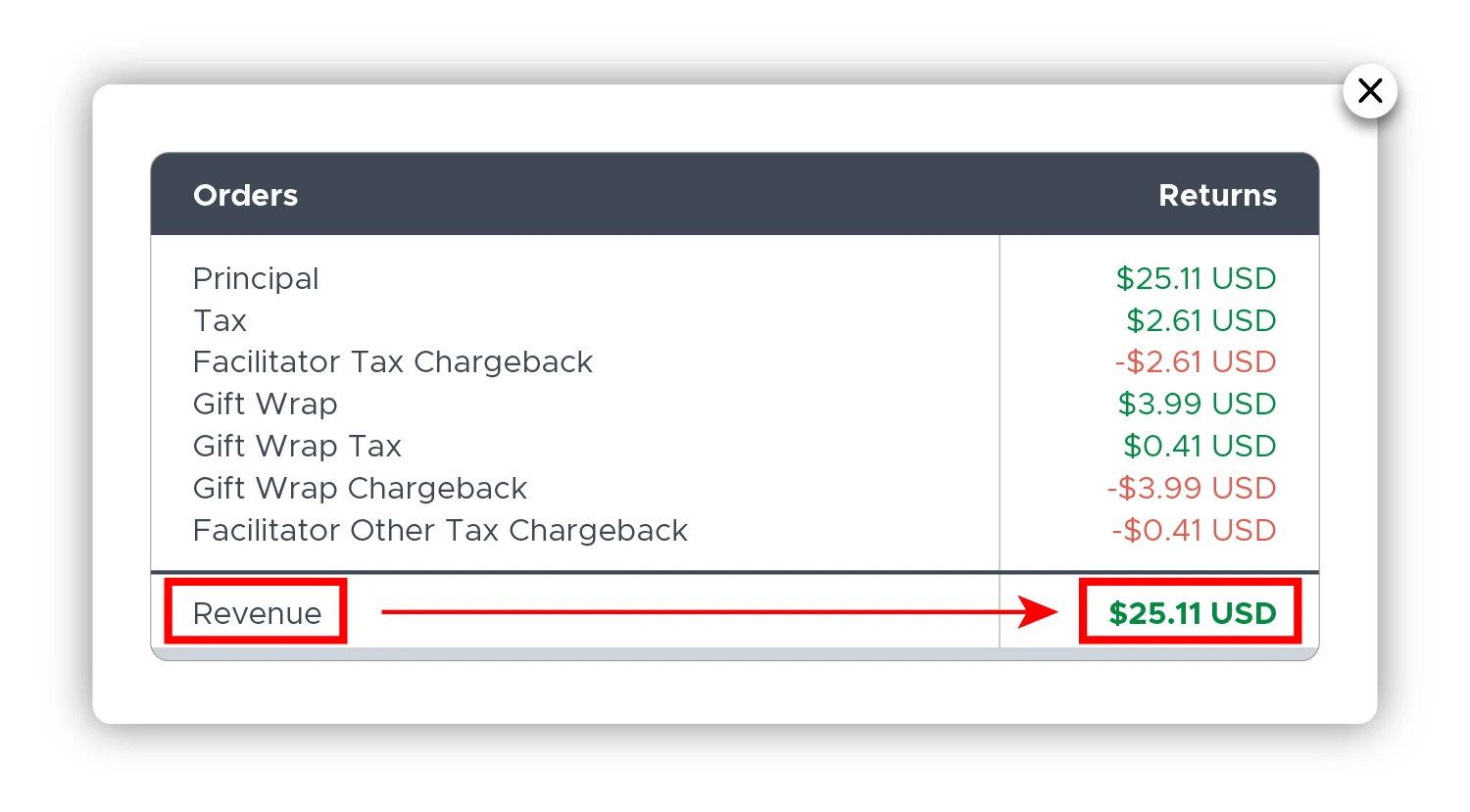
Using inflated revenue directly from Amazon reports can be good and bad. Higher revenue figure means you can appear to be making more money to investors, potential business buyers, your followers, potential hires, etc.
But it can also be bad if you get charged for some things based on revenue. It also adds up to complexity of bookkeeping, and confusion whether you should show gift wrap chargeback as costs, or simply ignore all this math and declare revenue without showing gift wrap activity at all. I recommend showing all like Shopkeeper does, simply because then it’s much easier to follow the numbers from Amazon reports if you keep track of all the same transactions that they do.
In the end, if you’re just a small company, these details don’t matter so much. Just do what is the easiest for you.
Gift Wrap Commission
GiftwrapCommission is basically a referral fee, charged on all gift wrap services that were provided by you, the seller. If Amazon is the one gift-wrapping it, you don't get charged a commission.
Here is how the normal gift wrap commission charge appears in Shopkeeper, when it's fulfilled by you, the Merchant (MFN):
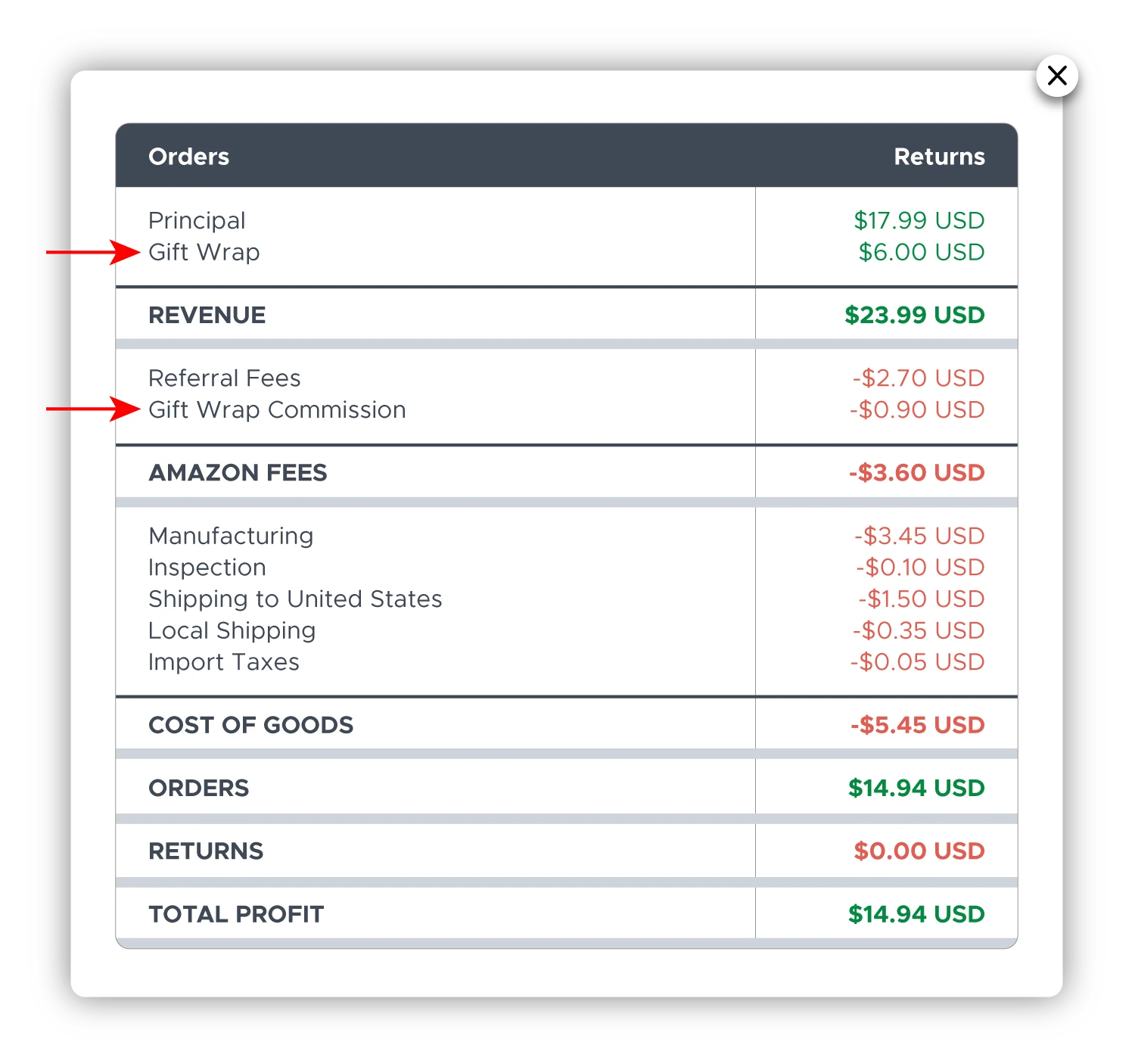
There is one more non-obvious situation, where Amazon charges you Gift Wrap Commission.
If you are running a promo, and offer your customer 100% off (so that the final price that the customer pays is 0.00) - then Amazon charges you a Gift Wrap Commission. AND also a small Referral Fee and Shipping Holdback Fee.
Amazon cannot charge you more than minimum Referral Fee because Referral Fee is based on sales revenue. Now the revenue is 0.00. So they also charge you two other small minimum amounts - Shipping Holdback Fee and Gift Wrap Commission Fee. This is their way to make money out of the zero-amount-sale that happened on their platform:
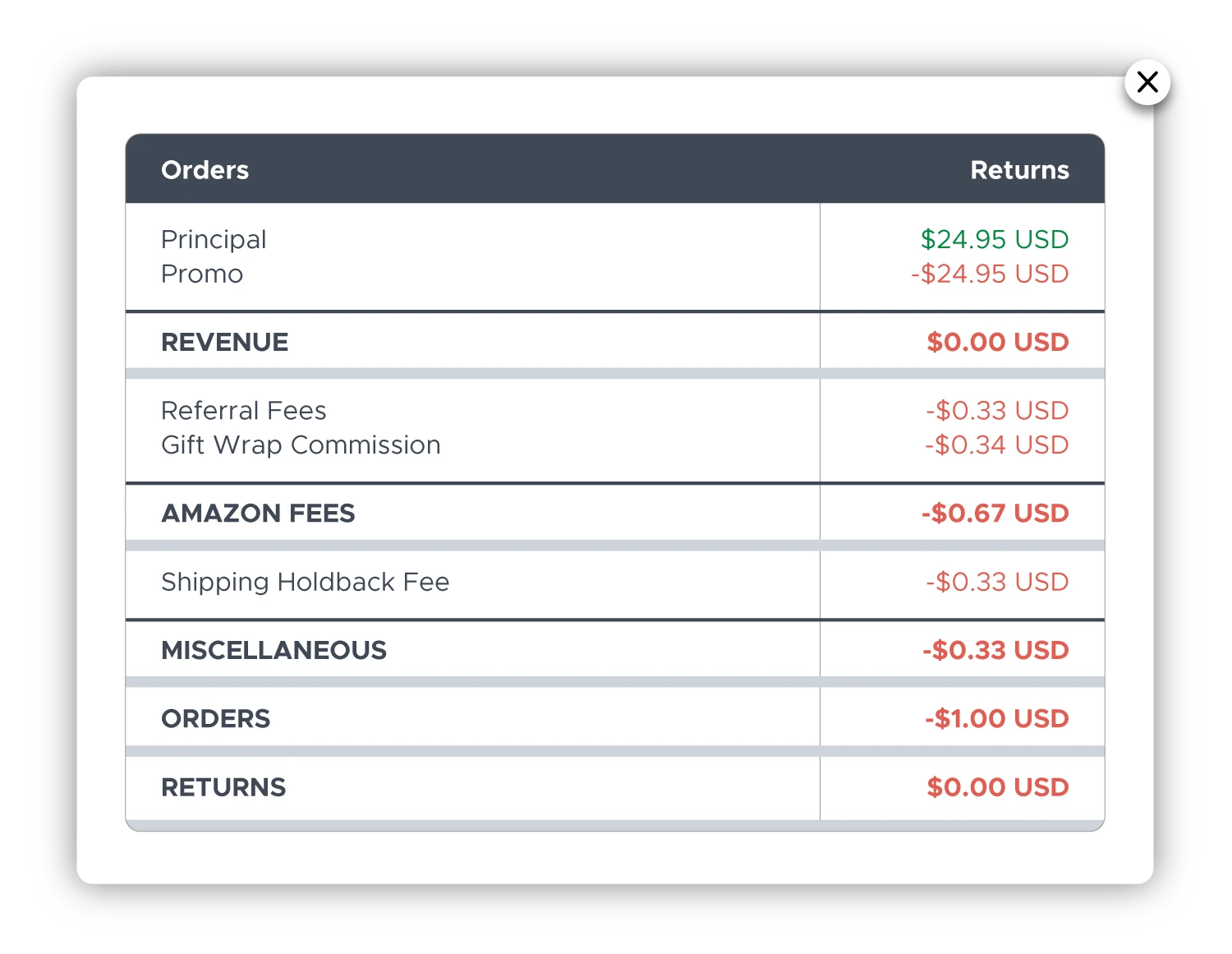
Special case where Amazon charges you 3 kinds of fees to offset your 100% promos.
Gift Wrap Tax
| Gift Wrap Tax is also called GiftWrapTax, gift-wrap-tax. |
|---|
Gift Wrap Tax is collected on Gift Wrap Charges. The exact amount collected will depend on your tax settings in Seller Central:
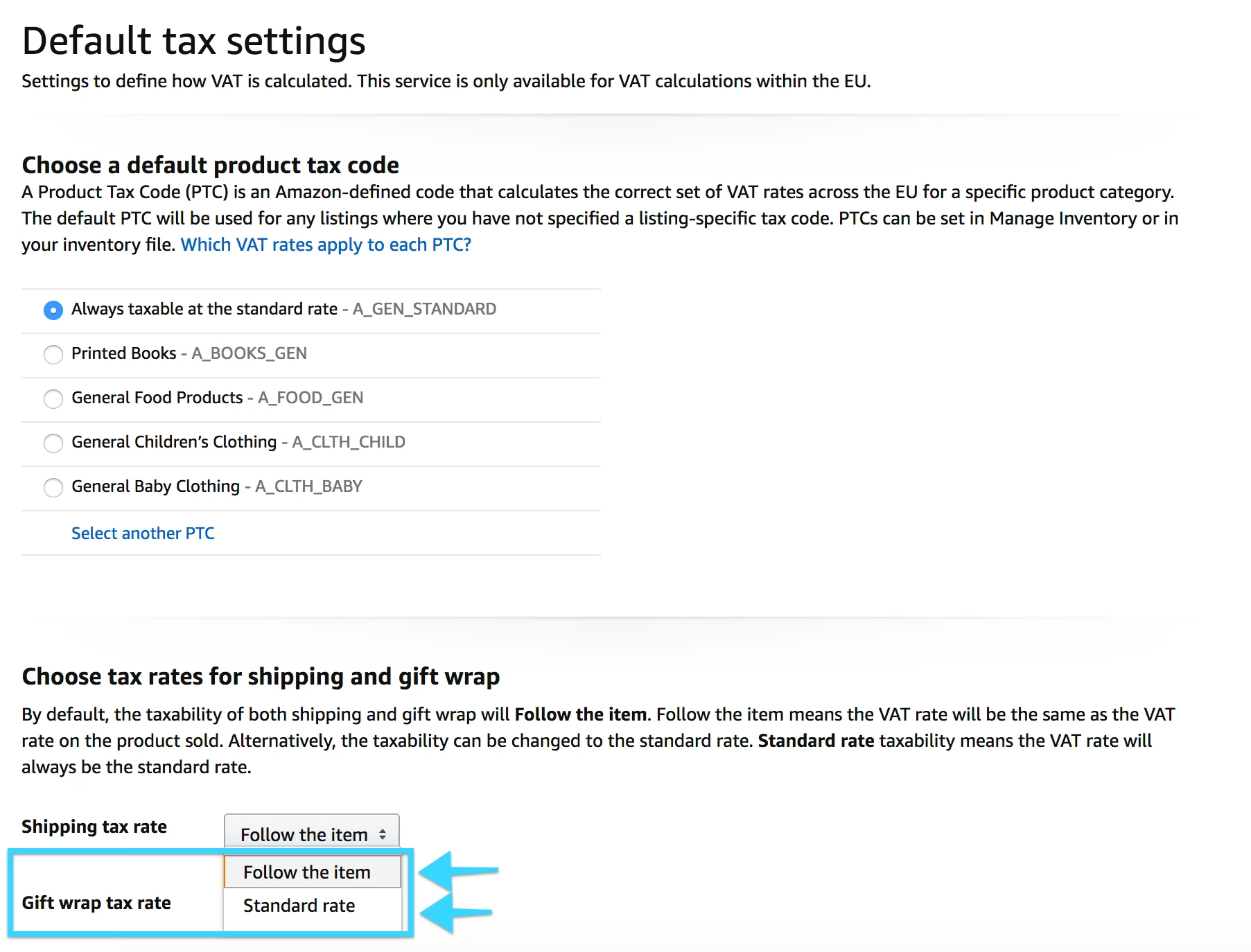
You may not know this, but you are liable to remit collected Tax on Gift Wrap, EVEN if Amazon is the one doing the actual gift-wrapping, and keeping the Gift Wrap charges.
So when you remit your collected sales tax at the end of the year for VAT for example, don't forget to add the amounts for collected Gift Wrap Tax. Consult your accountant for more info on this, but just be aware Amazon does not remit collected Tax for Gift Wrap services that they performed - YOU have to do it.
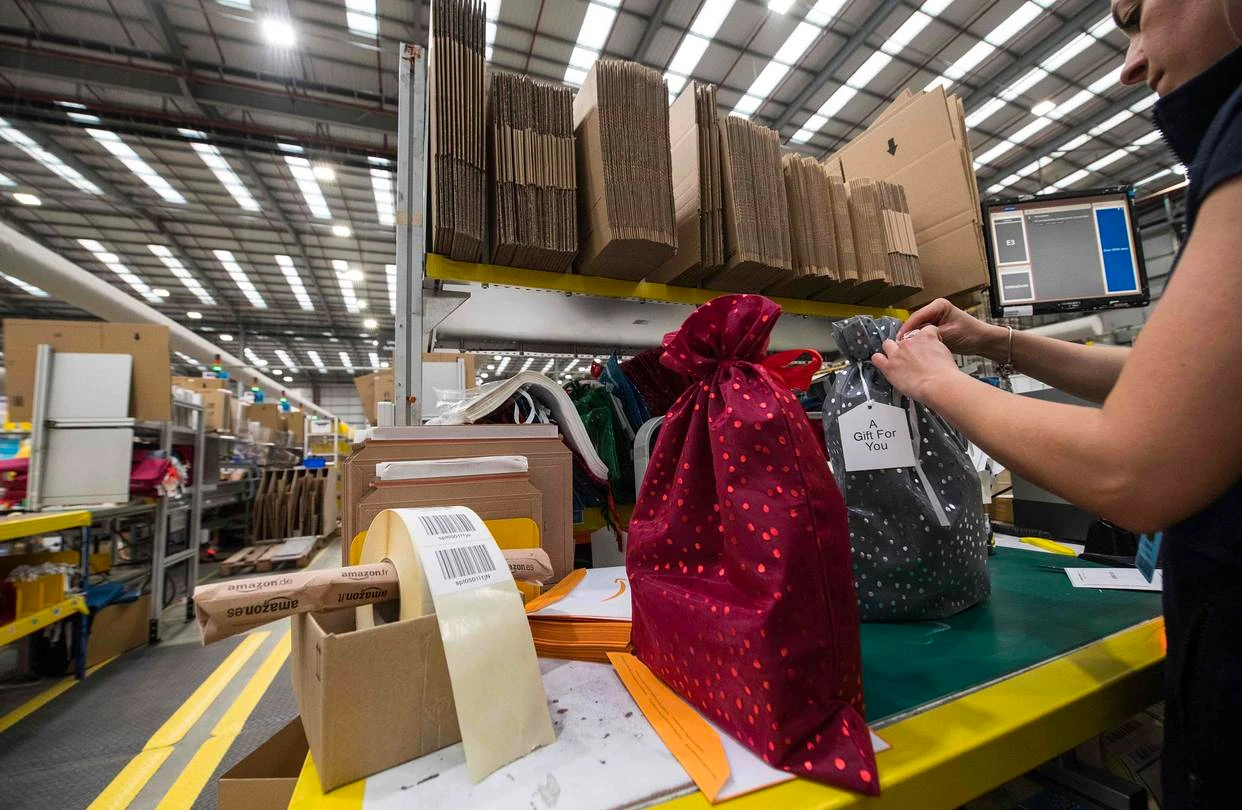
Amazon leaves you to remit collected sales tax on the gift wrap charges, EVEN if they are the ones doing the gift wrapping.
The Gift Wrap Tax will appear on your Order Transaction as income.
Here’s how Shopkeeper will show it:
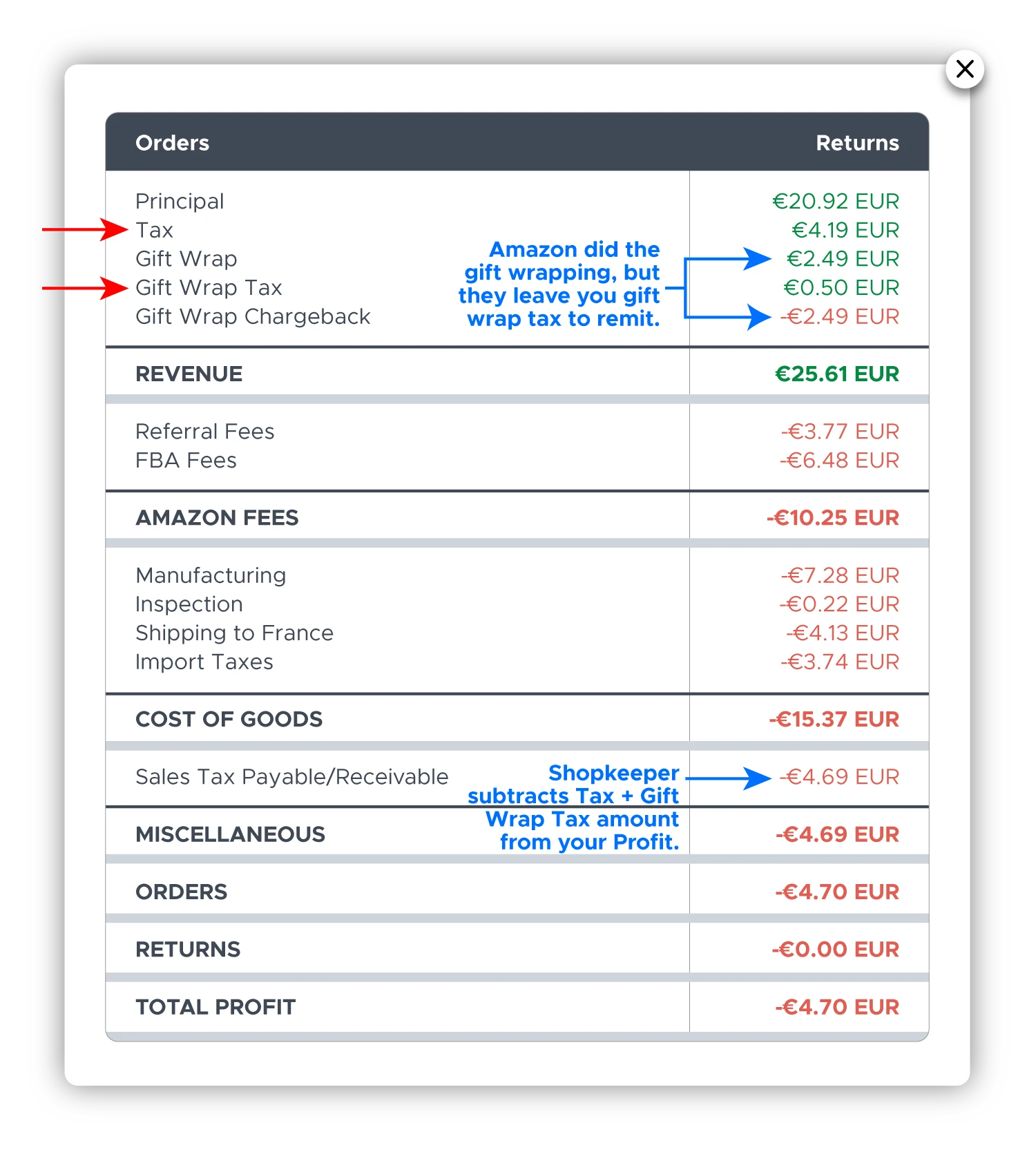
And that makes you see the actual profit you made, minus the sales tax collected.
You can double check it on your Seller Central:
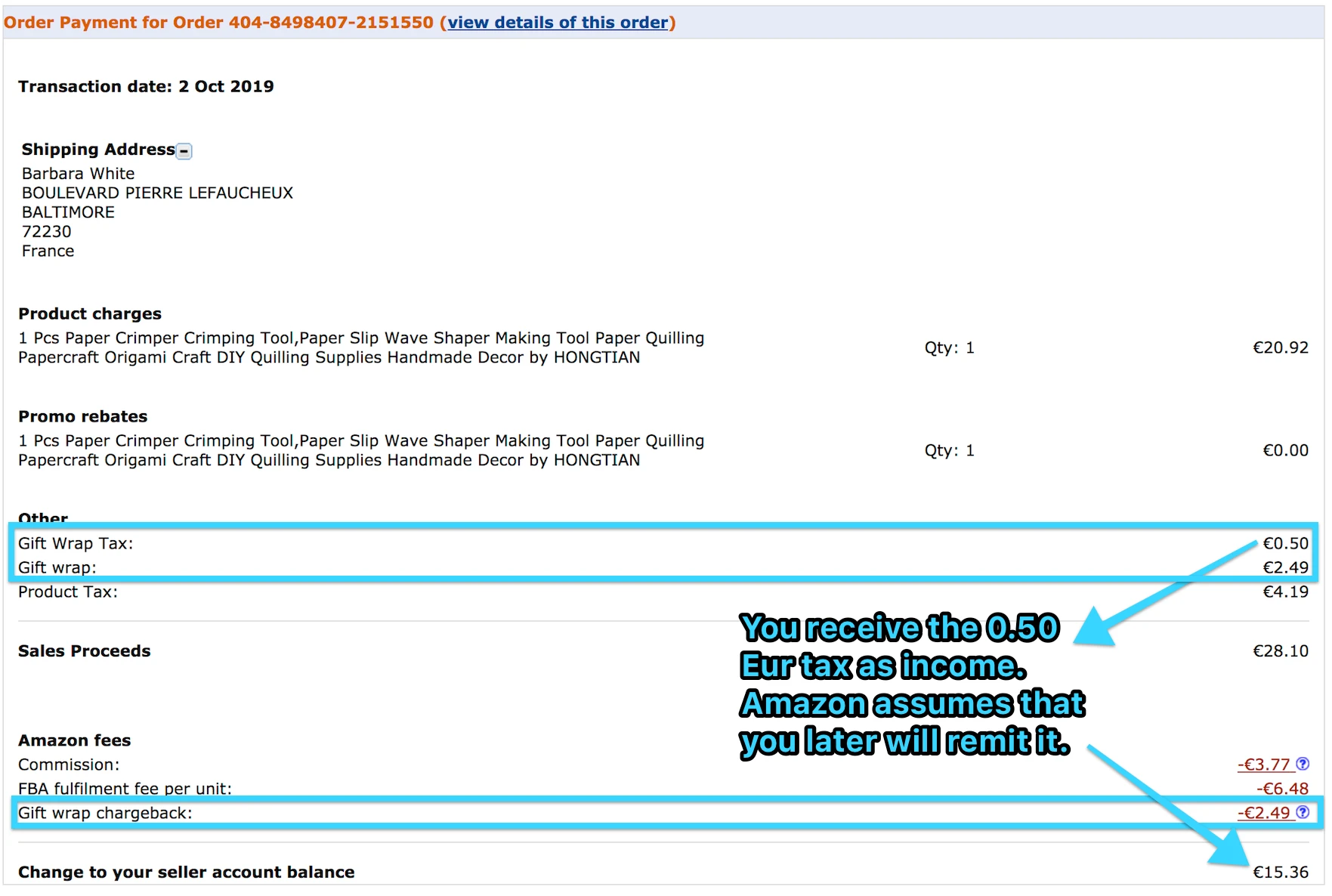
If you sell in USA, Gift Wrap Tax can be either collected or not collected, based on state-specific rules and regulations. You as a seller will have to research and decide whether to collect sales tax on gift wrap or not, in each specific state.
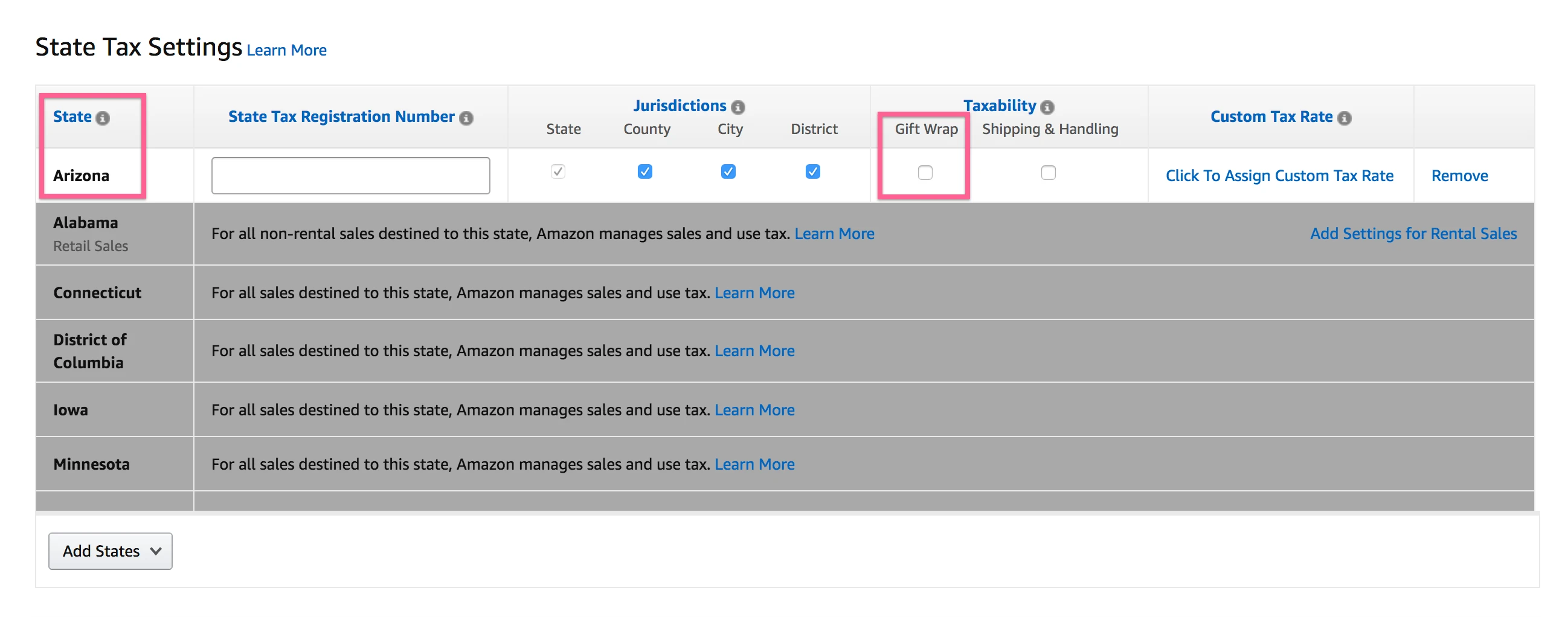
State by State Gift Wrap Tax Guide - Taxjar
For some states, Amazon is automatically collecting sales tax and remitting it on your behalf. Alabama, Connecticut, Iowa, Washington and many others. In that case, you don't need to worry about collected Gift Wrap Tax.
When Amazon auto-collects taxes on your behalf, your Seller central transaction shows a chargeback for Gift Wrap Tax, called MarketplaceFacilitatorTax-Other:
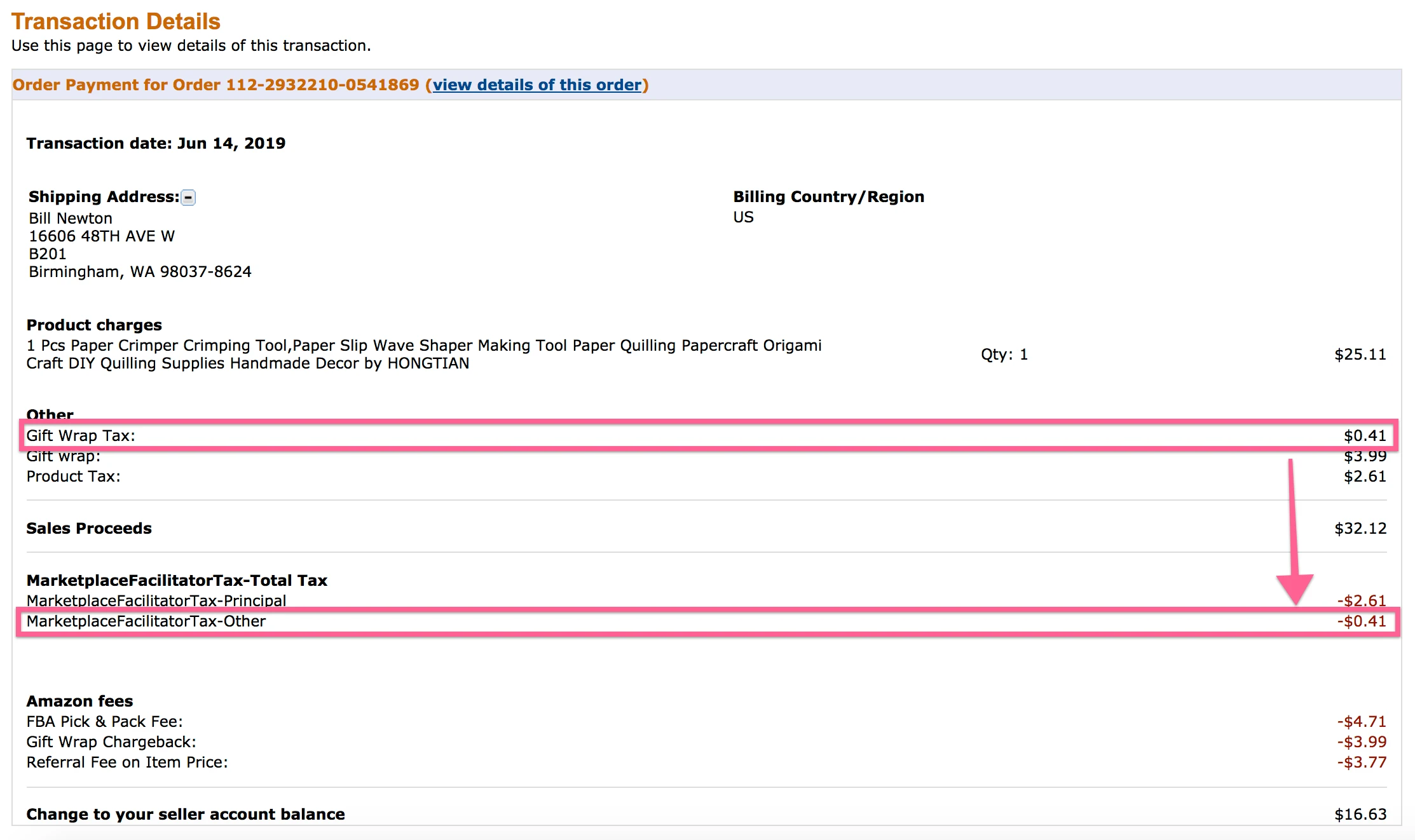
Note that according to Amazon, your Sales Proceeds (Revenue) is $32.12. This is inflated, because in the same transaction they are showing chargebacks as expenses. You may not want inflated revenue figures, if you are to present your numbers to potential investors, partners, etc.
This is how Shopkeeper will organize it for you:
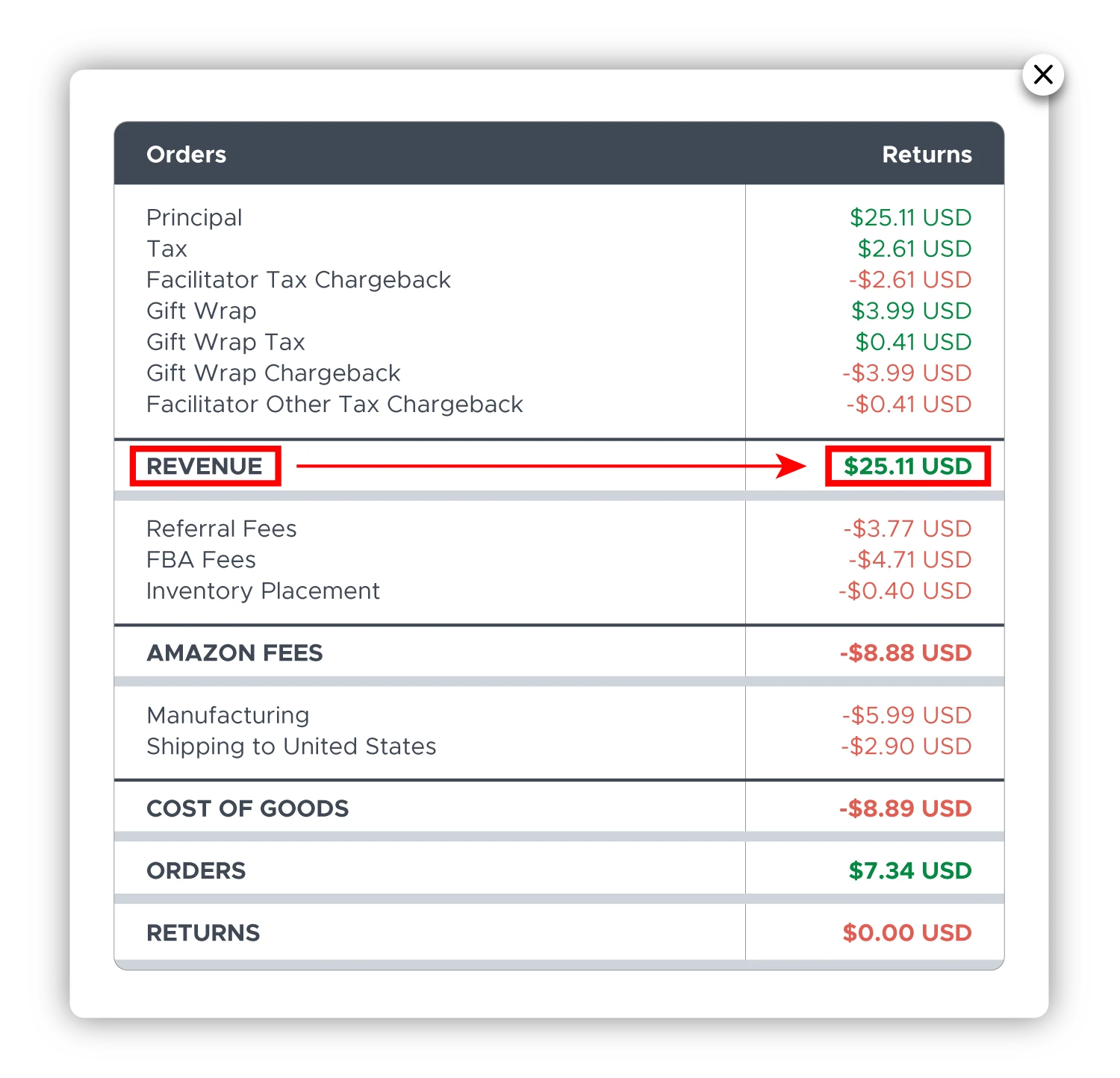
Shopkeeper does not inflate your revenues, like Amazon does. Both Gift Wrap charge and all chargebacks are summed up in Revenue amount, instead of showing chargebacks as expenses. This normalizes your revenues and you don't appear like you are making more money when you aren't.
See How Gift Wrap Fees Affects Your Profits
Global Inbound Transportation Duty
Sellers are required to pay GlobalInboundTransportationDuty in order to cover import tariffs and taxes when shipping goods into Amazon's fulfillment centers from other countries. It includes customs charges related to overseas shipping as part of Amazon's worldwide fulfillment services.
Global Inbound Transportation Freight
GlobalInboundTransportationFreight is a cost calculated by Amazon when the company manages the importation of goods on behalf of sellers, and freight expenses are involved. This fee encompasses the transportation costs incurred during the global shipping process, including import duties, taxes, and other fees associated with transporting goods across international borders.
Goodwill
| Goodwill is also called Other Concession. |
|---|
Goodwill is an amount issued to your customer by Amazon, when the customer is not entitled for this amount of refund. Most often, Goodwill concession is granted to compensate for negative customer service experience, late deliveries, lost packages and similar situations.
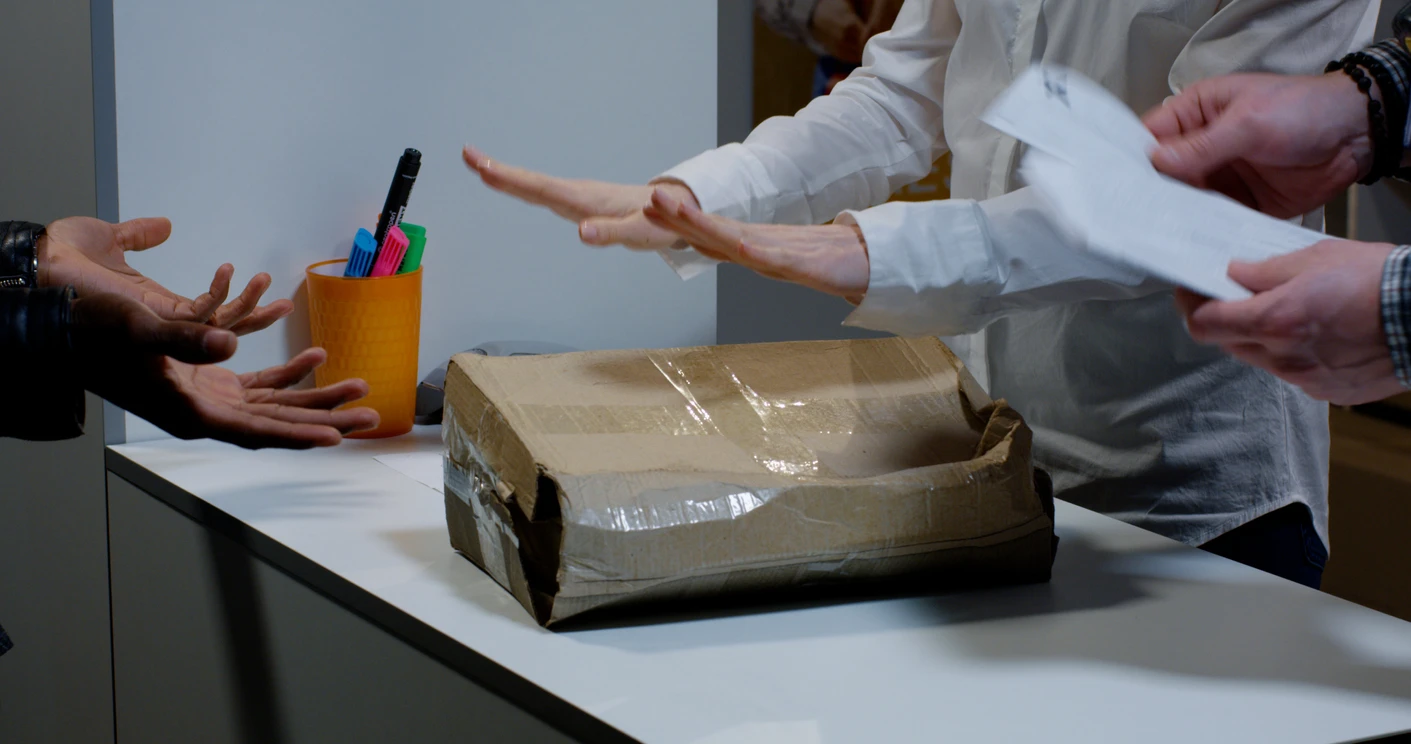
Amazon takes responsibility for Goodwill charge - so even though you will see it being deducted from your account, you will later see your account being credited for it (within 45 days).
Initially, the Goodwill amount which Amazon issues to your customer, appears as a charge to you, on Seller Central:
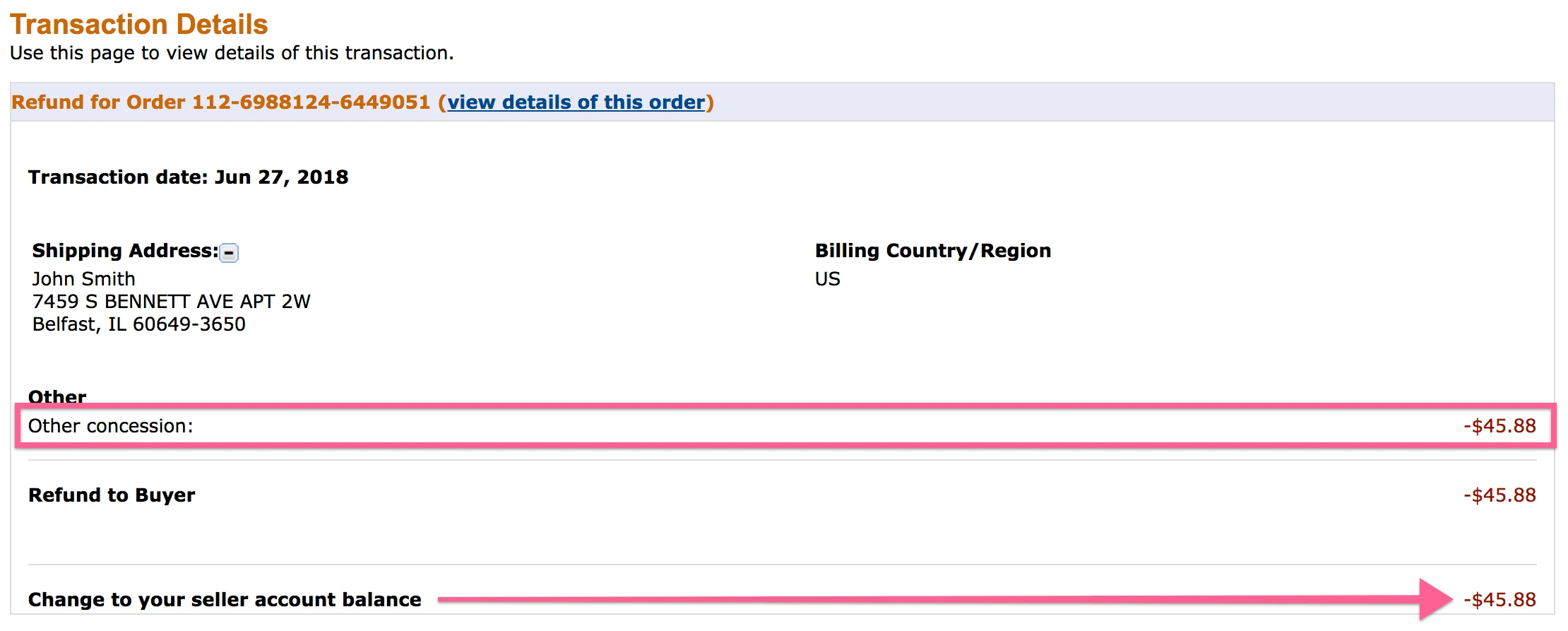
Within 45 days of this transaction, you will see an Inventory Reimbursement - Customer Return transaction, associated with the same order.

Here is the full sequence of financial events that happen when the product is refunded and extra goodwill amount is issued to your customer:
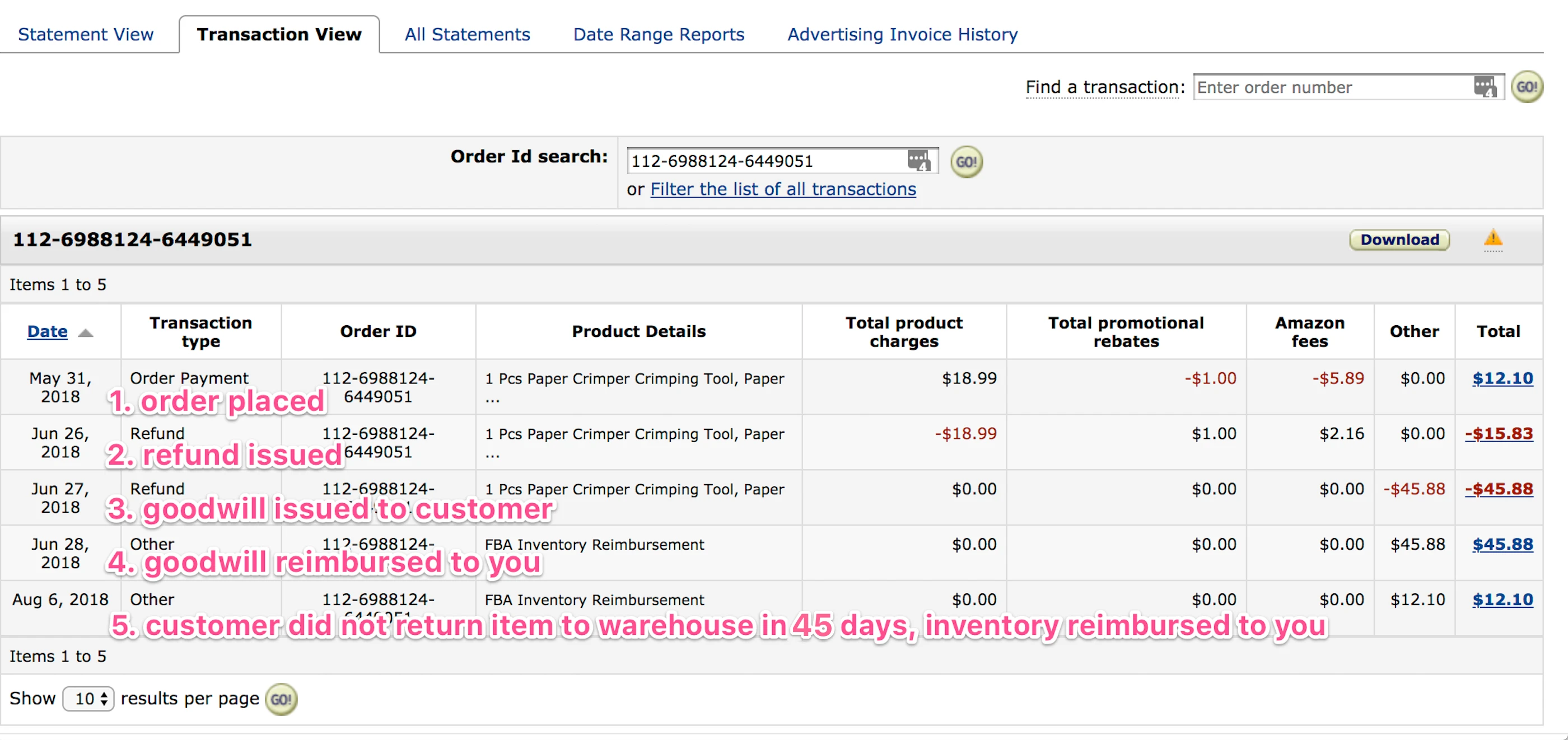
-
Order is placed - normal order transaction.
-
Refund is issued - normal refund transaction
-
Goodwill is issued to the customer - you get charged the amount they gave customer as a "bonus refund".
-
Goodwill is reimbursed to you - you get back the money you "paid" to your customer for being dissatisfied with Amazon experience.
-
Customer does not return the item to the warehouse in 45 days, so Amazon charges the customer and reimburses you for the unit.
... ooops, that step 5 has probably made this customer extra angry, as he was likely not aware he had to return the item to not get charged for it.. So he called, he complained, he got his refund and 45 dollars on top of it, and then - BAH - another unexpected charge, when he did not send in the item. Maybe he didn't even have the unit anymore. Pretty unfortunate situation.
Amazon does not have a special Goodwill Amount Reimbursement tag, so they reimburse you using a confusing Inventory Reimbursement tag.

This can make you think that you actually received the refunded item back in stock (as is the normal reason for Inventory Reimbursements). The confusing part is Quantity: 1. It may seem as if one unit was reimbursed, when in fact in this transaction it was not. Reimbursement was only for giving you back the Goodwill amount.
So if you rely solely on Seller Central reports for your accounting, you may use the Goodwill Reimbursement amount in your books incorrectly.
Shopkeeper helps you clarify this event by separating actual Inventory Reimbursements from Goodwill Reimbursements.
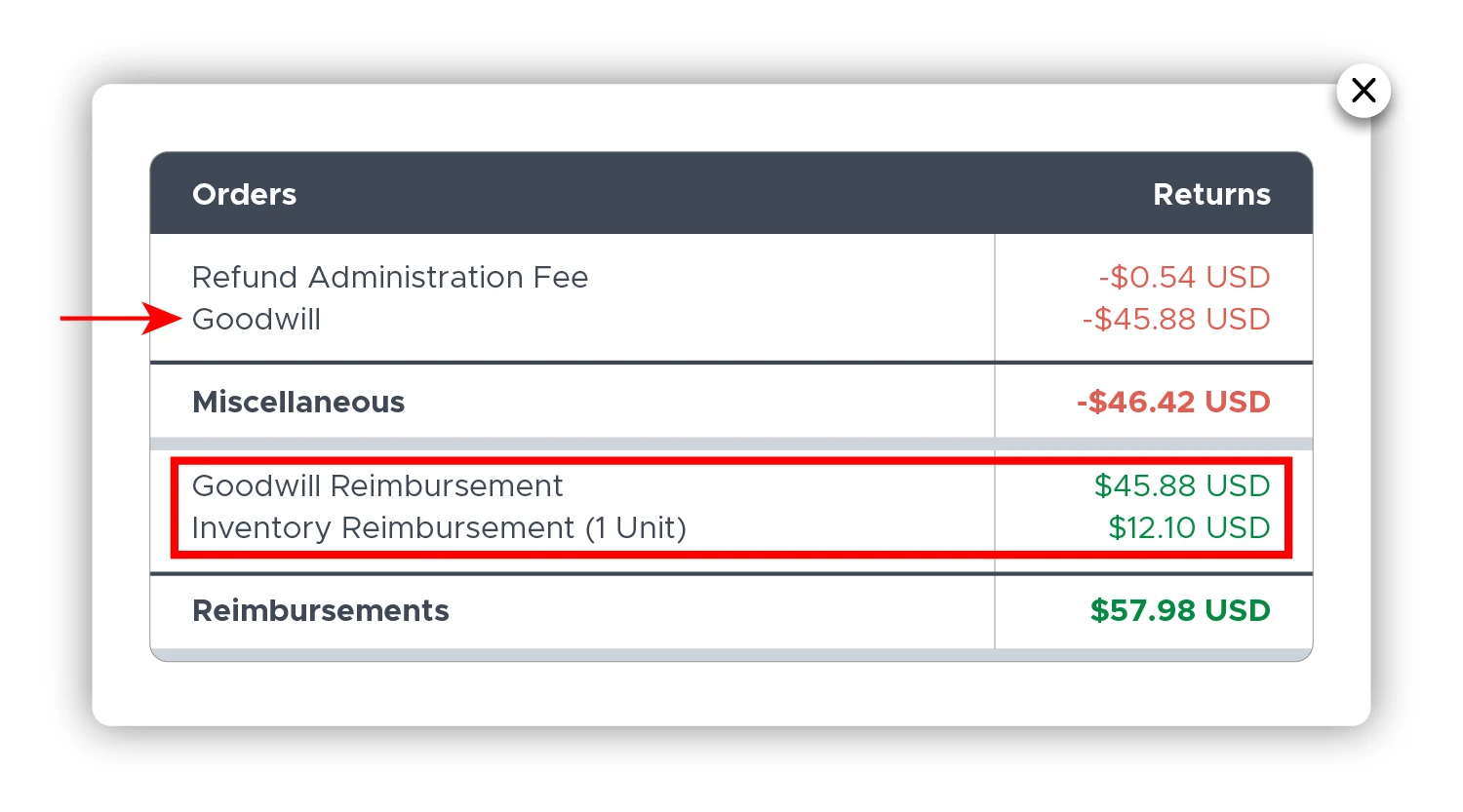
You can clearly see which reimbursement event was refunding you the Goodwill amount, and which reimbursement was for the unreturned unit to inventory.
Get Insights on Your Goodwill Fees
High Volume Listing Fees
| High Volume Listing Fee is also called HighVolumeListingFee. |
|---|
High Volume Listing Fee applies mostly to dropshippers, or any sellers that have more than 100,000 active but dead listings on Amazon. For every extra listing above the first 100,000 listings without sales in the last 12 months, Amazon charges a monthly fee of $0.005.
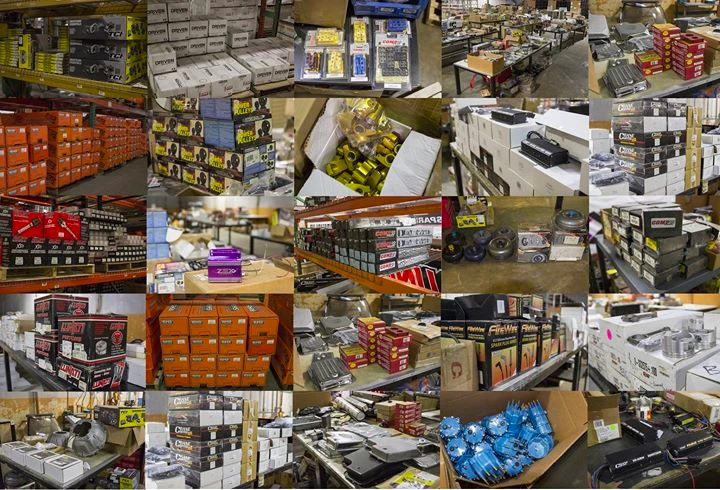
There are three rules which Amazon uses to count the ‘dead’ listings. It has to satisfy the following:
You have an active offer for that asin, meaning there is at least 1 unit in stock that is available for sale.
AND
This is not a new listing, and this ASIN was created more than 12 months ago.
AND
This ASIN did not have any sale from any seller in the last 12 months.
You see, the good thing is, that you share this burden with other sellers. If any of you have had sales in the last 12 months, then this listing will not count as ‘dead’.
For exact up to date fee amount, see this page on Amazon:
High Volume Listing Fee - Amazon Seller Central USA
In Amazon Europe, HighVolumeListingFee also exists, but different rules apply:
If you exceed 2 million SKUs in a given month, you will be charged. For example, for each active non-media SKU over 2 million, a fee of €0.0004 per SKU will apply. See the most recent fees on Amazon page:
High Volume Listing Fee - Amazon Seller Central Europe
Import Taxes Amount
The import_taxes_amount charge denotes the taxes or levies imposed on goods that are being transported abroad. When an item crosses borders, the destination country's government may levy customs charges, taxes, or fees, which are covered by this charge. It guarantees that you pay these taxes in advance, preventing delays or extra fees at the time of delivery.
Inbound Carrier Damage
The INBOUND_CARRIER_DAMAGE charge on Amazon is incurred when items sent by a seller to an Amazon fulfillment center are damaged during shipment. If the damage occurs during transit, the seller may be charged or get an adjustment for the damaged items. Responsibility for the damage is determined by whether the seller or Amazon's partnered carrier handled the shipping, which influences whether the seller is compensated or must seek reimbursement.
Check Your Damage Reimbursements
FBA Inbound Convenience Fee
FBAInboundConvenienceFee applies when Amazon assists in receiving your products into their fulfillment facilities, which may include services such as label application or other preparation required to stock your items.
Let's say your shipment requires new labels; Amazon may charge $0.20 per unit for relabeling, which adds up depending on the quantity of your shipment.
FBA Inbound Defect Fee
Amazon charges an FBAInboundDefectFee when products prepared by sellers are brought in. It acts as a penalty for products that need more labor or revisions from Amazon in order to satisfy the requirements for fulfillment or storage. This charge serves as a motivator for sellers to make sure their goods are ready before shipping them to Amazon's fulfillment centers, which minimizes the time and money Amazon must spend correcting or altering goods once they arrive. By following Amazon's policies and offering premium products right away, sellers can prevent this charge and guarantee a more efficient and economical incoming process for their inventory.
FBA Inbound Shipment Carton Level Info Fee
FBAInboundShipmentCartonLevelInfoFee is imposed when you do not submit accurate or complete carton-level information (such as dimensions and contents) for inbound shipments; Amazon may charge for the additional effort required to manually handle these shipments.
If you ship 30 cartons to Amazon without carton-level specifics, they may charge $3 each carton for manual processing, totaling a $90 price.
FBA Inbound Transportation Fee
FBAInboundTransportationFee refers to the fees that the seller must pay to Amazon for having their products shipped to Amazon for fulfillment. Most often, this refers to the cost of buying shipping labels for your products that are shipped to Amazon for fulfillment. You have the option to ship these items to Amazon directly for fulfillment, which means you can skip this fee and pay for your own labels. However, through Amazon’s partner shipping programs it can be much more cost effective to pay the inbound fee and in turn pay the Amazon Inbound Transportation. This helps for convenience and can get your inventory replenished faster!
Check Your Inbound Fees
FBA Inbound Transportation Program Fee
The FBAInboundTransportationProgramFee is a special fee that applies when you work with UPS for shipping your products to Amazon's FBA warehouses. This fee covers the cost of using Amazon's partnered shipping services, which usually involves purchasing UPS shipping labels when creating a shipment to restock inventory.
FBA Inbound Transportation Service Fee
When using Amazon’s inbound transportation to replenish inventory, it’s critical to report that inbound inventory accurately to Amazon. Amazon will charge the FBAInboundTransportationServiceFee based on the information that you provide (number of boxes, sizes, weights etc.) but if Amazon receives the shipment and finds that information to be inaccurate, you will be hit with a service fee to make up for the difference. Not a huge deal, but just something to be aware of if you get hit with a service fee on your inbound shipments and find yourself asking “What is this?”.
So do your best to accurately report your inbound packages to Amazon. This will help you avoid these additional service fees that you may or may not have accounted for!
Increase Visibility on Low Traffic Items
This is likely a Sponsored Products campaign designed to promote items that aren’t getting much traffic or visibility.
It targets ASINs with low impressions or clicks to help boost exposure.
-
Increase Visibility on Low Traffic Items_OOC - Often auto-generated by Amazon’s advertising recommendations or used as part of a broad strategy. “OOC” may stand for Out of Campaign or Out of Category, indicating that the ASINs being promoted don’t currently belong to an existing manual campaign or fall outside standard targeting structures.
-
Increase Visibility on Low Traffic Items_SO - “SO” could stand for Sponsored Offers or a custom label depending on your ad setup. It’s likely a variation of the same low-traffic item visibility campaign, possibly tailored for a specific product group or targeting method.
Inspection Amount
Inspection_amount describes the cost imposed on Amazon sellers to have their products inspected to make sure they satisfy quality requirements prior to sale or shipment. In order to preserve the quality of the product, this fee is incurred when things are shipped to fulfillment centers. It may affect the overall expenses and profit margins of sellers.
FBA Inventory Fee
The FBA Inventory Fee is charged for storing your products in Amazon's fulfillment centers and includes two primary costs:
-
Monthly Storage Fees: These are determined by the amount of space (measured in cubic feet) your products take up, with higher rates typically applied during peak times, such as the holiday season.
-
Long-Term Storage Fees: This fee is applied to inventory that has been stored for more than 12 months, aimed at reducing stagnant stock.
Incorrect Fees Items
| Incorrect Fees Items is also called INCORRECT_FEES_ITEMS, IncorrectFeesNonItemized, INCORRECT_FEES_NON_ITEMIZED. |
|---|
This fee is exactly what it says - Amazon adjustments for incorrect fees.
Distinction between items and non-itemized is Amazon specific - they use the term item to mean an individual SKU, a separate product.
When the adjustment is non-itemized, no SKU is associated with that transaction. This means that incorrect charges were for a service that does not specify one SKU or had more than one SKU affected.
When the adjustment is IncorrectFeesItems - it means that Amazon has indicated which SKU and how many units of that SKU are affected by the adjustment. For example, they had incorrect measurements of your product, and you complained. Then Amazon will add in an adjustment, depositing you the difference that you overpaid, showing in the transaction on Seller Central, as 279 units of SKU KR-FG78-54R, calling it adjustment INCORRECT_FEES_ITEMS.
Shopkeeper shows Incorrect Fee adjustment on a particular date when it gets posted by Amazon. Even if there are no sales of that product on that day:
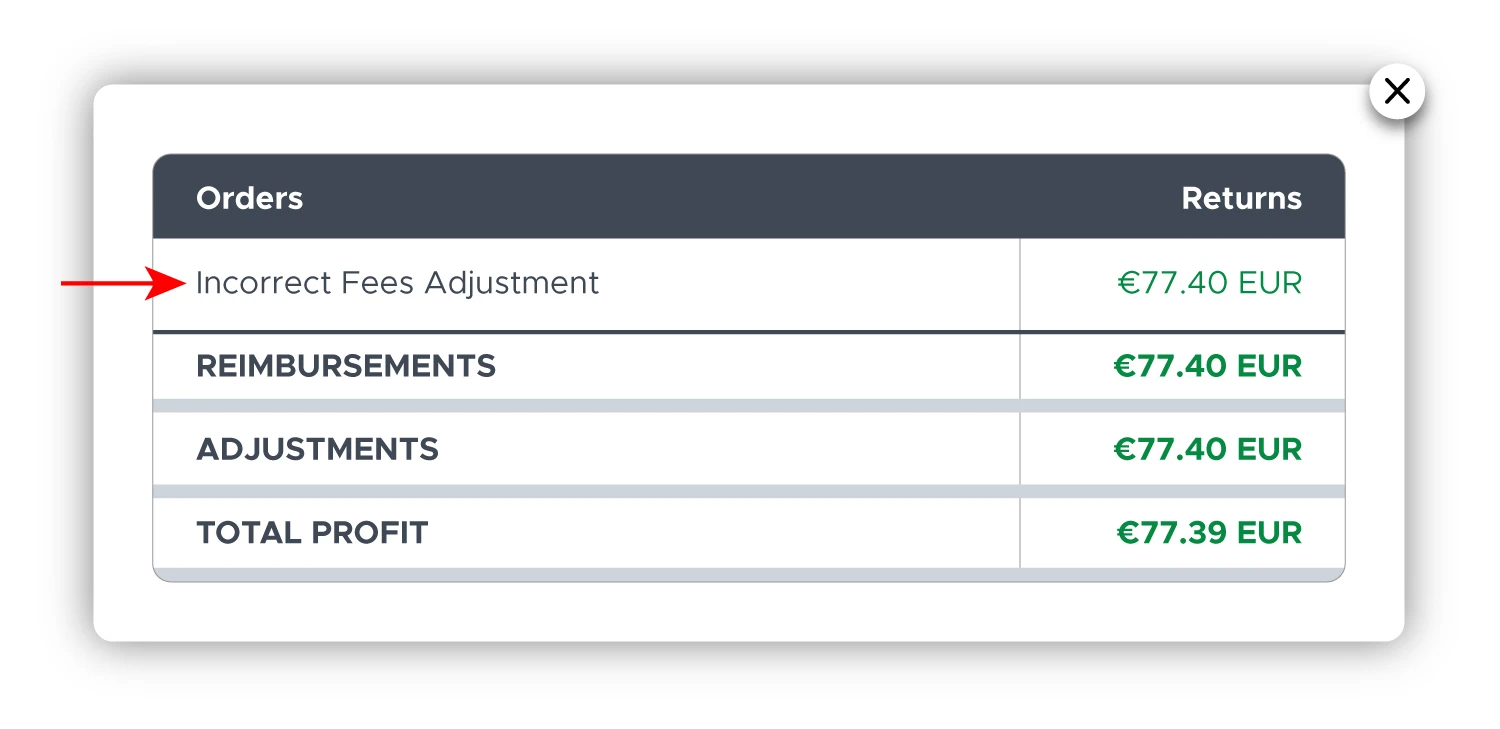
On June 26, in this example, Amazon posted an adjustment for Incorrect Fees in multiple EU countries at the same time. Shopkeeper shows these financial transactions, even though there were no sales of this product on June 26. That way you get the most complete financial picture of that day.
If Amazon does not specify which SKU was affected, Shopkeeper shows the adjustment amount in the Totals row on adjustment posted date:
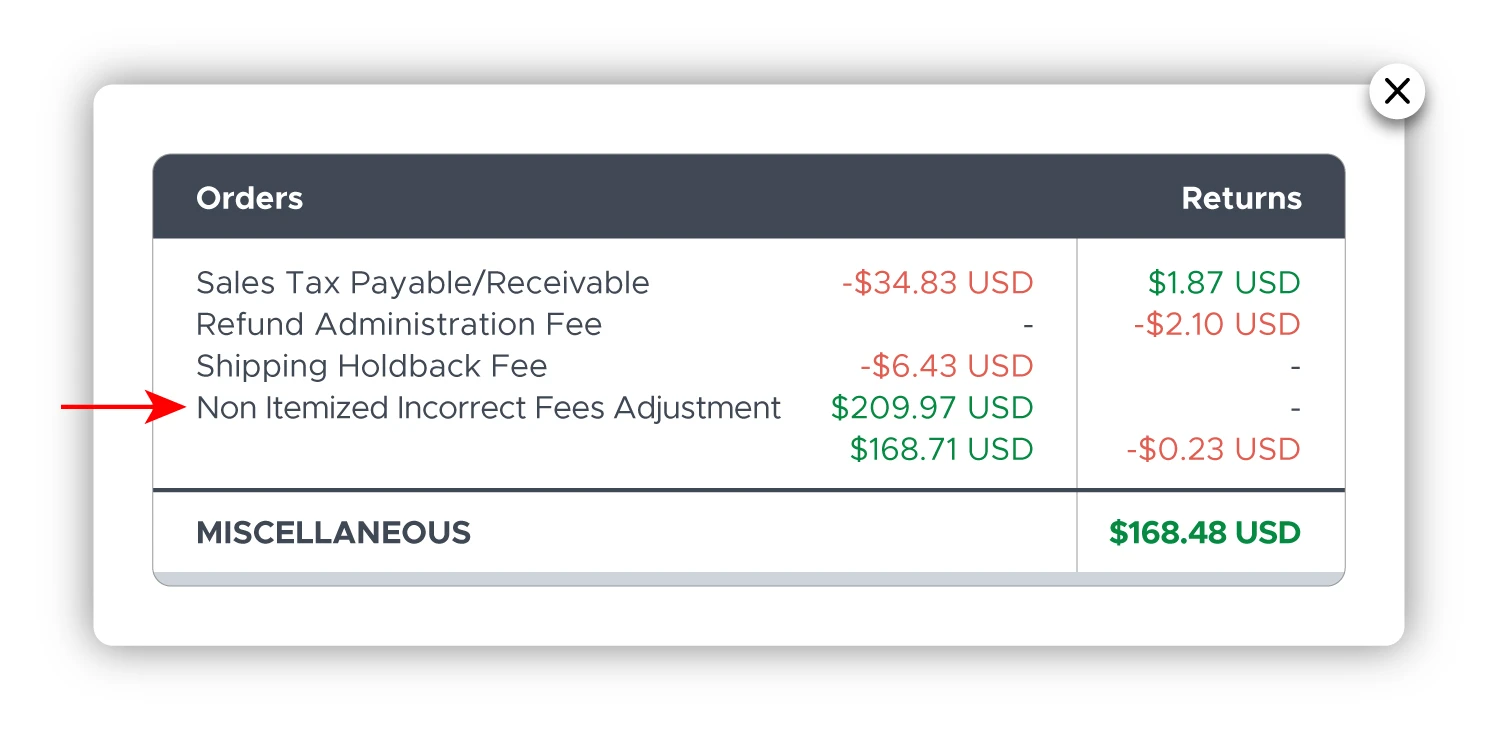
Audit Your Incorrect Fees Items
FBA International Inbound Freight Fee
The FBAInternationalInboundFreightFee is a charge made by Amazon to offset the freight expenses related to shipping items internationally. This charge is incurred by sellers that ship their inventory from areas outside of the nation where Amazon's fulfillment centers are situated. It includes all costs connected with shipping, clearing customs, and other relevant fees when moving goods across international boundaries.
FBA International Inbound Freight Tax And Duty
FBAInternationalInboundFreightTaxAndDuty refers to the import taxes and customs charges associated with delivering goods internationally to Amazon's fulfillment centers via the Fulfillment by Amazon (FBA) program. These fees are critical for sellers to consider when shipping their products across borders to be kept and maintained by Amazon.
Assume a seller in the UK wants to send 100 toys to an Amazon fulfillment center in the United States. The US government charges a 5% import tax and a 10% customs levy on toys. If the total value of these toys is $1,000, the seller will incur the following costs:
-
Import Tax: $3,000 x 5% = $150
-
Customs Duty: $3,000 x 10% = $300
Thus, the total FBAInternationalInboundFreightTaxAndDuty for sending these toys to the US would be $450.
Inventory Placement Fee
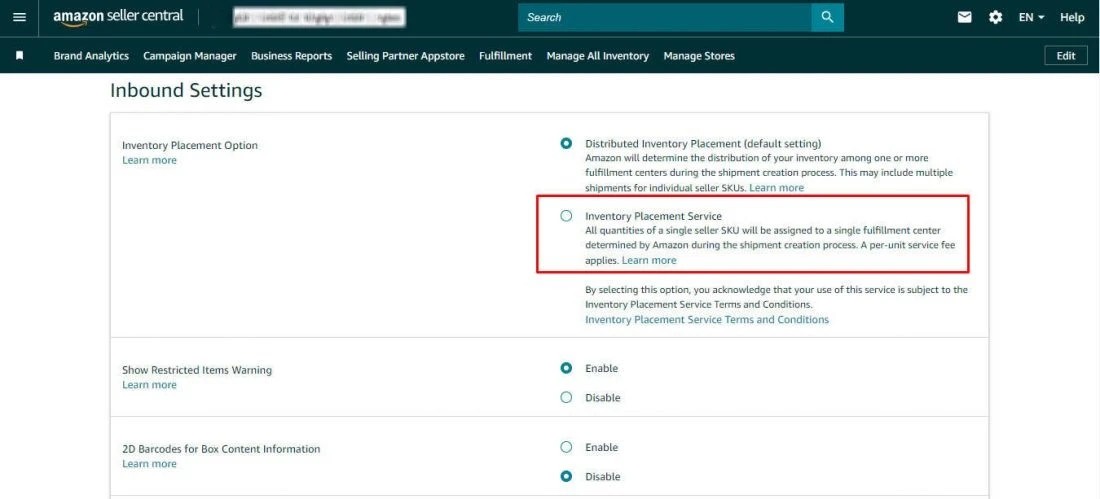
As stated by Amazon Seller Central, all quantities of a single seller SKU will be assigned to a single fulfillment center determined by Amazon during the shipment creation process. A per-unit service fee applies.
The InventoryPlacementFee is a charge by Amazon for its Inventory Placement Service, facilitating inventory distribution. This service incurs a per-item fee based on weight and size. While the standard Distributed Inventory Placement Program is free of charge, companies who sell large or heavy goods may have to pay significant additional fees. There are several exceptions, such as jewelry, clothing, and dangerous products, which would need to be handled separately.
Fees for standard-size items range from $0.30 to $0.40 per unit, with additional charges for heavier items. Oversize items incur a flat fee of $1.30, plus extra charges per pound over 5 pounds.
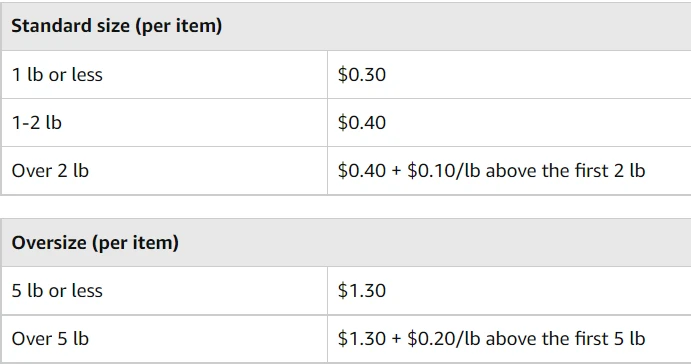
While the service streamlines distribution, it's not free, and businesses should weigh its benefits against costs. For instance, shipping 1,000 units of sub-1-pound inventory incurs a $500 fee. Businesses must carefully assess whether the convenience of centralized shipping outweighs the additional expense.
Item TDS
The tax that Amazon collects from sellers when a product is sold is known as the ItemTDS. This fee is determined by the buyer's location's sales tax regulations. Amazon determines the applicable sales tax at the time of purchase, adds it to the total cost, and pays the appropriate tax authorities. Amazon handles the tax collecting procedure, so sellers don't have to do it themselves.
Labeling Fee
When you opt for Amazon to generate barcodes or labels for your products, you incur a LabelingFee. If you specifically request Amazon to label your items with ASIN/FNSKU barcodes, they charge a fee per label. As of now, the fee is $0.20 per label.
See How Labeling Fees Affect Your Costs
Local Shipping Amount
The cost of delivering an item inside the same country or region is known as the "local_shipping_amount" charge. For instance, this fee may be applied to your total if you're purchasing anything from a third-party vendor who doesn't provide free delivery. It is distinct from overseas shipping charges and is frequently observed in situations where Prime perks, such as free shipping, are not applicable.
FBA Long Term Storage Fee
Amazon imposes an annual FBALongTermStorageFee on items stored in their warehouse for more than 12 months. The intention is to discourage using fulfillment centers as long-term storage and to maintain an efficient inventory flow. The fees increase for items stored beyond 365 days, calculated per cubic foot. Sellers are advised to keep track of their inventory and, if necessary, remove or dispose of slow-moving items to avoid incurring these long-term storage charges, which fluctuate based on peak and off-peak seasons.
Lost Or Damaged Reimbursement
The LostOrDamagedReimbursement is a payment made to sellers for items lost or damaged while in Amazon's possession or during the fulfillment process through the Fulfillment by Amazon (FBA) program. If a seller's inventory is lost or destroyed in an Amazon fulfillment center, the seller receives reimbursement for the affected goods based on their documented value.
Low Value Goods Tax - Other
LowValueGoodsTax-Other is a tax collected on goods below a certain value threshold, often triggered by international shipments. It is required by some countries to ensure fair tax application on cross-border e-commerce.
Low Value Goods Tax - Principal
LowValueGoodsTax-Principal is applied on the whole cost of the product, excluding any additional fees such as shipping or handling. It is particular to the amount paid for the products and reflects the item's taxable value as determined by local tax regulation for low-value imports. For example, if you buy a $20 item and the tax rate is 10%, the LowValueGoodsTax-Principal will be $2. This ensures that the primary cost of the item is taxed in accordance with the applicable regulations.
Low Value Goods Tax - Shipping
LowValueGoodsTax-Shipping is connected to the shipping and taking care of charges related with delivering the item. It is separate from the tax on the product's price and explicitly addresses the cost of delivering the item to the client.For example, if the item's shipping cost is $5 and the applicable tax rate is 10%, the LowValueGoodsTax-Shipping will be $0.50. This ensures that all aspects of the purchase, including shipping, are properly taxed in accordance with local legislation.
Manufacturing Amount
The cost of making a product, particularly for bulk or custom-made items, is referred to as the manufacturing_amount fee. This fee includes labor, raw material, and overhead charges that are incurred during the manufacturing process. It helps customers comprehend the pricing structure by breaking down the overall cost of an item. For goods manufactured especially for a customer, such as those offered through Amazon's bespoke services or bulk orders from other sellers, this sum is frequently pertinent. In conclusion, the manufacturing_amount provides buyers with clarity regarding product pricing by reflecting the costs associated with creating an item.
Analyze Manufacturing Charges
Marketplace Facilitator Regulatory Fee - Principal
The MarketplaceFacilitatorRegulatoryFee-Principal is a charge imposed by Amazon on sellers in certain regions where Amazon acts as a marketplace facilitator. This fee is linked to tax regulations that require Amazon to collect and remit taxes on behalf of sellers for transactions conducted through its platform. Essentially, Amazon handles the responsibility of collecting and paying the necessary taxes to local authorities when sellers use its marketplace to sell goods.
Understanding and preparing for this fee is crucial for sellers, especially in jurisdictions where these tax rules apply. It ensures compliance with tax laws without sellers needing to individually manage tax collection and remittance for their sales on Amazon. For detailed information on how this fee applies to specific situations, sellers should consult Amazon's official seller resources or reach out to Amazon Seller Support directly.
Marketplace Facilitator Tax
| Marketplace Facilitator Tax is also called MarketplaceFacilitatorTax-Principal, MarketplaceFacilitatorTax-Total Tax. |
|---|
Marketplace Facilitator Tax is a tax collected & remitted by Amazon on your behalf, due to agreements with the specific states in USA. Eventually all states will have such agreements and sales tax will be collected & remitted for you automatically in all of USA.
You don't have to do anything, and there is no extra cost to you. But Marketplace Facilitator Tax will show up in your Seller Central transactions, so you need to understand what they are:
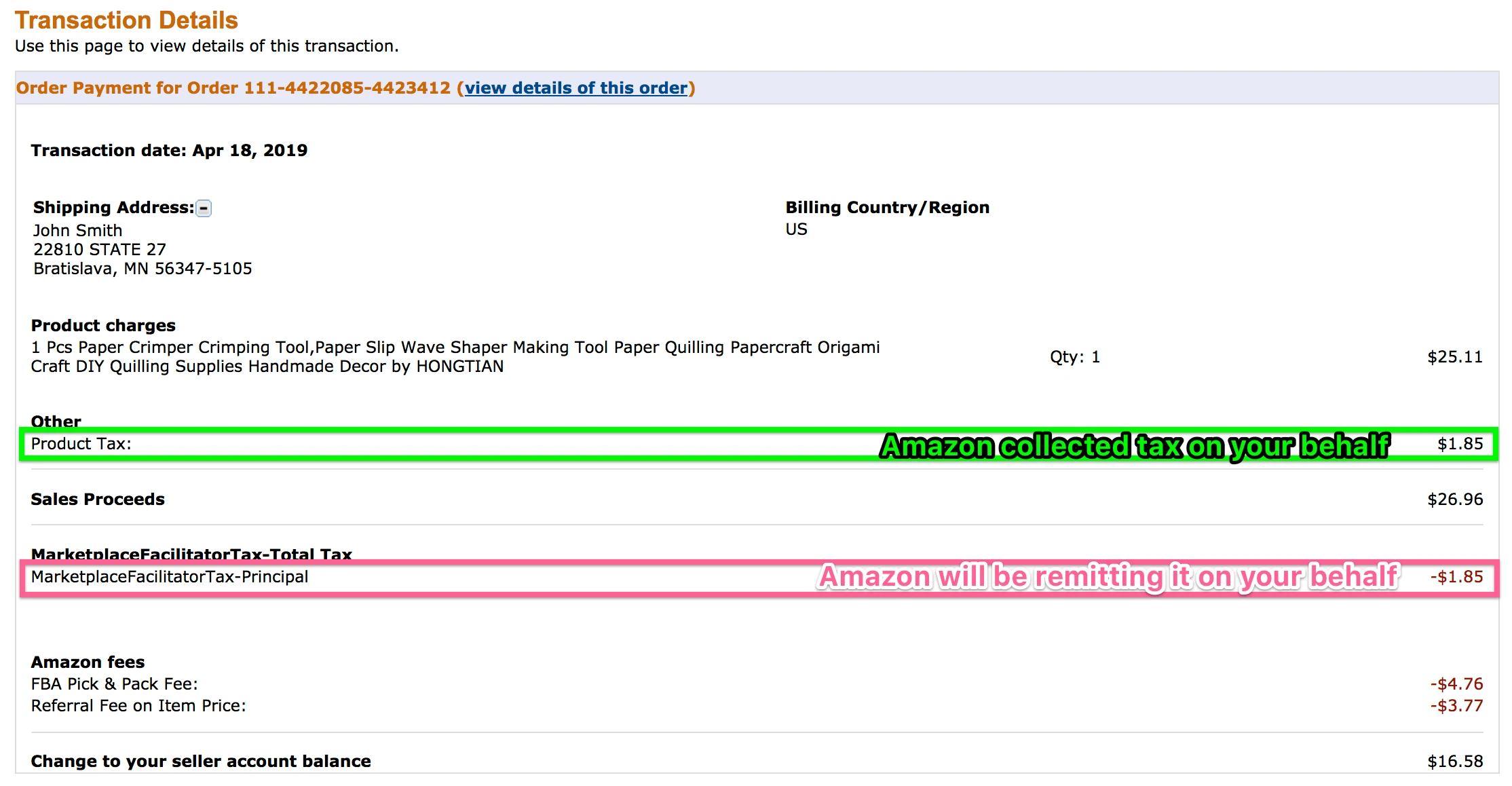
There is a bit of grey area in how Amazon sellers currently handle sales tax in those USA states that do not have agreements with Amazon. Here is a video explaining it:
In short, you are liable to collect sales tax in any USA state where your business has a nexus. Having inventory in a state is one way to be considered having a nexus. And as you know, Amazon stores your inventory all over USA, so you have nexus in basically all of the states.
That means you are in fact liable to register for remitting sales tax in each state in USA.
Most sellers are not collecting sales tax in all states. It's huge overhead and extra costs to register and do remittances, which often would be higher costs than actual sales tax collected. So most sellers now are just standing in a 'grey area', waiting for Marketplace Facilitator Agreements between Amazon and all the states to be signed.

Here is an up-to-date list of agreements with the states that are currently signed by Amazon:
Marketplace Facilitator Tax Collection - Amazon Seller Central
Shopkeeper will normalize your revenue, so that collected tax does not leave you with inflated revenue. Amazon inflates your revenue by showing collected tax as income, and tax chargeback as expenses. You don't want to appear as if you're making more money when you aren't:
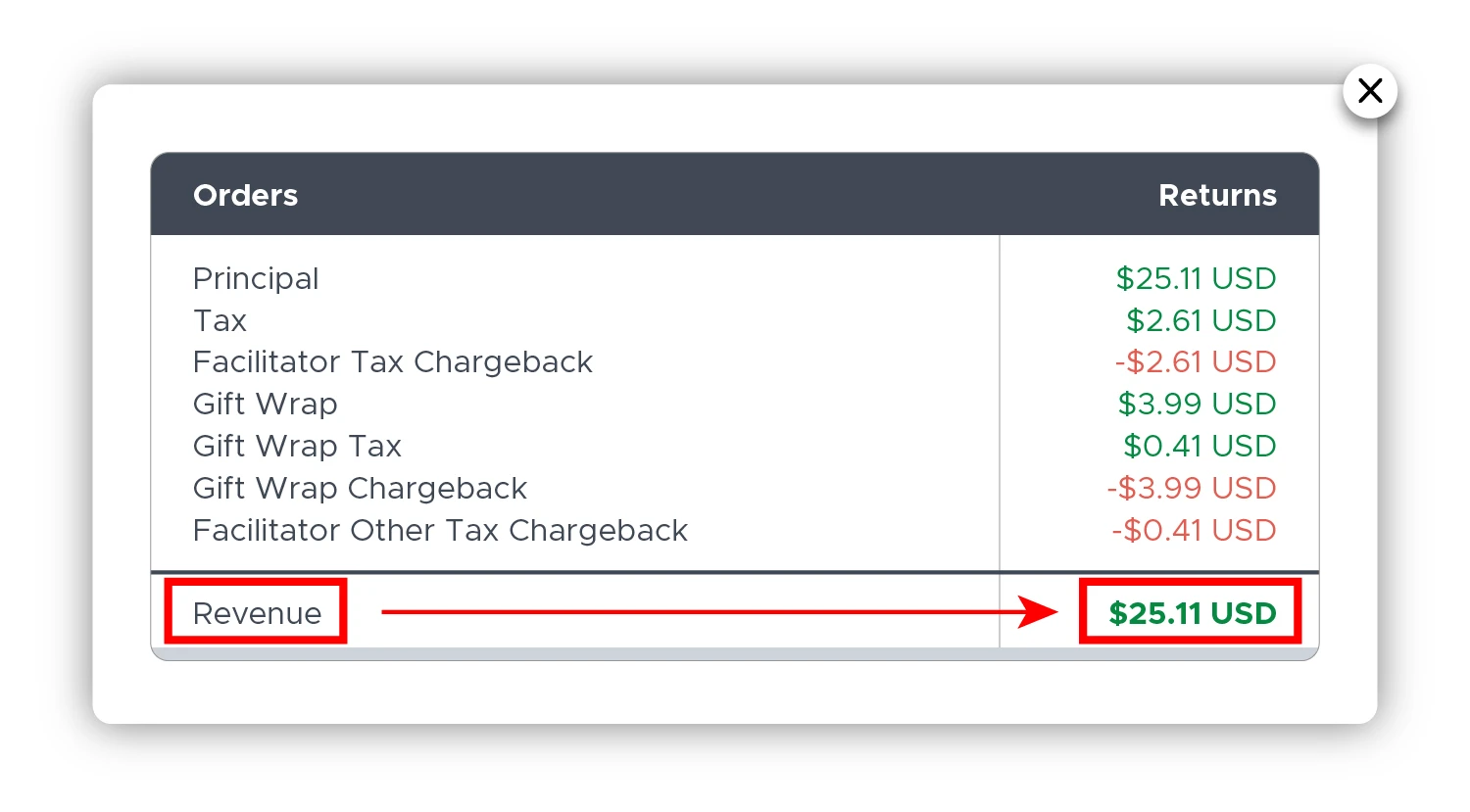
There are other kinds of Marketplace Facilitator Tax Chargebacks: that you may see in your transactions:
MarketplaceFacilitatorTax-Shipping
MarketplaceFacilitatorTax-Other
MarketplaceFacilitatorTax-RestockingFeeMarketplaceFacilitatorTax-Shipping is a chargeback on the Shipping Tax, which Amazon collects and remits on your behalf. It is also called Facilitator Shipping Tax Chargeback.
Here is an example Amazon order you would see via Shopkeeper:
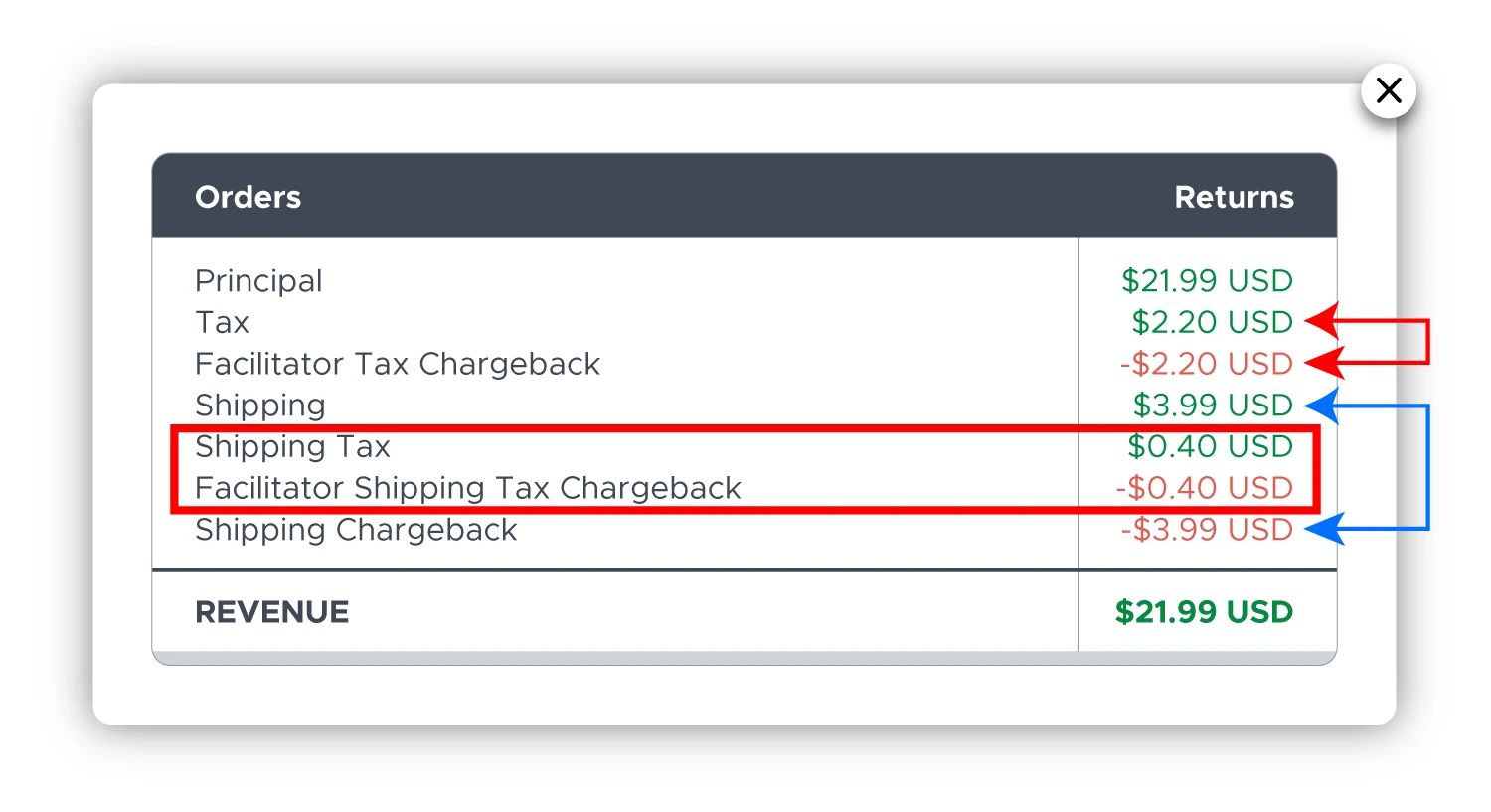
Normally you are the one liable for Shipping Tax - meaning you are the one who has to remit it, EVEN if Amazon is the one doing the shipping. But in this case, the buyer is from one of the states that has automatic tax collection / facilitator agreement with Amazon, so Amazon does not send you the Shipping tax as they normally would - instead, they are keeping it and will remit it on your behalf.
MarketplaceFacilitatorTax-Other is any other type of tax chargeback, which Amazon collects and remits on your behalf. For example, Amazon collects Gift Wrap Tax for you. Then, in the same transaction, you see MarketplaceFacilitatorTax-Other amount:
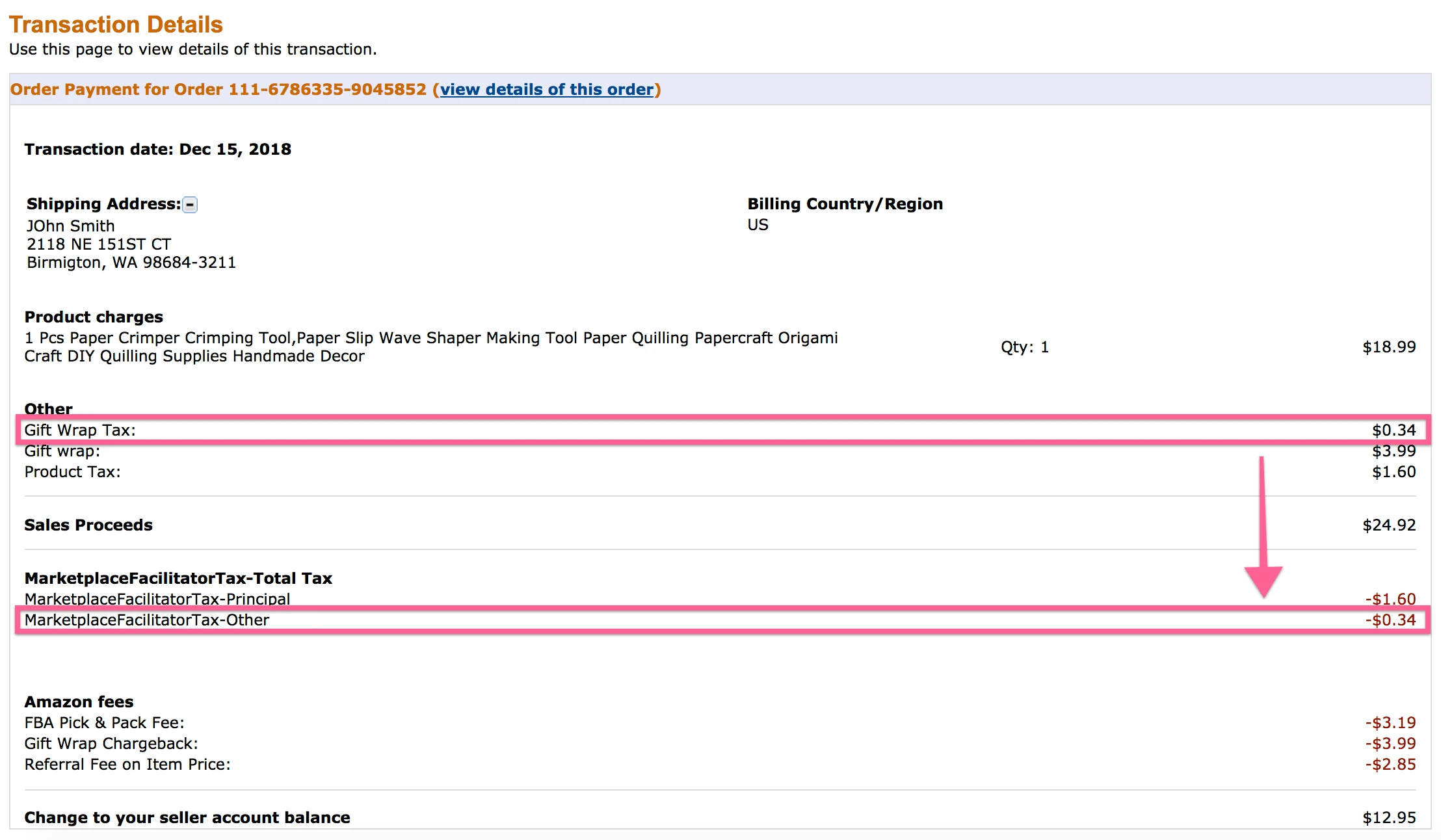
As you see, it is starting to get quite messy and confusing if you try to analyze Seller Central numbers via Order page.
Shopkeeper displays it more organized and does not inflate your revenue with items that have chargebacks in the same Amazon Order:
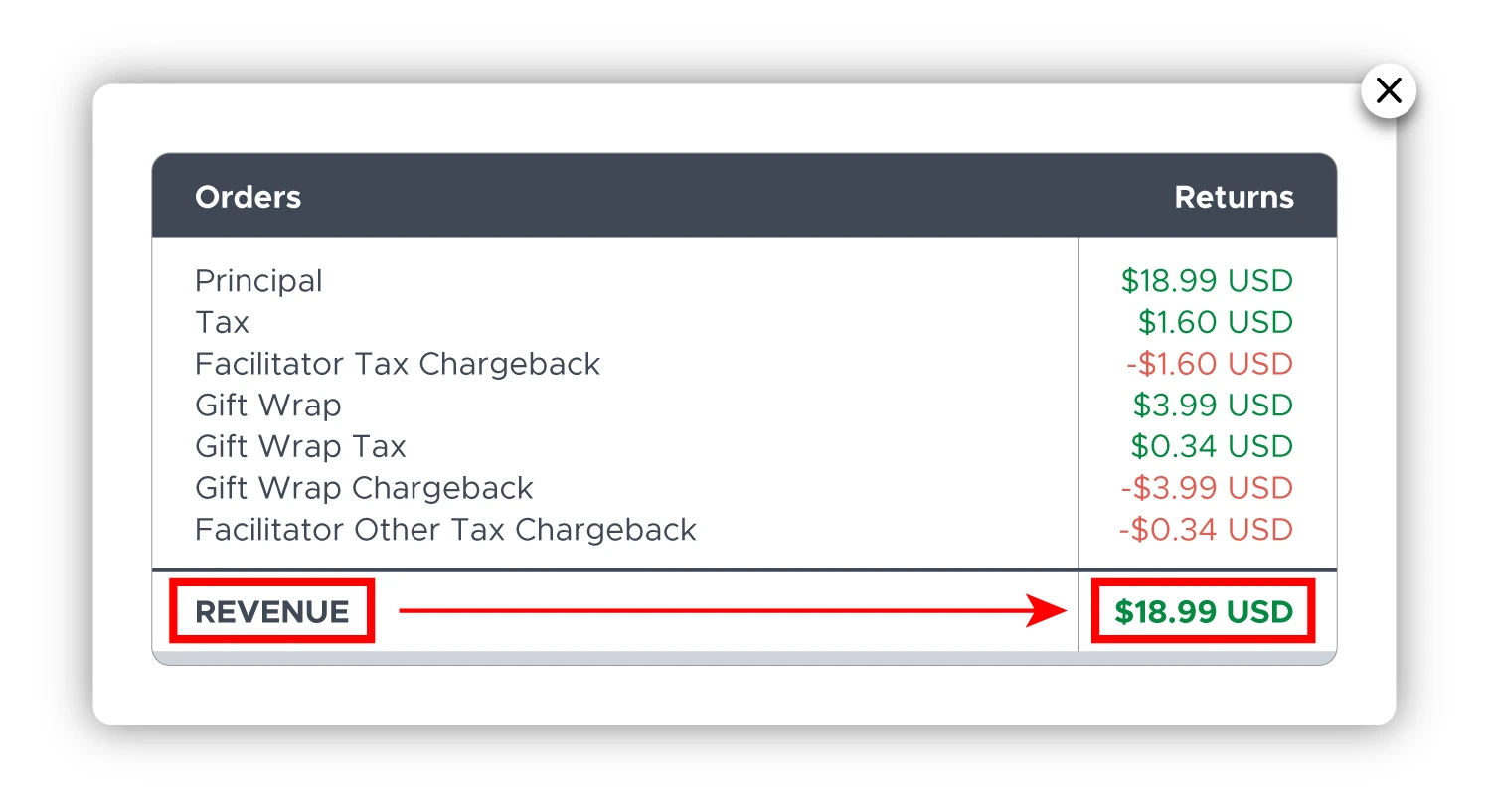
MarketplaceFacilitatorTax-RestockingFee appears in Refunds, which have Restocking Fees.
Seller Central support explains MarketplaceFacilitatorTax-RestockingFee as:
This tax would be charged for an order that a restocking fee was charged on, but not for all Marketplace Facilitator States.
Here is how such situation looks like:
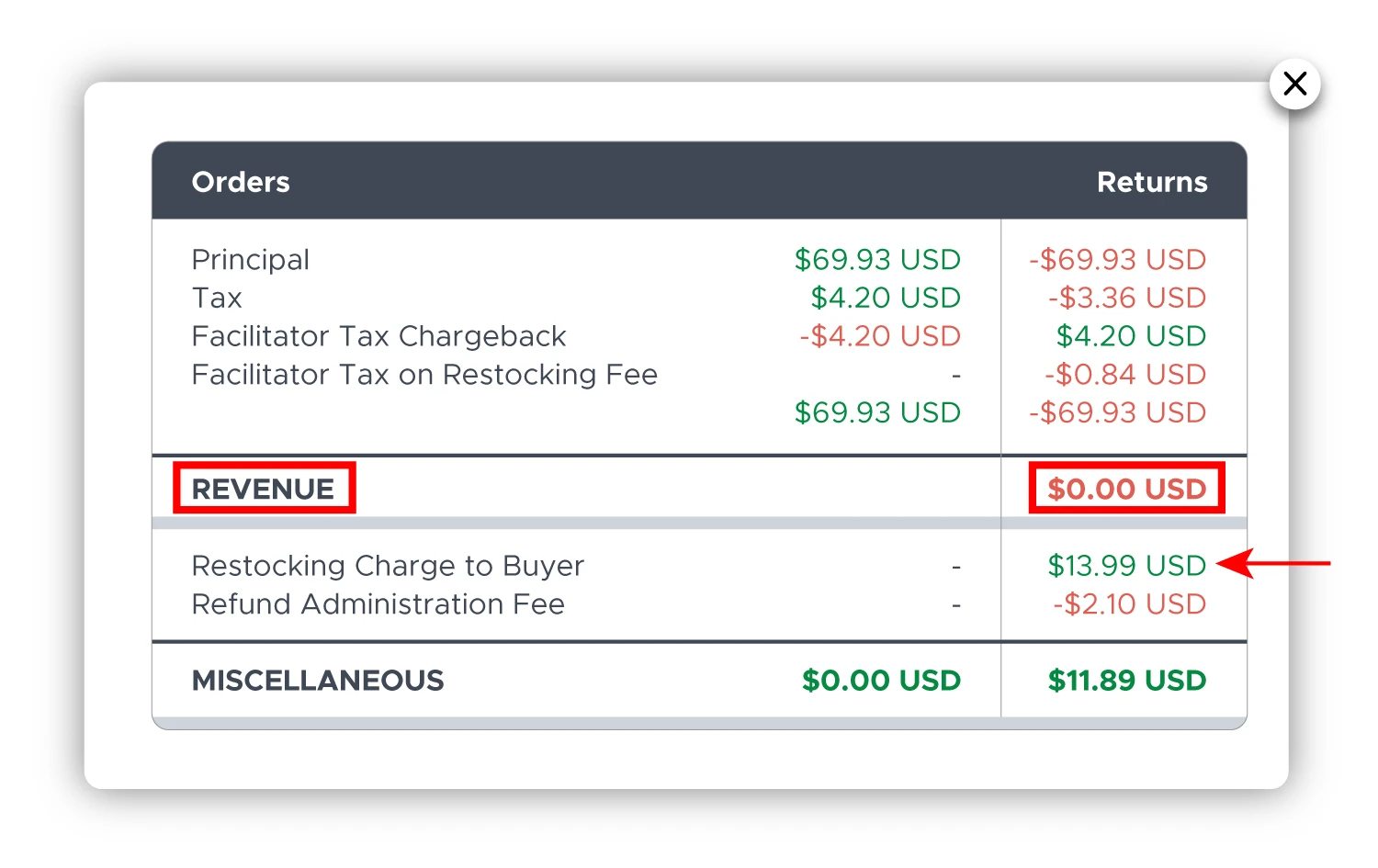
When there is a Restocking Fee charged (with Refund), for some facilitator states instead of full tax refund to buyer, refunded tax is split into two parts, to account for tax on Restocking Fee.
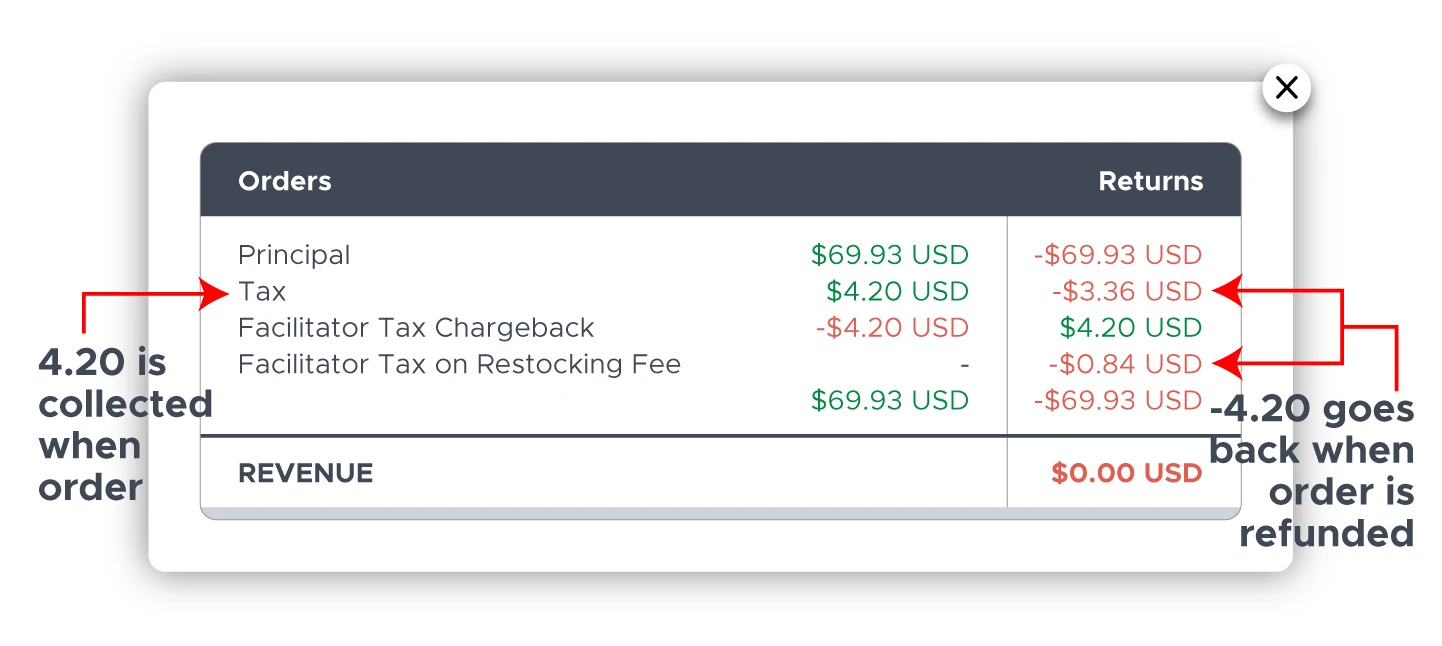
According to Seller Central support, only some states collect tax on Restocking Fee, as per individual state Facilitator Tax agreements between state and Amazon.
Marketplace Facilitator VAT - Principal
MarketplaceFacilitatorVAT-Principal is the VAT (Value Added Tax) added on the primary cost of the product being sold on the marketplace. It covers the item's taxable value, minus any additional fees like shipping or restocking. This guarantees that the fundamental value of the goods is taxed in accordance with local VAT laws.
Learn More about Marketplace Facilitator VAT
Marketplace Facilitator VAT - Restocking Fee
MarketplaceFacilitatorVAT-RestockingFee refers to the VAT applied on the restocking fee imposed when a product is returned. A restocking fee is frequently charged to offset the expense of managing returns, and this price is subject to VAT, guaranteeing that the service of refilling is also taxed.
Marketplace Facilitator VAT - Shipping
MarketplaceFacilitatorVAT-Shipping refers to the VAT imposed on the shipping and handling costs related with delivering the product. It comprises the expense of getting the item to the buyer and ensuring that the delivery service is properly taxed.
MFN Delivery Service Fee
The MFNDeliveryServiceFee is a fee imposed to sellers who uses Amazon's partnered carrier services to transport their items via the Merchant Fulfilled Network. This price covers the cost of using Amazon's chosen carriers to deliver the products, and it is generally lower than ordinary shipping costs. For example, if a seller decides to ship their goods using Amazon's associated UPS service, they will be charged the MFNDeliveryServiceFee for the added convenience.
MFN Postage Fee
MFNPostageFee is the postage cost incurred by sellers when they ship items directly through the Merchant Fulfilled Network (MFN) rather than using Amazon's partnered carriers. This price represents the real cost of postage that sellers pay directly to the postal service or other shipping providers. For example, if a seller purchases postage from the USPS to send an item, the MFNPostageFee represents the amount paid for that postage.
Manage Your Postage Fees
MFN Shipmate Cost
The fees for using the MFN (Merchant Fulfilled Network) Shipmate tool, which helps sellers manage their shipping procedures, are referred to as the MFN Shipmate Cost; this tool can help with tracking shipments, printing labels, and calculating shipping rates for orders that sellers fulfill themselves.
Depending on the particular shipping options the seller selects, the cost may include a variety of shipping-related charges, such as integration or label printing fees. In essence, it is the cost incurred by sellers to use the Shipmate tool to effectively handle their shipping needs.
Misc Adjustment
MiscAdjustment refers to various adjustments in seller accounts, including refunds, fees, and chargebacks. Your account balance may be impacted by these changes, so you should keep an eye on them to maintain accurate financial records.
Multichannel Order Damage
MULTICHANNEL_ORDER_DAMAGED pertains to a refund situation where, if you use Amazon's Multi-Channel Fulfillment (MCF) to send a shipment, and it gets damaged during shipping, you will receive a reimbursement. This process mirrors the refund system for FBA but specifically applies to multi-channel fulfillment. In this scenario, Amazon's logistics system is utilized to fulfill orders from other channels, such as your own website.
Track Damage Charges and Reimbursements Across Orders
Multichannel Order Late
The MULTICHANNEL_ORDER_LATE applies to sellers who use Amazon's Multi-Channel Fulfillment service and send orders later than intended. It promotes prompt fulfillment to ensure customer satisfaction through all sales channels. Retailers should improve their supply chain operations and track order processing timeframes to prevent these fees.
Multichannel Order Lost
MULTICHANNEL_ORDER_LOST is a refund category that applies when you use Amazon's Multi-Channel Fulfillment (MCF) to send a shipment, and it gets lost during shipping. This process is similar to the refund system for FBA but specifically pertains to MCF.
FBA Multitier Per Unit Fee
FBAMultitierPerUnitFee is a fee for items fulfilled through Amazon's FBA service that is determined by the item's size and weight. This includes the costs of choosing, packing, and shipping items from Amazon's fulfillment centers. Items are divided into tiers according to their size (standard or oversize) and weight. Each tier has different fees to reflect the changing expenses of handling and delivering items of different sizes and weights. This multitier structure ensures that costs are proportional to the resources necessary to fulfill each type of product.
Non-subscription Fee Adjustment
NonSubscriptionFeeAdjustment means that Amazon has either overpaid you for something or didn't charge you what they should have, and now they are correcting it.
Here's an example email you may receive along with the Non-subscription Fee Adjustment appearing in your reports:
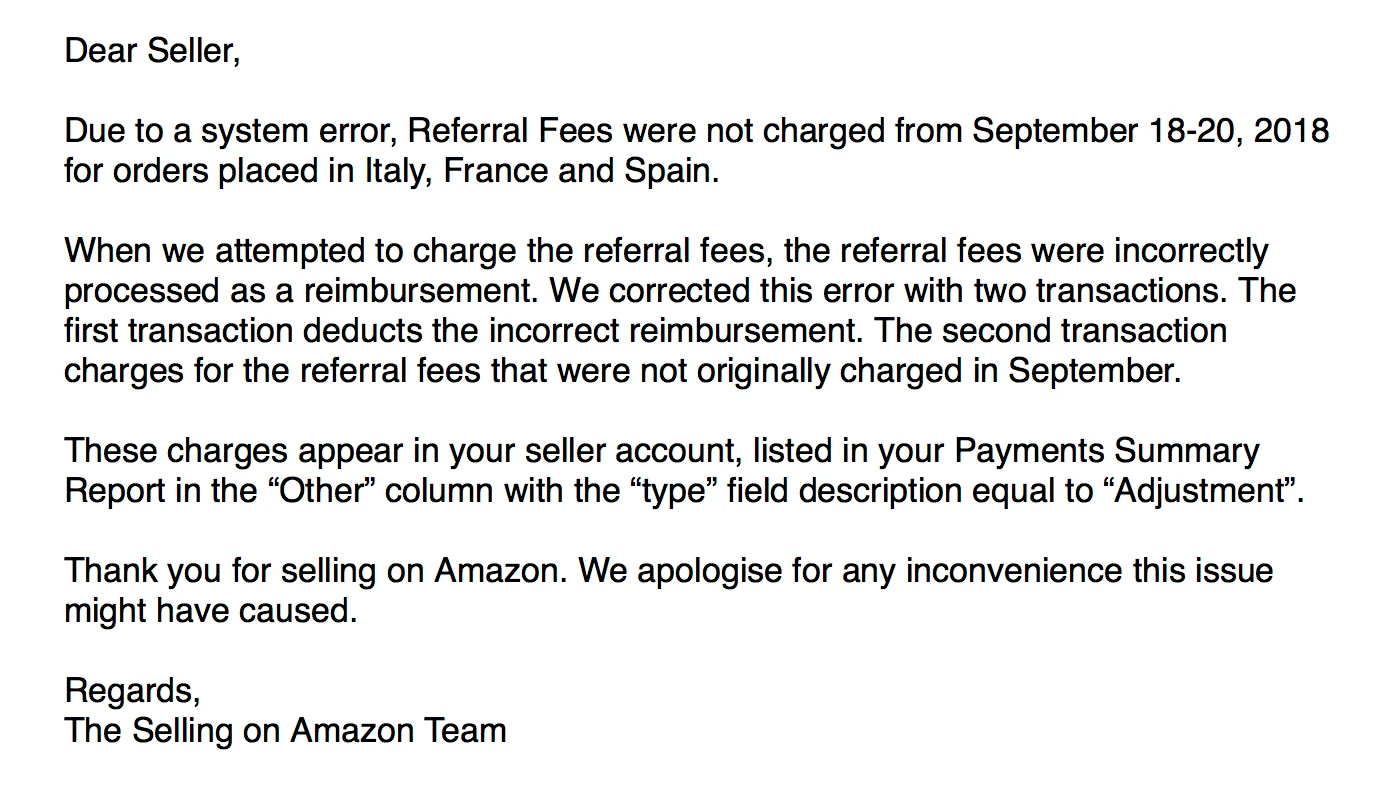
The type of charge that they didn't charge you on time will be different in every case, and often they correct those with appropriately named Adjustments, like PostageRefund_PostageAdjustment, TaxCertificationAdjustment, DebtAdjustment and so on.
But if the disbursement/your payment date has already passed, and they are correcting it after that settlement date, it will appear as Non-subscription Fee Adjustment.
Mostly.
Hehe. Those adjustments are always a bit messy. Each Amazon agent enters them a little differently, so you may have a wide range of all kinds of adjustments during your career as an Amazon seller. Something like this:
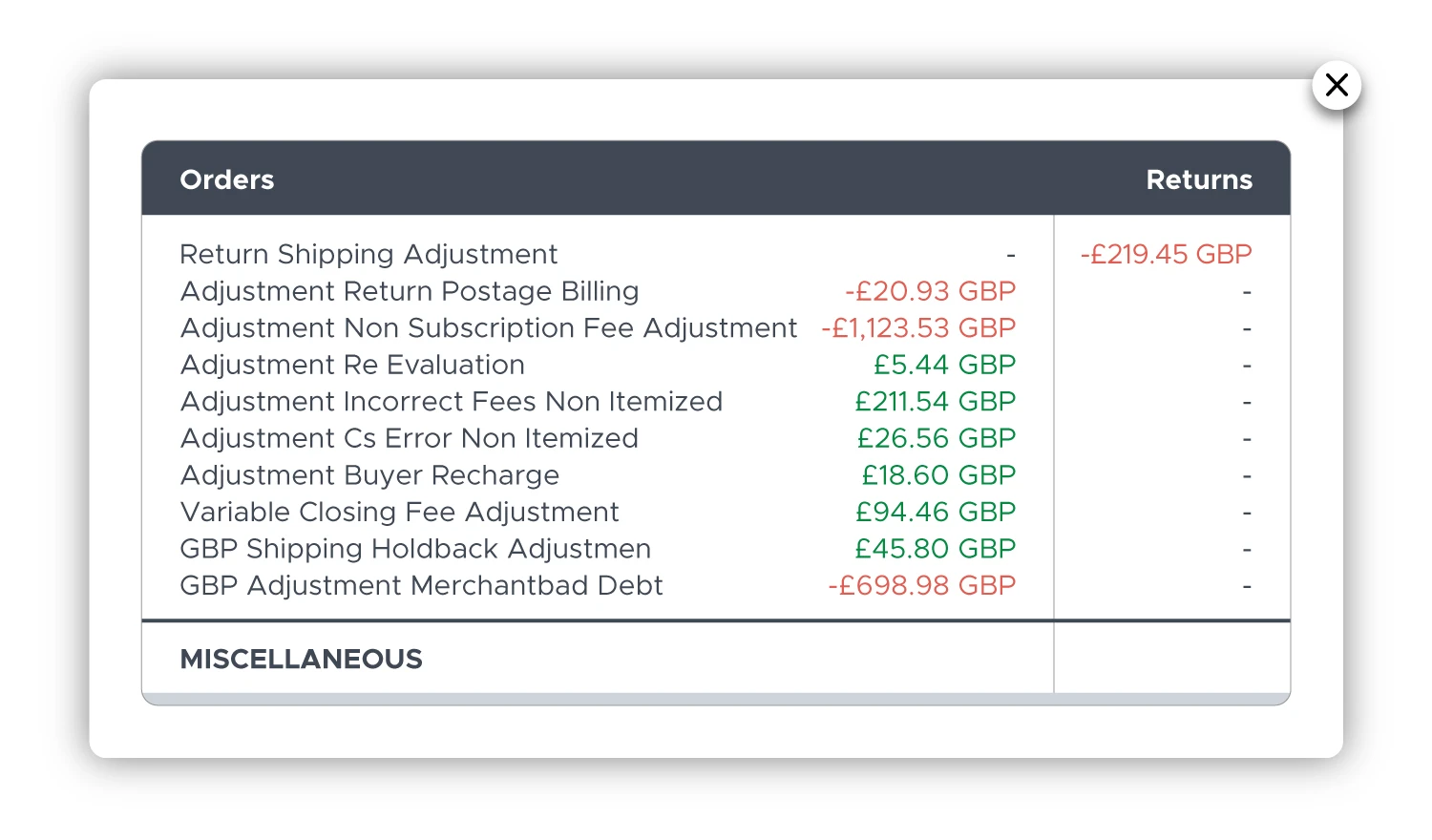
Review Your Fee Adjustments
Opaque Bagging Fee
OpaqueBaggingFee is charged when sellers opt for Amazon to handle the preparation of their products. If, for instance, items are packed in an opaque bag, this fee will be applied. It covers the additional cost associated with specific packaging requirements to meet product guidelines.
FBA Overage Fee
FBAOverageFee is a charge Amazon applies to sellers who store more inventory than they're allowed in Amazon's warehouses. Sellers using Fulfillment by Amazon (FBA) pay for storage based on how much space their inventory takes up and how long it stays there.
If sellers go over their allowed storage limit, they have to pay the FBA Overage Fee. This fee encourages sellers to manage their inventory carefully and avoid storing too much, which can lead to extra costs and affect their profits.
Paid Services Fee
PaidServicesFee encompasses fees paid by sellers for selected services offered by Amazon. These fees are incurred for utilizing various optional services provided by Amazon, such as advertising, premium account features, or additional seller support services.
Payment Method Fee
PaymentMethodFee is an additional charge that applies when specific payment methods are used. It varies depending on the payment type and region and covers transaction processing expenses. This fee is disclosed before checkout, so buyers may notice any additional fees before purchasing. This cost can sometimes be waived due to discounts or unique conditions.
Review Your Payment Method Fees
Payment Retraction Items
PAYMENT_RETRACTION_ITEMS relates to refunds or retractions pertaining to specific products. This sort of retraction gives a full breakdown of the refund amount for each item, making it transparent. It is commonly used in instances involving item returns, cancellations, or changes in which individual goods are refunded. For example, if a customer returns a single item from a multi-item order or an item is discovered to be defective, the refund is handled and invoiced for that specific product.
Payment Retraction Non-Itemized
PAYMENT_RETRACTION_NON_ITEMIZED denotes refunds or retractions that are processed in a lump payment without itemized details. This category is used for general adjustments or credits that are not associated with specific items, such as shipping cost refunds, goodwill credits, and promotional credits. These retractions provide a single sum without a comprehensive breakdown, making them less transparent than itemized retractions. This strategy is appropriate for broader issues that are not related to specific products in an order.
PoA Per Unit Fulfillment Fee
The PoAPerUnitFulfillmentFee on Amazon is the fee charged per unit for fulfilling purchases via the "Prime on Amazon" (PoA) program. This fee supports the costs of handling and processing each product in the program to ensure it satisfies Prime's delivery and service requirements.
POA Service Fee
POAServiceFee refers to a charge associated with the Point of Authorization (POA) service that require additional verification or authorization, such as specific purchases or account modifications. It is transaction-specific, varies by region, and is displayed during the transaction to ensure transparency.
Calculate Your Total Fees
Points Adjusted
Changes to reward or loyalty points are referred to as PointsAdjusted. Additionally, it can highlight changes made during special deals where points are added or removed, as well as when you earn or spend points from rewards programs.
Policy Violation
A Policy Violation fee is a cost incurred by sellers who violate Amazon's rules or regulations regarding their sales. This can occur in a number of circumstances, including the sale of fake goods, infringement of intellectual property rights, and noncompliance with performance indicators such as order defect rates. The purpose of these fees is to protect market integrity and enforce compliance. To prevent additional fines, sellers should keep a careful eye on their accounts and take prompt action to resolve any violations. A seller can often file an appeal through Amazon Seller Support if they think a charge is inaccurate.
Polybagging Fee
When sellers ask for their products to be packaged into polybags, Amazon charges a fee known as the PolybaggingFee. This fee covers the expense of utilizing polybags for packing and is charged per piece. Polybagging helps shield products from dust, moisture, and other environmental variables. Sellers who choose to use polybagging services can make sure their goods stay in perfect condition throughout Amazon's stock.
Postage Billing - Carrier Pickup
Rather than sending the goods to a fulfillment center themselves, sellers that arrange for a carrier pickup service to pick up their shipments from a specified address are charged PostageBilling_CarrierPickup. In essence, it addresses the ease and practicality of scheduling a carrier to pick up the items straight from the seller's location.
See Your Postage Billing Fee Summary
Postage Billing - Congestion Charge
PostageBilling_CongestionCharge comes into play when a package has to be delivered to a congested area, usually in a busy city. It covers the extra hassle and cost for the delivery service to navigate through traffic or pay tolls.
Postage Billing - Delivery Area Surcharge
Amazon charges a fee known as PostageBilling_DeliveryAreaSurcharge in areas where delivery costs are greater than average. Amazon applies an extra fee for deliveries to these particular locations in order to offset the higher shipping costs. Sellers pay this fee, which appears on their billing statements. In essence, it makes sure that vendors pay a fair share of the extra expenses that Amazon bears for shipping to these particular areas. To preserve fairness and transparency in its shipping pricing structure, Amazon takes into account variable delivery costs in different areas.
Postage Billing - Delivery Confirmation
PostageBilling_DeliveryConfirmation is a fee charged by Amazon for providing proof that a shipment has been dispatched. This fee covers the costs associated with generating documentation or electronic confirmation of the shipment's dispatch. It guarantees that merchants have proof of delivery, which is beneficial when settling disputes or comforting clients on their products.
Postage Billing - Fuel Surcharge
The PostageBilling_FuelSurcharge includes the additional cost of fuel consumed during the shipping procedure. It is used to adjust for fluctuations in fuel prices and to pay the higher costs of transportation.
View Full Fee Breakdown
Postage Billing - Import Duty
PostageBilling_ImportDuty refers to customs duties or taxes levied by the destination country on imported products. It is charged for overseas shipment and ensures that local import restrictions are followed.
Postage Billing - Insurance
PostageBilling_Insurance covers potential loss or damage to items during shipment. It is an extra or supplemental fee that protects against financial loss if products are damaged or lost during transit.
Postage Billing - Oversize Surcharge
If your package is too large or bulky, you'll get hit with this surcharge. It’s because oversized items require more space and handling, making them more expensive to ship.
Postage Billing - Postage
PostageBilling_Postage is the basic fee for shipping a package. It’s what you pay for getting your package from point A to point B.
Postage Billing - Postage Adjustment
PostageBilling_PostageAdjustment refers to adjustments made to postage costs for weight or size differences, modifications made to the delivery method, or carrier adjustments made after the item is shipped.
Understand Your Postage Billing Fees
Postage Billing - Signature Confirmation
If you want to make sure that the recipient signs for the package when they receive it, you’ll pay PostageBilling_SignatureConfirmation. It’s a way to confirm that the package was delivered to the right person.
Postage Billing -Tracking
PostageBilling_Tracking is applied to cover the costs associated with providing tracking information, including system maintenance and infrastructure expenses. By utilizing tracking services, sellers can ensure greater transparency and visibility into the status of their shipments, which contributes to improved customer satisfaction and confidence in the delivery process.
Postage Billing - Transaction Fee
PostageBilling_TransactionFee is a charge that covers the administrative costs associated with processing your shipment. This could include handling payment processing, managing account details, or other operational tasks that keep the shipping process smooth and efficient. It's essentially a small fee to cover the behind-the-scenes work that goes into handling your transaction.
Postage Billing - VAT
VAT stands for Value Added Tax, and it’s a tax on the postage cost. Depending on where you’re shipping from or to, you might have to pay PostageBilling_VAT as part of the overall cost of shipping.
Postage Refund - Carrier Pickup
PostageRefund_CarrierPickup to a refund you might get when a carrier pickup service you paid for didn’t happen as expected. For example, if you scheduled a pickup for your package and the carrier failed to show up or there was some other issue, Amazon may refund the fee you paid for that service.
Review Your Postage Fees
Postage Refund - Congestion Charge
PostageRefund_CongestionCharge comes into play when you were charged for delivering a package to a congested area, like a busy city center, but it turns out the charge wasn’t justified. Maybe the delivery didn’t actually happen in a congested zone, or there was an error in applying the charge. In such cases, Amazon might refund you the congestion fee.
Postage Refund - Delivery Area Surcharge
If you were charged extra for shipping to a remote or difficult-to-reach area, but that charge was applied incorrectly, Amazon may issue a PostageRefund_DeliveryAreaSurcharge. This refund would cover the surcharge that was meant to compensate for the extra effort and cost involved in delivering to that specific location.
Postage Refund - Delivery Confirmation
PostageRefund_DeliveryConfirmation relates to situations where you paid for delivery confirmation—meaning you wanted proof that your package was delivered—but something went wrong. If the confirmation service wasn’t provided as promised, or if there was a mistake in the process, Amazon might refund the fee you paid for this extra service.
Postage Refund - Fuel Surcharge
PostageRefund_FuelSurcharge is a reimbursement for additional fuel-related expenses that were added to the delivery fee. For example, during periods of high fuel prices, delivery firms may charge a fuel surcharge, which is refundable if the order is returned.
Calculate Your Total Shipping Fees
Postage Refund - Import Duty
PostageRefund_ImportDuty includes any import fees or taxes that were paid when an item was brought into your country from overseas. If you return the item, Amazon may refund the charges.
Postage Refund - Insurance
PostageRefund_Insurance is a reimbursement for any shipping insurance you may have paid for. Shipping insurance protects against damage or loss in transit, and if you return the goods, the fee may be refunded.
Postage Refund - Oversize Surcharge
If your order had an additional fee for being oversized, PostageRefund_OversizeSurcharge would cover it. Oversized items frequently incur higher shipping costs, which may be reimbursed if returned.
Postage Refund - Postage
PostageRefund_Postage is merely a refund of the basic postage or delivery price you paid when you ordered the item. If the item is returned or there is an error, Amazon may refund the amount paid for it.
Postage Refund - Postage Adjustment
PostageRefund_PostageAdjustment refers to adjustments in postage costs that occur when a refund is given, usually because of returned goods or mistakes in the initial order.
Explore Your Postage Adjustments
Postage Refund - Signature Confirmation
PostageRefund_SignatureConfirmation is the cost that will be refunded if the item is returned if you paid extra for signature confirmation upon delivery. Signature confirmation guarantees that the package is delivered directly to the recipient rather than left unattended.
Postage Refund - Tracking
PostageRefund_Tracking applies to the cost of tracking your package. Tracking allows you to track the shipment's progress and determine its delivery status. If an order is returned or canceled, the charge for this service may be refundable.
Postage Refund - Transaction Fee
If your purchase included a transaction fee, such as a credit card processing fee, your refund will reimburse that amount in the event of a return and it is called PostageRefund_TransactionFee.
Postage Refund - VAT
PostageRefund_VAT is a refund of the VAT you paid on your purchase. If you return the item, Amazon may refund the VAT.
See Your VAT Breakdown
Premium Experience Fee
This is an additional fee that covers benefits such as quicker shipping, access to exclusive products, or exceptional customer service. For example, if you select expedited shipping or special handling for your item, the PremiumExperienceFee would reflect the cost of these additional perks. If the item is returned or the service does not meet expectations, this cost may be refundable.
Prep Fee Refund
PREPFEE_REFUND involves refunds related to shipment preparation. Sellers may opt for Amazon to handle the preparation of their products, which can include tasks such as bubble wrapping fragile items, applying barcode labels, adding warning stickers or extra labels, and repackaging adult products discreetly. If any issues arise in this preparation process, a refund may be provided.
Pricing Error
When a product's price is displayed incorrectly, it's called a PricingError. This can happen for a number of reasons, including obsolete information, improper seller input, or technical difficulties with the system. Discrepancies may also result from problems with promotional pricing. Errors are usually the seller's fault; they can choose to either honor the wrong pricing or cancel the order. If an order is canceled, buyers are not billed, and if the item is fulfilled at the incorrect price, the seller bears the loss. Most of the time, these mistakes are made accidentally and are quickly fixed.
Prime Wardrobe Reimbursement
PRIME_WARDROBE_REIMBURSEMENT is a reimbursement given to sellers for products returned by customers after using the Amazon Prime Wardrobe service, guaranteeing that sellers are reimbursed when customers decide not to purchase the things they tried on.
See If You’re Owed Money
Prime Wardrobe Reimbursement Manual
PRIME_WARDROBE_REIMBURSEMENT_MANUAL is a manual reimbursement issued to sellers for returned items under the Prime Wardrobe program. It compensates for losses or adjustments related to customer try-before-you-buy returns.
Principal
| Principal is also called item-price, Product charges |
|---|
Principal Amount is what Amazon calls the main bulk part of the price that customer pays for your product, before shipping and taxes. Most often this amount is the same as the price your customer paid.
When your price includes sales tax (such as VAT), then your Principal is Price minus the Sales Tax. Amazon separates the two to later show Sales Tax as a separate item in your transaction details:
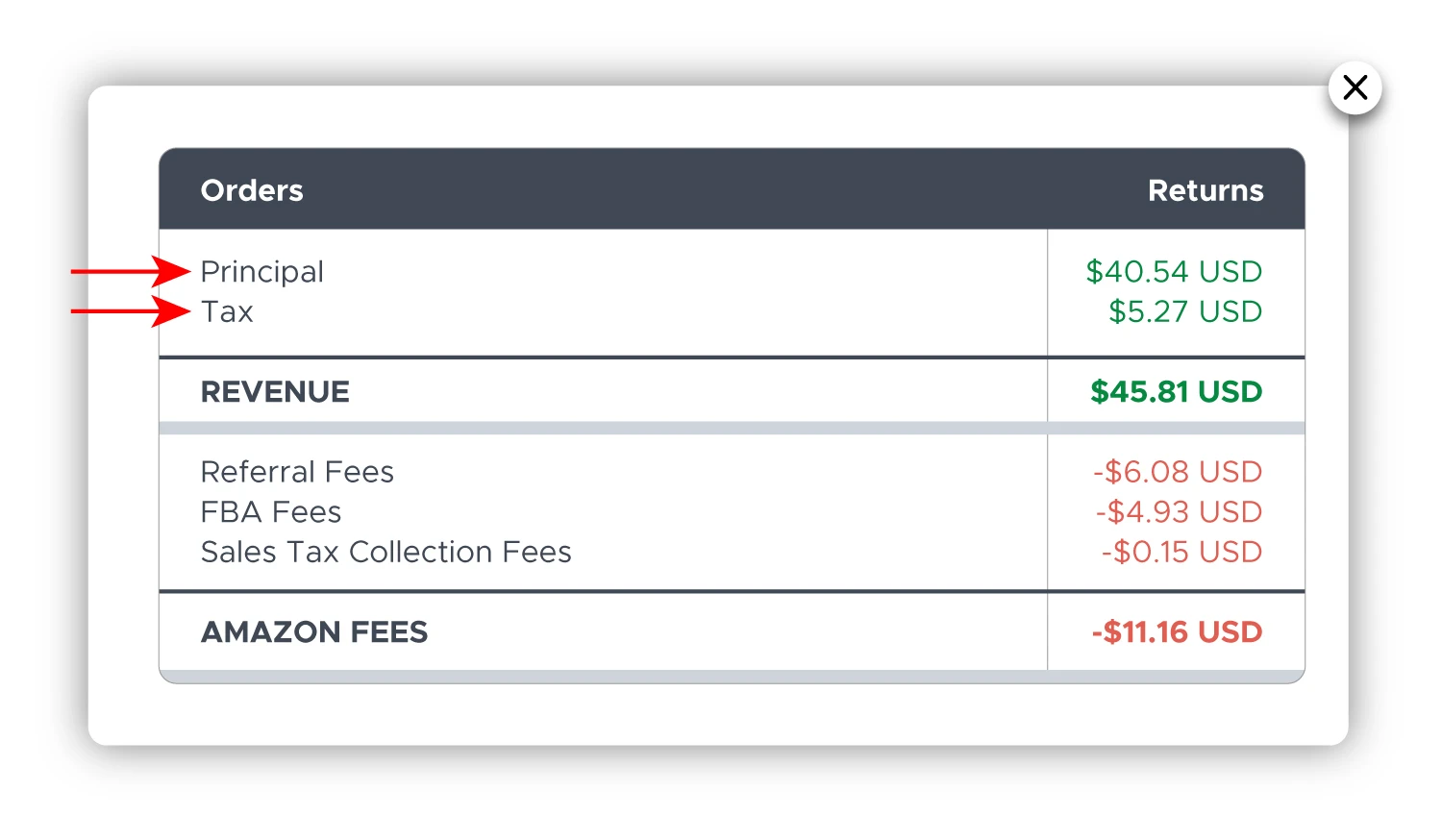
Product Cost VAT
This is the Value Added Tax (VAT) that is applied to the product's actual cost. It's a tax that gets added to the cost of the item you're buying. When you see "Product cost VAT," you may be sure that the VAT has been applied to the base price of the product, not to any extra costs like shipping or handling.
Product VAT
Product VAT is used to describe the whole value of VAT applied to the product, including any additional services related to the purchase of the product, such as shipping, handling, or special packaging costs. But in a lot of cases, this might just be a more straightforward interpretation of Product cost VAT.
Understand Your VAT Obligations
Production
Unless you're looking at services related to on-demand production (like custom-made goods), Production usually wouldn't appear as a charge. This is used to describe the price of labor, raw materials, and other manufacturing-related costs. However, unless you're working with a seller who creates custom things, this word is less likely to be directly tied to VAT or customer-facing prices.
Promotion Meta Data Definition Value
PromotionMetaDataDefinitionValue displays buyer discounts and the corresponding discount action name, making it clear which promotions are applied during the transaction.
Promotions
A promotion is the price or expense incurred when discounts, offers, or coupons are used to increase sales. This fee is incurred when consumers use coupons, buy one, get one free deals, or percentage-off promos. Additionally, it may include one-time costs for taking part in promotions such as Lightning Deals or offering free shipping. These fees display in your transaction details in Seller Central under the promotional category and are subtracted from your sales earnings.
ReCommerce Grading And Listing Charge
ReCommerceGradingAndListingCharge is a fee that sellers pay when Amazon rates and lists used or refurbished items on their behalf. For example, if a seller sends in used electronics to be sold through Amazon's ReCommerce program, Amazon will grade the products and generate product listings. The ReCommerceGradingAndListingCharge covers the cost of this service, and it is deducted from the seller's proceeds.
ReCommerce Grading And Listing Refund
ReCommerceGradingAndListingRefund is a refund issued when returned items are processed through Amazon's ReCommerce program. It may relate to item grading (condition evaluation) or listing discrepancies during resale.
Re-Evaluation
When a seller seeks a re-evaluation of their account or performance after resolving prior complaints, a fee known as RE_EVALUATION may be imposed. The administrative expenses related to examining the seller's case and deciding whether or not they can keep selling on the platform may be covered by this fee. This fee may be incurred as part of the re-evaluation process if a seller feels that after making the required adjustments, their account should be restored or enhanced. Before asking for a re-evaluation, sellers should make sure they have sufficiently resolved any previous complaints and comprehend the rationale for the charge.
Referral Fee
| Referral Fee is also called Commission, ReferralFee on Item Price, referral-fee-per-item |
Referral fee is a core fee, charged to all 3rd party sellers selling on Amazon. Amazon charges you a percentage of sales, and in exchange they allow you to use their online marketplace.
For example, if you sell a pet supplies item for 10 USD, Amazon will charge you 1.50 USD referral fee (which is 15% for Pet Supplies). You are essentially paying for the privilege of being listed on Amazon Marketplace, getting traffic and exposure, while you do almost nothing, apart from listing your item to sell. It’s like Amazon is your affiliate, and you pay them a commission on every sale that they bring you.
Referral Fee percentage can vary. Most product categories are charged 15%, but it can be as low as 6% or as high as 45% in some categories.
A few examples:
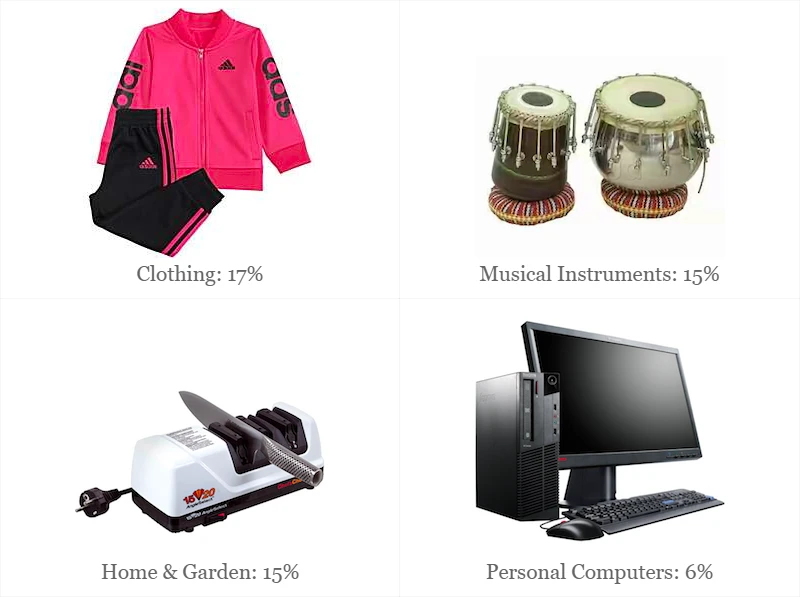
You can find most up to date referral fees for each category here:
Seller Central North America - Referral Fees
Seller Central Europe - Referral Fees
Evaluate Your Referral Costs
Refund Admin Fee
When merchants give refunds to customers, Amazon charges an administrative fee known as the Amazon RefundAdminFee. This charge compensates Amazon for the administrative expenses related to managing the refund procedure. It varies according to the type of goods and the portion of the item's cost that is reimbursed. There is no fee for 100% refunds on books, music, video, and DVD products; however, for other categories, the maximum return amount is $5 or 20% of the referral income. Because this cost affects their revenue and profitability on the platform, sellers should be aware of it.
Refund Commission
RefundCommission on Amazon is the percentage of sales commission that Amazon keeps in case a customer wants a refund for a product they bought on the website. Usually, this commission is equal to 20% of the seller's initial sales commission. This deduction helps cover the administrative costs associated with processing refunds and managing customer returns.
Region Shipping Amount
The cost of shipping goods to particular regions or areas within a country is known as the region_shipping_amount charge, and it can change depending on a number of variables, including the shipping method selected, the seller's shipping policies, and the distance between the buyer's location and the seller's location.
The region_shipping_amount is the charge associated with the cost of shipping an item to a specific area, reflecting the seller's shipping strategy and the logistics involved. It helps customers understand the additional shipping fees that may apply when purchasing items, especially for sellers who operate in different regions with varying shipping costs, and it guarantees that customers are informed about the total shipping expenses during the checkout process.
Regulatory Fee
RegulatoryFee covers the costs of complying with legal and regulatory requirements for transactions. This charge includes the costs of complying with local laws and taxes, as well as administrative costs for managing the paperwork and processes required by regulatory agencies. It guarantees that transactions follow regulations, resulting in a smooth and compliant experience for both buyers and sellers.
Reimbursement Clawback
Reimbursement clawback occurs when Amazon reverses or withdraws a previously granted reimbursement to a seller. This frequently occurs when the reimbursement is discovered to be erroneous or if the original issue was resolved differently. For example, if a seller was reimbursed for a lost item but the item was later discovered and delivered, Amazon might initiate a ReimbursementClawback to recover the initial reimbursement amount from the seller.
Check Our FAQ on Reimbursement Fees
Remote Fulfillment Credit
RemoteFulfillmentCredit is a credit provided when sellers use Amazon's Remote Fulfillment with FBA program to reach international customers. It may offset some of the costs associated with cross-border logistics or tax adjustments.
FBA Removal Fees
FBARemovalFee is the charge for removing slow moving inventory from the Amazon FBA warehouse and sending it back to you. The SUS marketplace fee schema can be found here.
Removal Order Damaged
REMOVAL_ORDER_DAMAGED is provided when Amazon causes damage to your items during the processing of a removal order request.
Removal Order Lost
If you request Amazon to return FBA goods to you and they get lost in the process, Amazon will reimburse you with a credit note called REMOVAL_ORDER_LOST. To ensure reimbursement, check that the quantity you requested matches what you receive. Amazon often sends units in separate boxes from different fulfillment centers, so wait for the "removal order complete" email before counting and requesting reimbursement if needed. This ensures you are compensated for any lost items during the removal process.
Renewed Program Fee
The Amazon Renewed program, which offers certified refurbished and pre-owned products, charges a fee to participating merchants called the RenewedProgramFee. The costs of participating in the program, such as product certification and quality control, are covered by this charge.
Reserve Credit
ReserveCredit refers to funds that Amazon temporarily sets aside from a seller's account. This reserve is used as a precautionary measure to cover potential issues like refunds or chargebacks that may arise from customer transactions. It helps ensure there are adequate funds available to manage these situations promptly without impacting the seller's ability to fulfill orders or maintain customer satisfaction.
The amount and duration of the reserve credit can vary based on factors such as the seller's sales volume, transaction history, and performance metrics on Amazon. It's important for sellers to understand that reserve credits are not fees deducted from their account but rather a temporary hold on a portion of their funds to mitigate financial risks associated with selling on Amazon. Sellers can view and manage their reserve status through their Amazon Seller Central account and contact Amazon Seller Support for any specific inquiries or assistance regarding reserve credits.
Manage Your Reserve Credit
Reserve Debit
ReserveDebit refers to the deduction of funds from a seller's reserved account. This deduction occurs when Amazon uses these reserved funds to cover refunds, chargebacks, or other financial obligations related to customer transactions.
Amazon maintains reserves as a precautionary measure to ensure there are enough funds available to handle potential issues without affecting customer satisfaction or violating Amazon's policies. When a reserve debit happens, it means Amazon is drawing from these reserved funds to settle financial responsibilities arising from transactions on its platform. Sellers can monitor their reserve account status through Amazon Seller Central and contact Amazon Seller Support for any inquiries about reserve debits or their account's financial activity.
Restocking Fee
RestockingFee is a charge that sellers may deduct from a customer's refund when an item is returned. It helps to offset the costs of inspecting, repackaging, and reselling returned merchandise. This fee applies in specific situations, such as when:
-
The buyer changes their mind (for example, ordered the incorrect item).
-
The item was opened, used, or returned in a different condition.
-
The return is made outside of the allowed return period.
-
The item is missing components or packaging.
Amazon limits the restocking cost to 20% for opened items and 50% for seriously damaged or incomplete returns. Restocking fees are often waived for defective or faulty items.
Return Postage Billing - Carrier Pickup
ReturnPostageBilling_CarrierPickup covers the expense of a carrier picking up a returned item from the customer's location and is paid by the seller at the time the return is started.
Return Postage Billing - Delivery Area Surcharge
ReturnPostageBilling_DeliveryAreaSurcharge is imposed for returns that require delivery to or pickup from remote locations, with the seller covering the additional carrier surcharge.
Understand Your Delivery Fees
Return Postage Billing - Delivery Confirmation
ReturnPostageBilling_DeliveryConfirmation is used to ensure that a returned item has been handed back to the seller, who is responsible for paying it as part of the return procedure.
Return Postage Billing - Fuel Surcharge
ReturnPostageBilling_FuelSurcharge is an additional charge that shipping carriers add to the cost of return shipping to offset their variable fuel costs.
Return Postage Billing - Oversize Surcharge
ReturnPostageBilling_OversizeSurcharge applies when a returned item exceeds a specific size or weight limit, as it incurs additional shipping or handling fees.
Ex.: If a client returns an oversize item such as a large piece of furniture or a television, Amazon may charge an "Oversize Surcharge" to offset the additional shipping and handling costs associated with large items.
Return Postage Billing - Postage
ReturnPostageBilling_Postage is the typical postal rate for return shipping costs. When a buyer returns a goods, Amazon charges the seller or the customer for the cost of postage.
If a customer returns a pair of shoes, the seller may be charged a standard return postage fee to cover the expense of transporting the item back to Amazon's warehouse.
See How Return Postage Billing Fees Affect Your Profit
Return Postage Billing - Postage Commission
ReturnPostageBilling_postage_commission indicates Amazon's compensation for the shipping cost itself. In some cases, Amazon may charge a modest commission in addition to the postage, reflecting their involvement in organizing and processing the return.
If an item's return postage cost is $5, Amazon may charge a modest fee on top of that (5-10%), resulting in the seller paying somewhat more to cover Amazon's administrative role in arranging the return.
Return Postage Billing - Tracking
ReturnPostageBilling_Tracking covers the expense of attaching tracking to the return package, which ensures that the return is traceable throughout the logistical process.
If a buyer returns a costly item, such as a smartwatch, Amazon may charge a tracking fee to ensure the return is tracked throughout the shipping process. This would be an additional charge levied against either the client or the seller.
Return Postage Billing - Transaction Fee
ReturnPostageBilling_TransactionFee is a fee for completing the return transaction itself. It is normally charged to cover the costs of managing the return, processing the refund, and handling the logistics of the transaction.
For each return transaction, such as returning a kitchen appliance, Amazon may charge the seller a fixed transaction fee to cover administrative and processing costs.
Return Postage Billing - VAT
ReturnPostageBilling_VAT includes the Value-Added Tax (VAT) on the return shipping fee. In locations where VAT is applicable, Amazon may charge VAT in addition to return postage, depending on local tax legislation.
If a customer returns a purchase from a European country and the return postage costs $10, Amazon may charge a 20% VAT (depending on the country), bringing the total return postage billing to $12.
Get Insights into Your VAT Rates
Return Shipping
The costs associated with a buyer returning purchased items are known as ReturnShipping. This includes any shipping fees that the buyer may have to pay when sending items back. The responsibility for these costs can vary based on the seller's return policy, with the buyer potentially bearing all, some, or none of the expenses. Understanding return shipping policies is essential for both buyers and sellers, as they significantly influence customer satisfaction. To enhance sales and build trust, many sellers who offer free returns choose to absorb the return shipping costs.
Reversal Reimbursement
When Amazon reverses a previous refund or reimbursement given to a seller, this is known as REVERSAL_REIMBURSEMENT. This usually occurs when the initial reimbursement was made incorrectly or when the matter is later settled in a different way. For instance, Amazon might reverse the original payment if they refund you for a lost inventory item but later locate it and put it back in your stock. In a similar vein, Amazon may reverse the refund if a consumer dispute is settled, such as when a damaged item is returned in acceptable condition. Other situations include disagreements over chargebacks that were first determined to be in your favor but are later reversed, or reimbursements that are determined to be redundant or unneeded. These transactions are recorded in Seller Central's payments and reimbursements section.
Run Lightning Deal Fee
RunLightningDealFee covers the expenses of participating in a blitzdeal. To run a lightning deal, you pay $150 for a 6-hour promotion of your product. If you cancel before the sale period, there's no charge, but cancelling during the sale incurs the full fee.
While the usual cost is $150, it can vary based on the country and chosen week. Running a deal in high-traffic countries during holidays may increase the fee. For instance, hosting a lightning deal during the busy week of Black Friday and Cyber Monday costs $300 due to higher demand. During this period, the promotion window has also extended to 12 hours, providing more value for the fee.
SAFET Reimbursement Charge
SAFETReimbursementCharge is a charge related with Amazon's SAFE-T (Seller Assurance for eCommerce Transactions) claims process. This process is intended to safeguard customers and sellers in specific situations, such as when a buyer alleges a product is defective, damaged, or not as advertised and requests a refund. If a seller is found to be liable for the problem after Amazon evaluates the case, the seller may be refunded for the item but will also be charged this fee to offset the reimbursement costs.
In essence, a chargeback occurs when Amazon concludes that the seller is accountable for a refund issued to the buyer. The charge ensures that Amazon or the customer be reimbursed for the claim's costs.
Check Your Reimbursement Eligibility
Sales Commission
Sellers pay a fee known as the SalesCommission for each sale; this fee is usually expressed as a percentage of the entire selling price, including delivery. Amazon receives payment for the marketplace and associated services from this fee. The percentage is subtracted from the seller's profits and fluctuates depending on the product category. It's critical for sellers to comprehend this fee in order to precisely calculate their revenues.
Sales Tax Collection Fee
Amazon charges this fee for collecting and remitting sales tax on behalf of sellers in jurisdictions where marketplace facilitator laws apply. It supports compliance with state and local tax regulations and may appear multiple times for different tax events.
Sales Tax Service Fee
| Sales Tax Service Fee is also called Sales Tax Collection Fee, SalesTaxCollectionFee |
|---|
Sales Tax Service Fee is charged when Amazon collects sales tax on behalf of you, the seller - but does not remit it. Instead, they send it to you together with payment and you are the one who will be remitting it to the authorities.
This fee is normally 2.9% of collected sales tax amount. See up to date fees here.
Here is how you will see Sales Tax Collection Fee displayed on Amazon Seller Central:
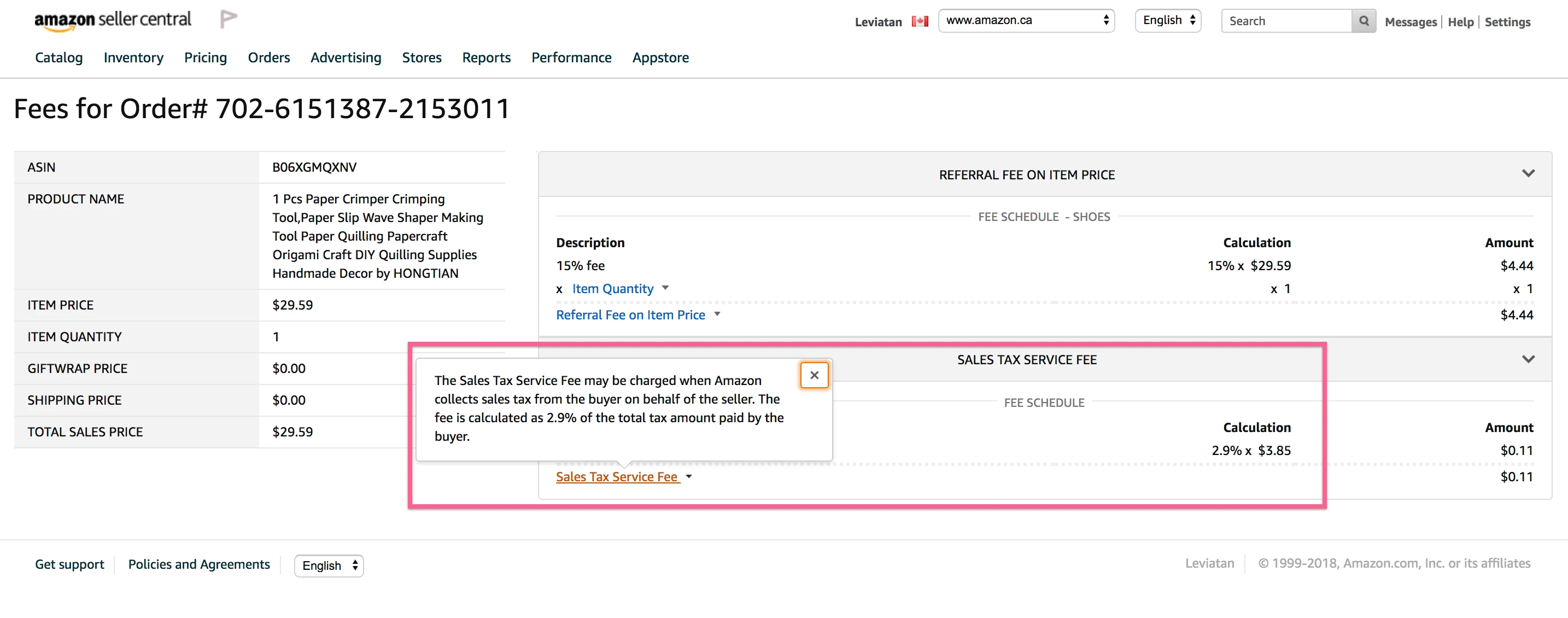
For Amazon to know that you want them to collect sales tax for you, you need to indicate this in your settings:
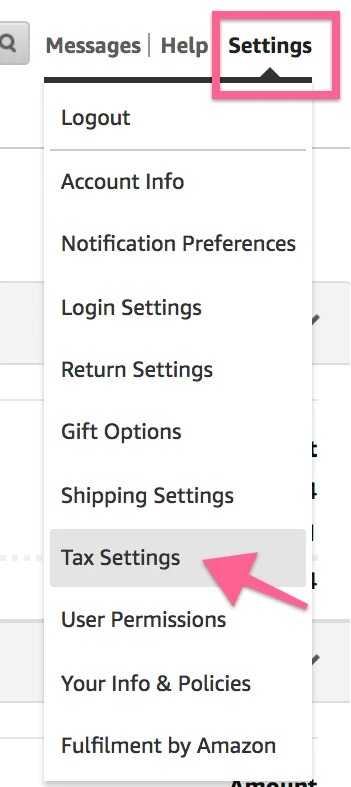
And then indicate what % of sales tax you want to be collecting, for which regions - all depending on your individual situation. If you are incorporated in Canada, you will have to collect HST from all Canadian buyers. If you have an LLC in Idaho, you will have to collect sales tax from all Idaho customers, and so on.
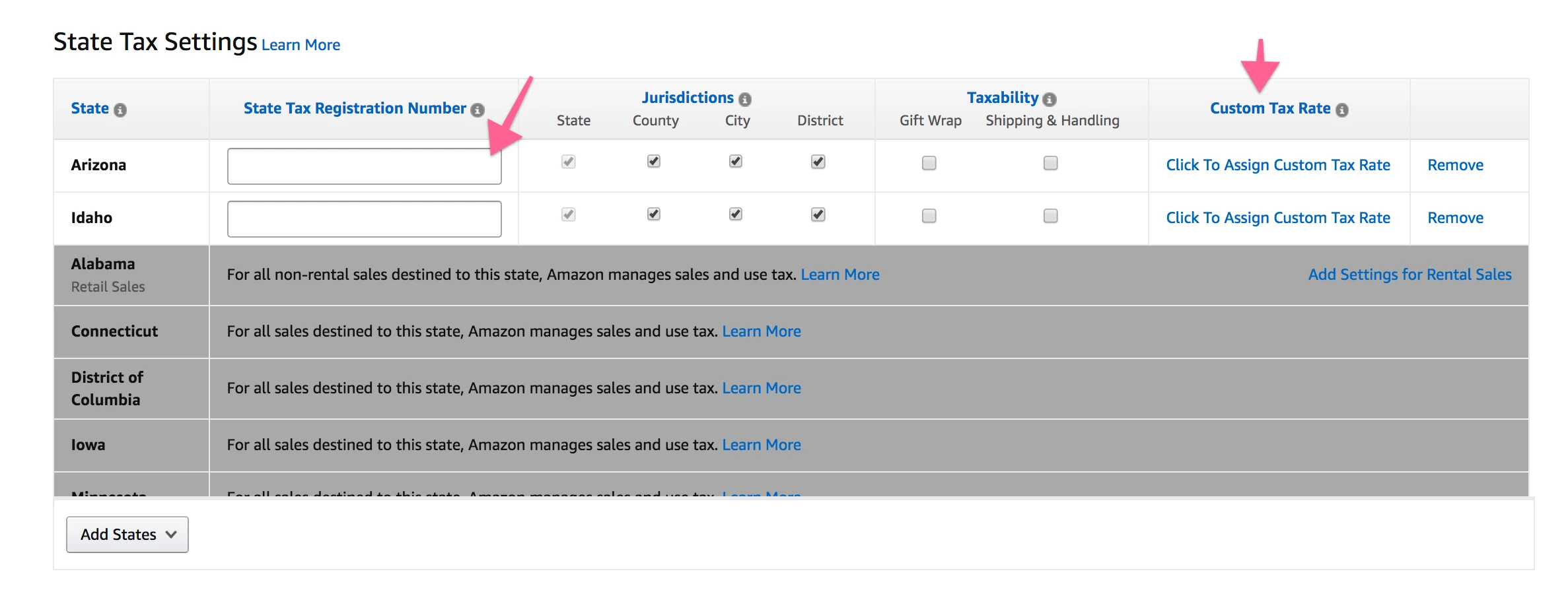
Shopkeeper will show you Sales Tax Collection Fee like this:
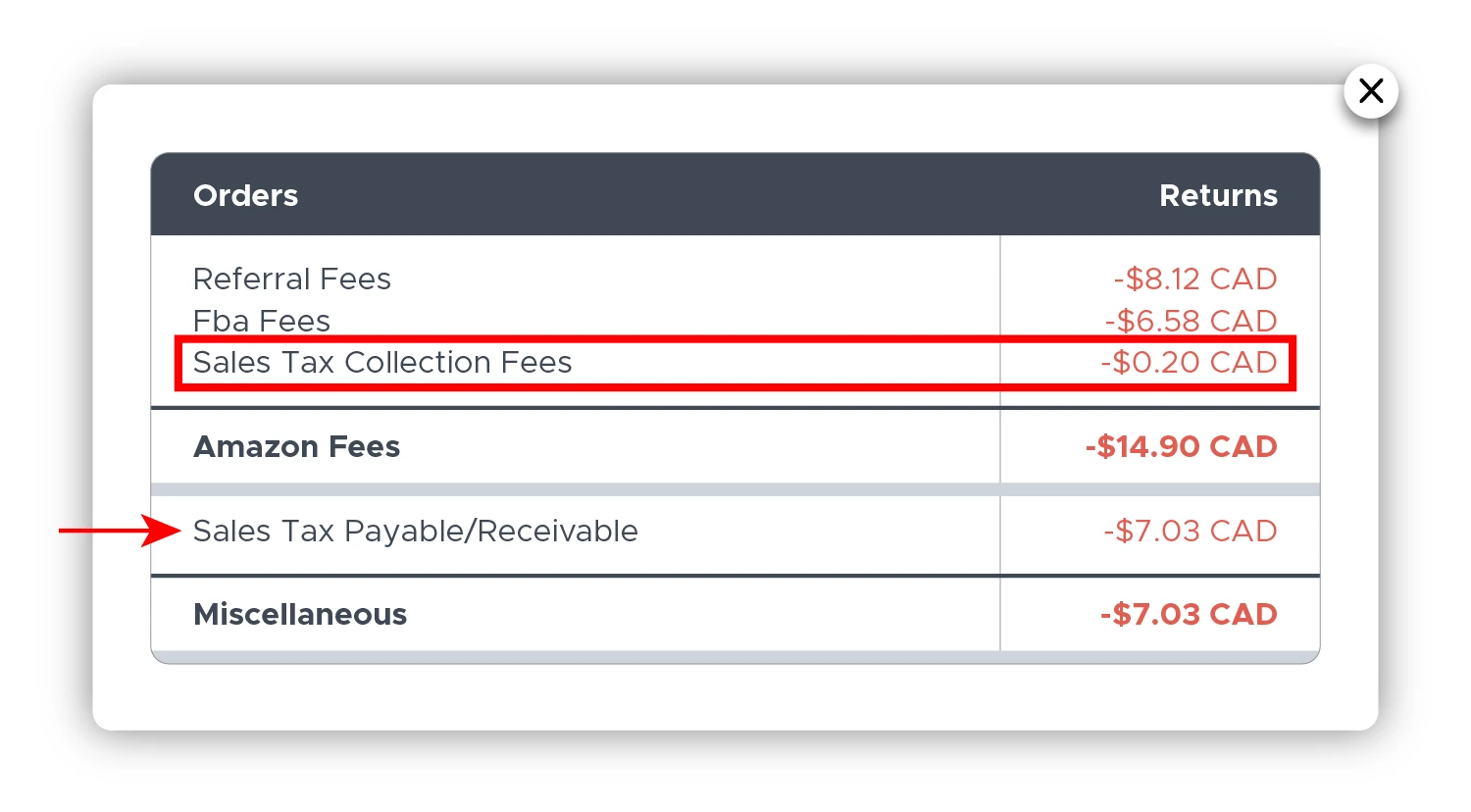
So if the tax amount collected in Canada for HST was $7.03, Amazon will charge you $0.20 Sales Tax Collection Fee, and will send you $7.03 together with your payment. At the end of your fiscal year (or maybe sooner if you do quarterly HST payments), you will need to remit this amount to the CRA.
Check Your Sales Tax Service Breakdown
Seller Rewards
The SellerRewards describes the expenses related to signing up for Seller Rewards program. Benefits of this program include access to promotional tools or premium services, but there may also be performance-based costs. Sellers should check the program's conditions for specifics as the cost may change.
FBM Shipment
FBM Shipment refers to the actual procedure of getting a product ready and shipping it to the client. It entails selecting the item from stock, packaging it, and sending it out for delivery.
FBM Shipping
FBM Shipping refers to the expenses and logistics involved in getting the goods to the consumer. It contains the selected shipment options, shipping costs, and any handling charges related to the delivery procedure.
Shipping Charge
| Shipping Charge is also called Shipping, shipping-price, ShippingCharge |
|---|
Shipping Charge is the amount customer pays for shipping, to get the purchased item shipped to his house. This charge is named the same, no matter if it's you or Amazon doing the shipping.
If it’s the Amazon that does the shipping, then you will also see a Shipping Chargeback entry on the same order.
Normally if you do Merchant Fulfilled (MFN) and ship products to customers yourself, this Shipping Charge amount will be paid out to you by Amazon, together with your sales income.
Get a Full View of Shipping Fees
Shipping Chargeback
| ShippingChargeback appears on your transactions when Amazon is the one doing the shipping. |
|---|
Your customer pays Amazon for shipping, so Amazon shows it as income on your transactions. But because you're not the one doing the actual shipping, they also show a Shipping Chargeback in the same transaction. Meaning, Amazon takes back the shipping income that they just gave you.
Unfortunately, having Shipping charge added in to revenue, where you're not even doing the shipping yourself, inflates your revenue figures:
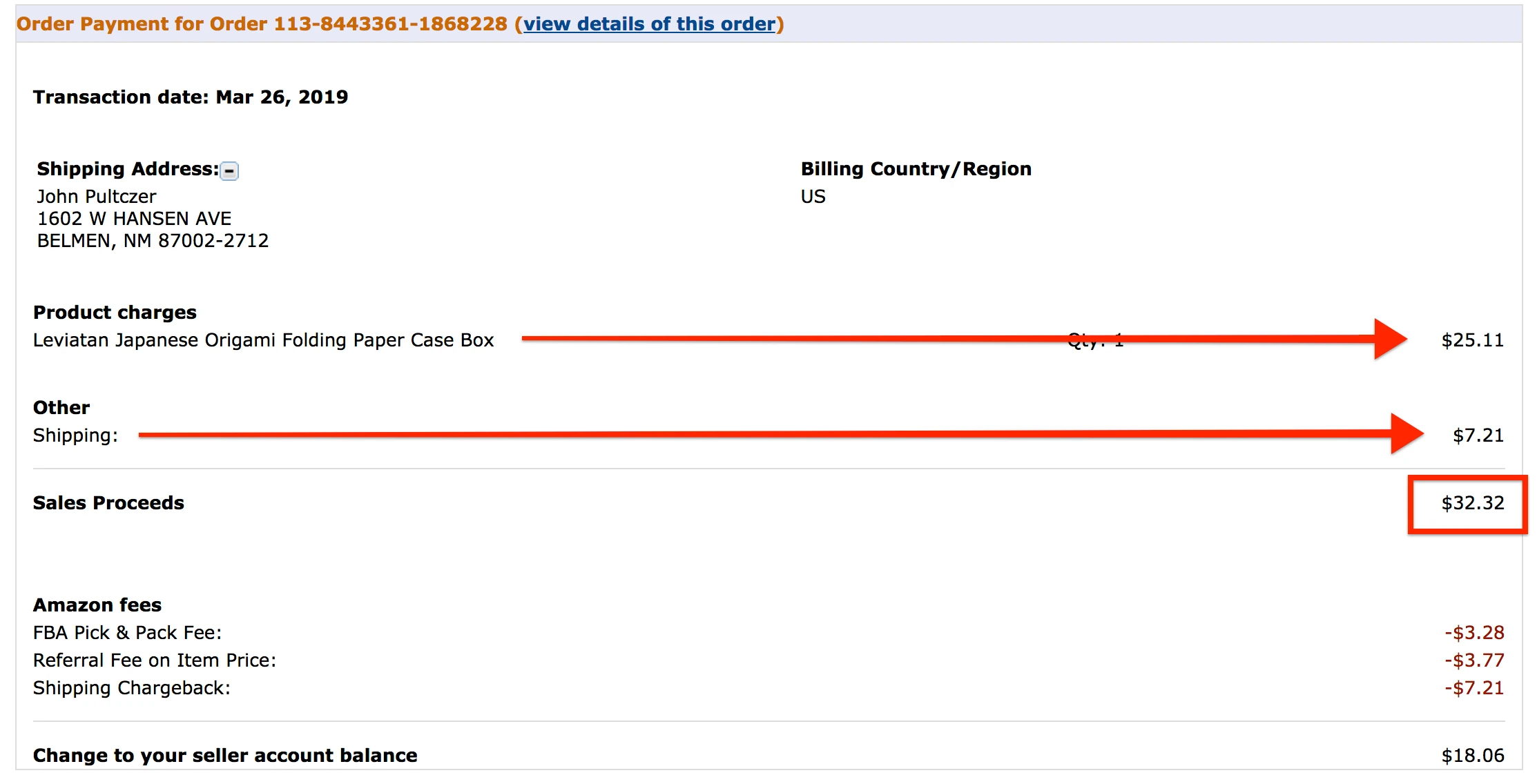
Inflated revenue is something you may want to avoid, especially if presenting your numbers to potential partners or performing any type of financial analysis. Therefore, it's better not to use Amazon reports to pull your revenue figures.
Shopkeeper normalizes your revenue, while still showing you all shipping related transactions on a specific order. It displays your revenue normally - just as you would in your own financial statements:
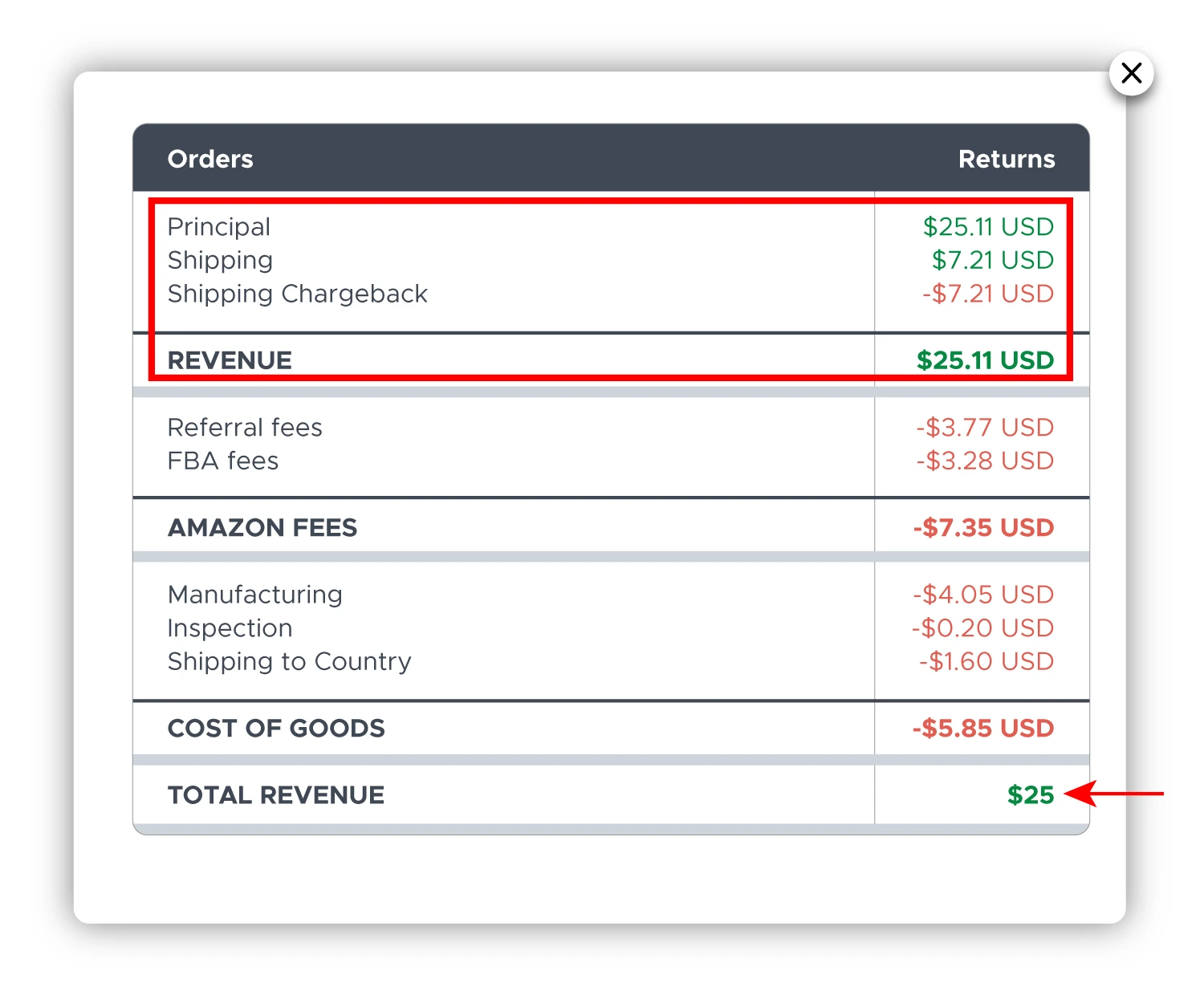
Shopkeeper does not inflate your revenue figures like Amazon does. Shopkeeper includes Shipping Chargeback into your Revenue calculation, instead of showing it in Expenses.
FBM Shipping Fee
The shipping charges for goods sold by independent Amazon sellers that oversee their own inventory and shipment are known as the FBM Shipping Fee. Fees vary according on seller location, delivery method, package size, and destination because sellers determine their own shipping rates based on their costs and preferred methods. These shipping costs are visible to customers at checkout, and unless the seller specifically states otherwise, FBM items usually do not qualify for Amazon Prime free shipping.
Review Your Shipping Fees
Shipping Holdback Fee
| Shipping Holdback Fee is also called Shipping HB, ShippingHB |
|---|
Shipping Holdback fee is basically a referral fee, charged on the Shipping that is completed by you, the seller (MFN). If Amazon is the one doing the shipping, then Shipping Holdback Fee is not charged.
In the old times Amazon used to charge only one referral fee, based on the item price - and sellers were abusing it. Some sellers were charging like $0.50 for the product and an inflated amount for shipping (say, $18). This is how they were avoiding Amazon referral fees, and were only getting charged a minimum referral fee of $0.15 based on the product price.
Eventually Amazon caught up with it, and implemented a fee similar to referral fee for all Shipping that is Merchant-Fulfilled.
Here is how the numbers look like in Shopkeeper, when you do the shipping yourself:
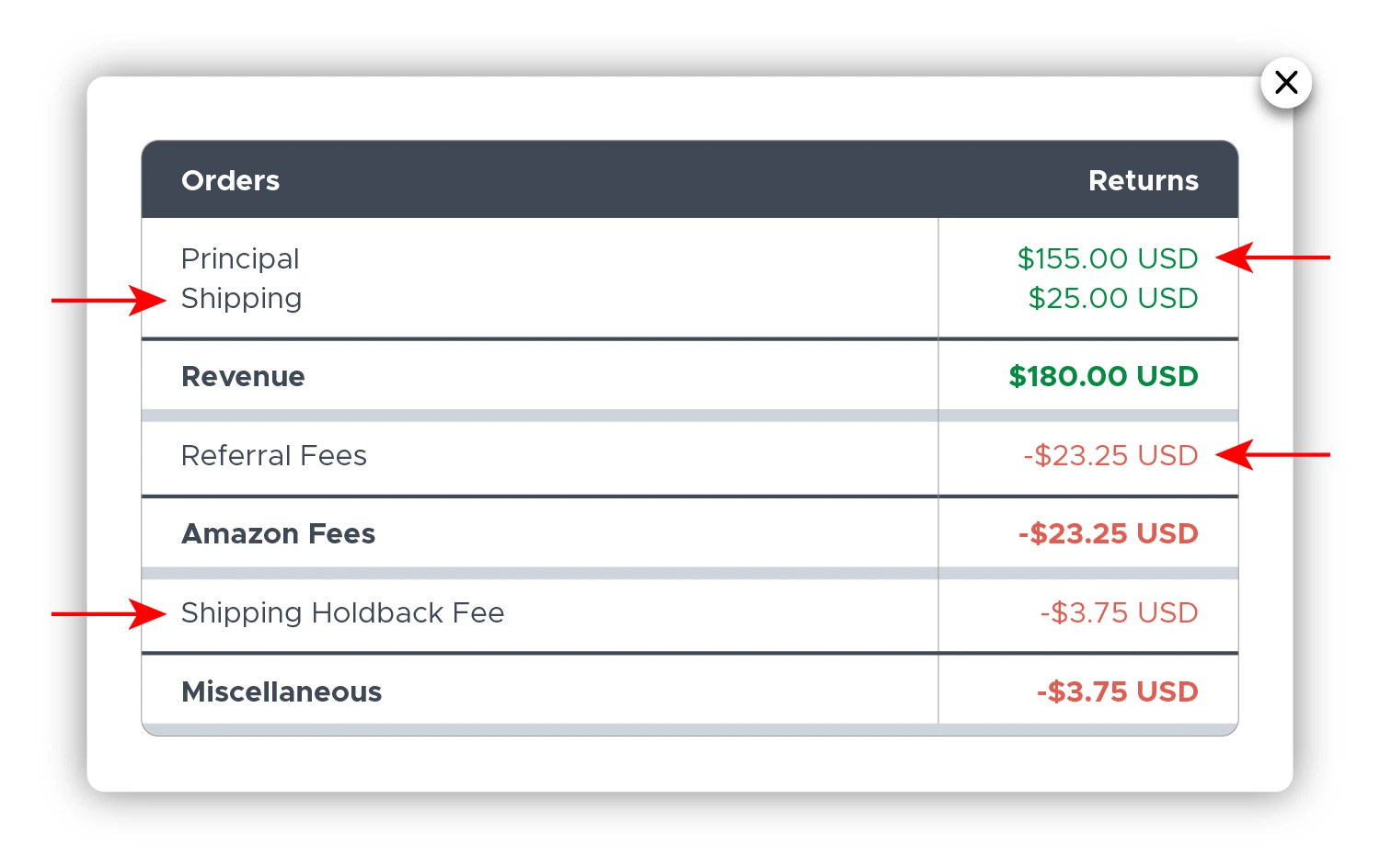
There is another, less obvious situation, where Amazon charges you Shipping Holdback fee, even if there is no Shipping involved.
If you offer a 100% promo to your customer, and they pay $0.00 at the end of their purchase, Amazon then charges you 3 kinds of minimum fees, to offset the cost of you using their marketplace.
Those 3 fees are:
-
Minimum Referral Fee
-
Minimum Gift Wrap Commission
-
Minimum Shipping Holdback Fee
Here is an example:
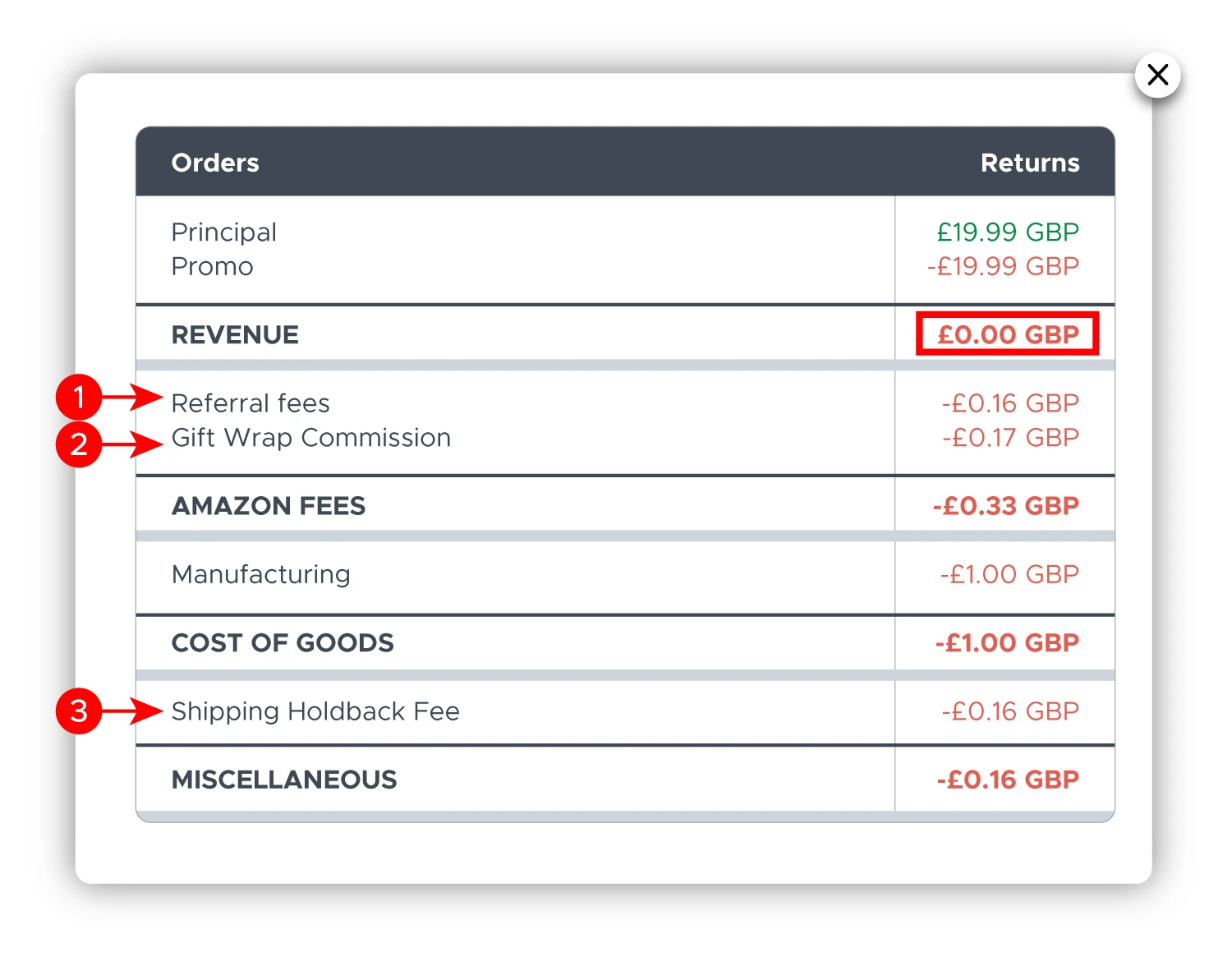
Shipping Promo
| Shipping Promo is a discount on shipping that Amazon provides customers, without you as a seller having nothing to do with it. |
|---|
For example, a customer has no Prime membership, so he has to pay for shipping. He may be reluctant to do shopping on Amazon, because of that. So Amazon incentivizes customers to shop more, offering them special shipping Promos.
There are many different kinds of Shipping Promos that Amazon runs. But in general, none of them affect you as a seller, except for the inflated revenue. Same like with Shipping Charge & Shipping Chargeback.
Here's an example order with Amazon Shipping Promo, displayed via Shopkeeper:
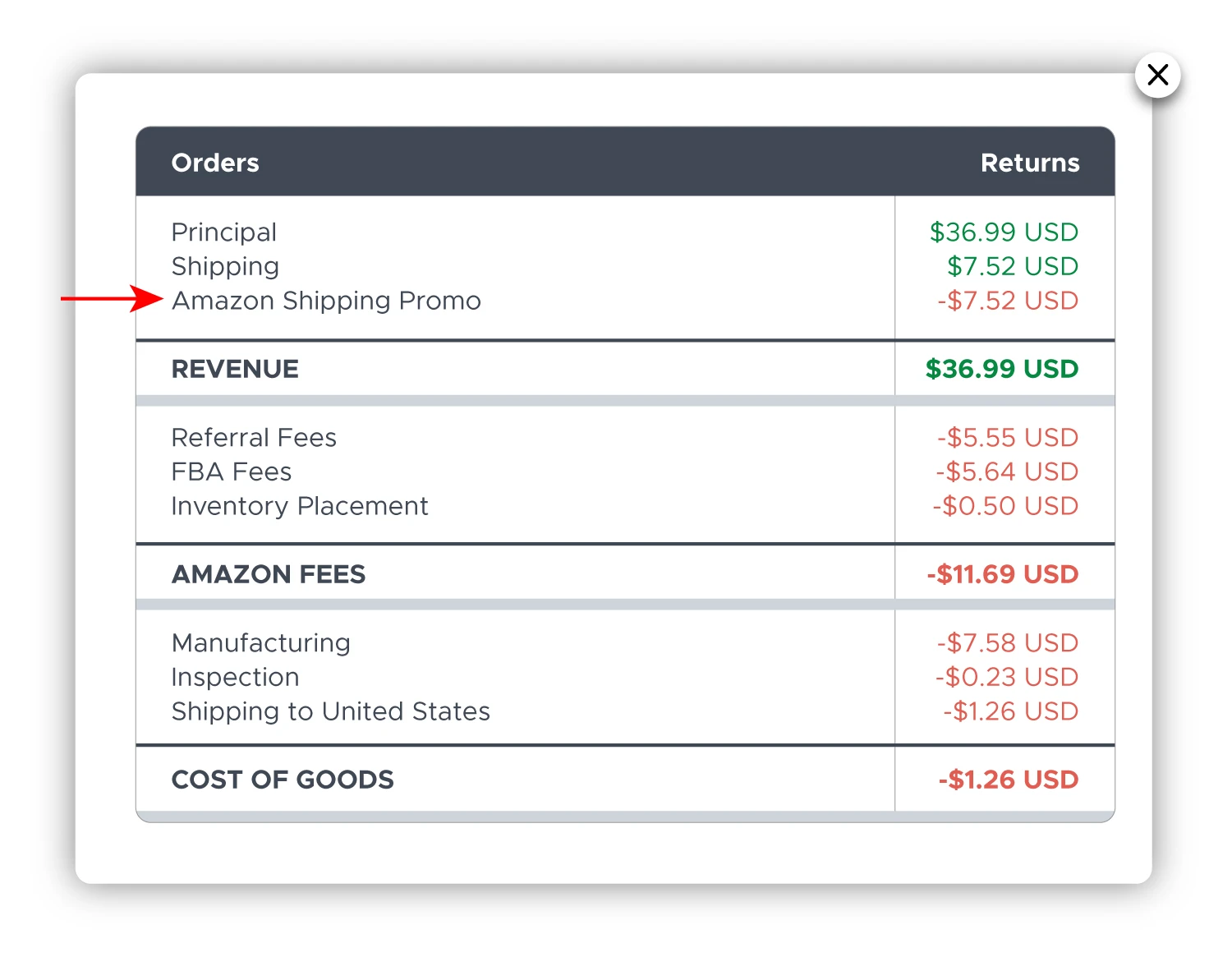
If you click on the plus icon to expand it for more info, you will see a specific Amazon Promo name that was used:
Here is a list of a few random Amazon Promo IDs, for you to see what they usually look like. These Amazon Promo IDs appear in apps like Shopkeeper, because apps can read in more detailed data via Amazon API.
-
UK Core Free Delivery 2015/04/08 23-59-11-975
-
US Core Free Shipping
-
Amazon PLCC Free-Financing Universal Merchant Next Day Promotion
-
MX Core Free Shipping 2015/06/08 16-42-41-775
-
UK Core Free Delivery 2015/04/08 23-59-11-975
-
Amazon PLCC Free-Financing Universal Merchant-2565117
-
Amazon PLCC Free-Financing Universal Merchant Prime-Free-SameDay 2018
-
US Core Free Shipping Promotion A3JU1FCINF5SD0
-
JP Core Free Shipping 2016/03/29 6-38-40-593
And here is how it appears on Seller Central:
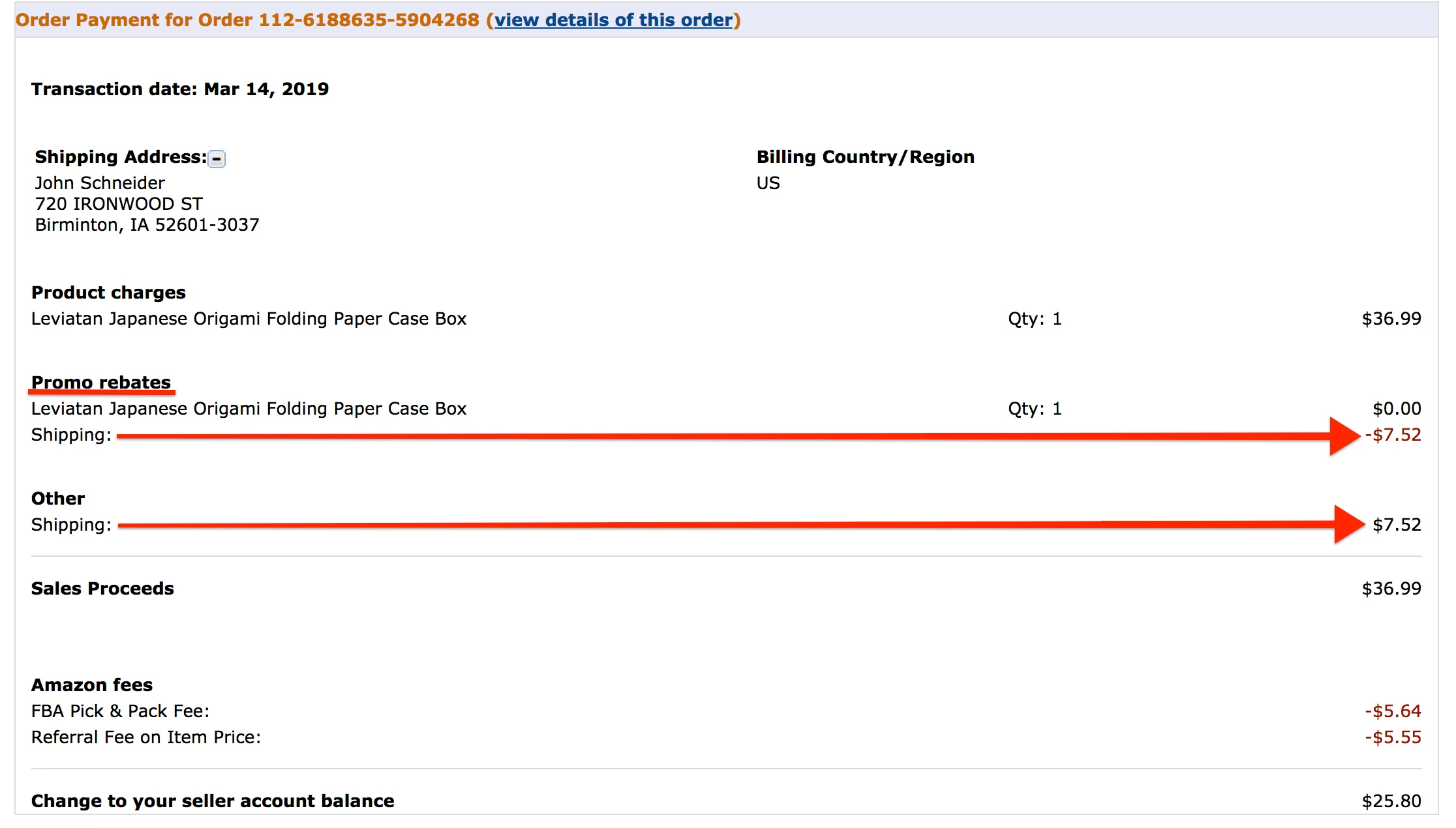
As you see, in Seller Central, you will often not even see a specific Amazon Promo ID. It will just have Shipping Charge and Shipping Promo Rebate.
Understand Your Shipping Expenses
Shipping Tax
| Shipping Tax is also called shipping-tax. |
|---|
Shipping Tax is an amount Amazon charges your customers, based on your tax settings on Amazon Seller central:
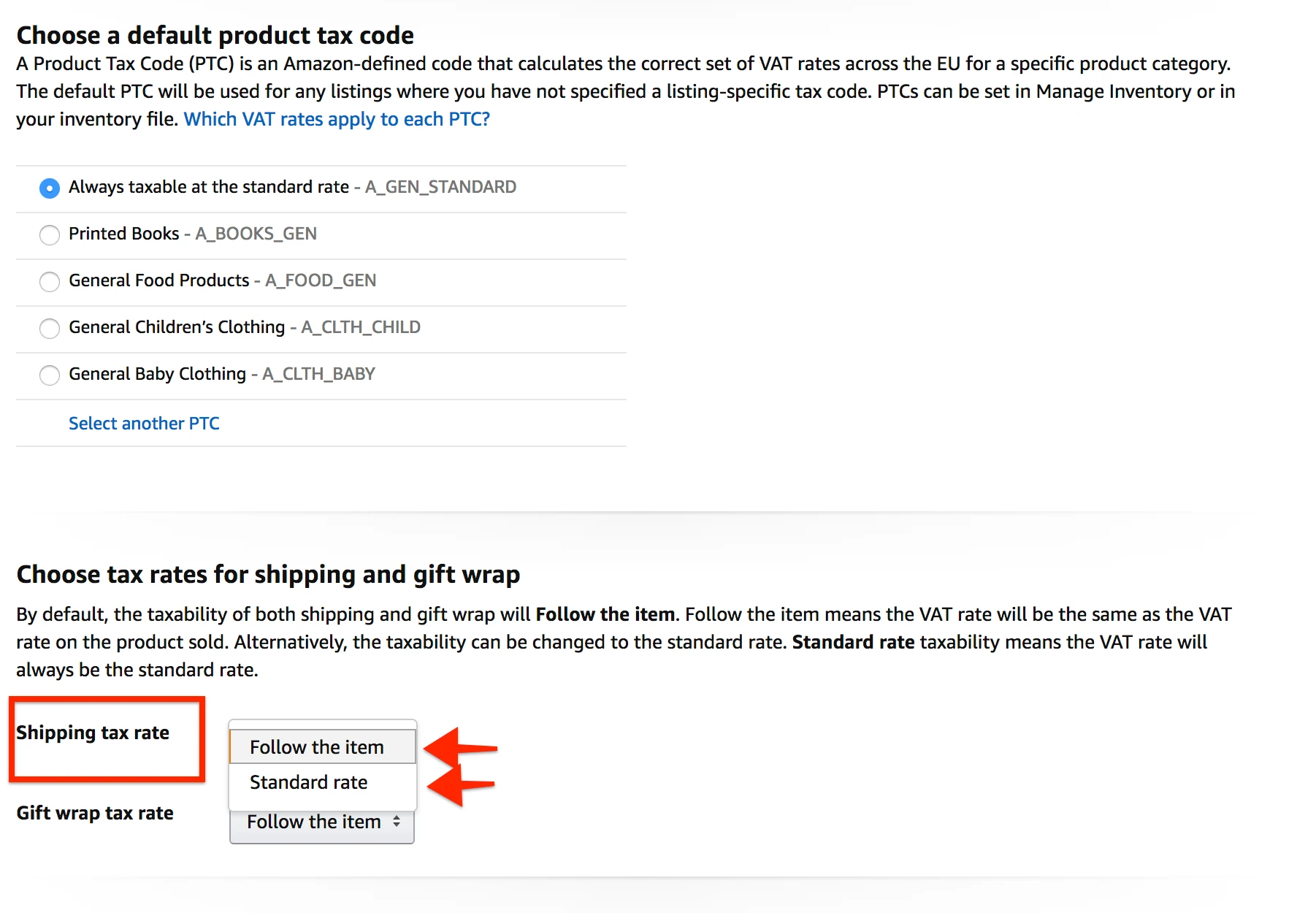
Shipping Tax settings on Amazon Seller Central
One crappy thing about Shipping Tax is that you have to remit collected amount to the government yourself - EVEN if Amazon is the one doing the shipping. This is strange, right?
Here is an example how Amazon charges Shipping Tax to a buyer, but then never adds in a Shipping Chargeback for the seller. This means that the seller will need to remit this collected Shipping Tax amount in their own VAT remittance:
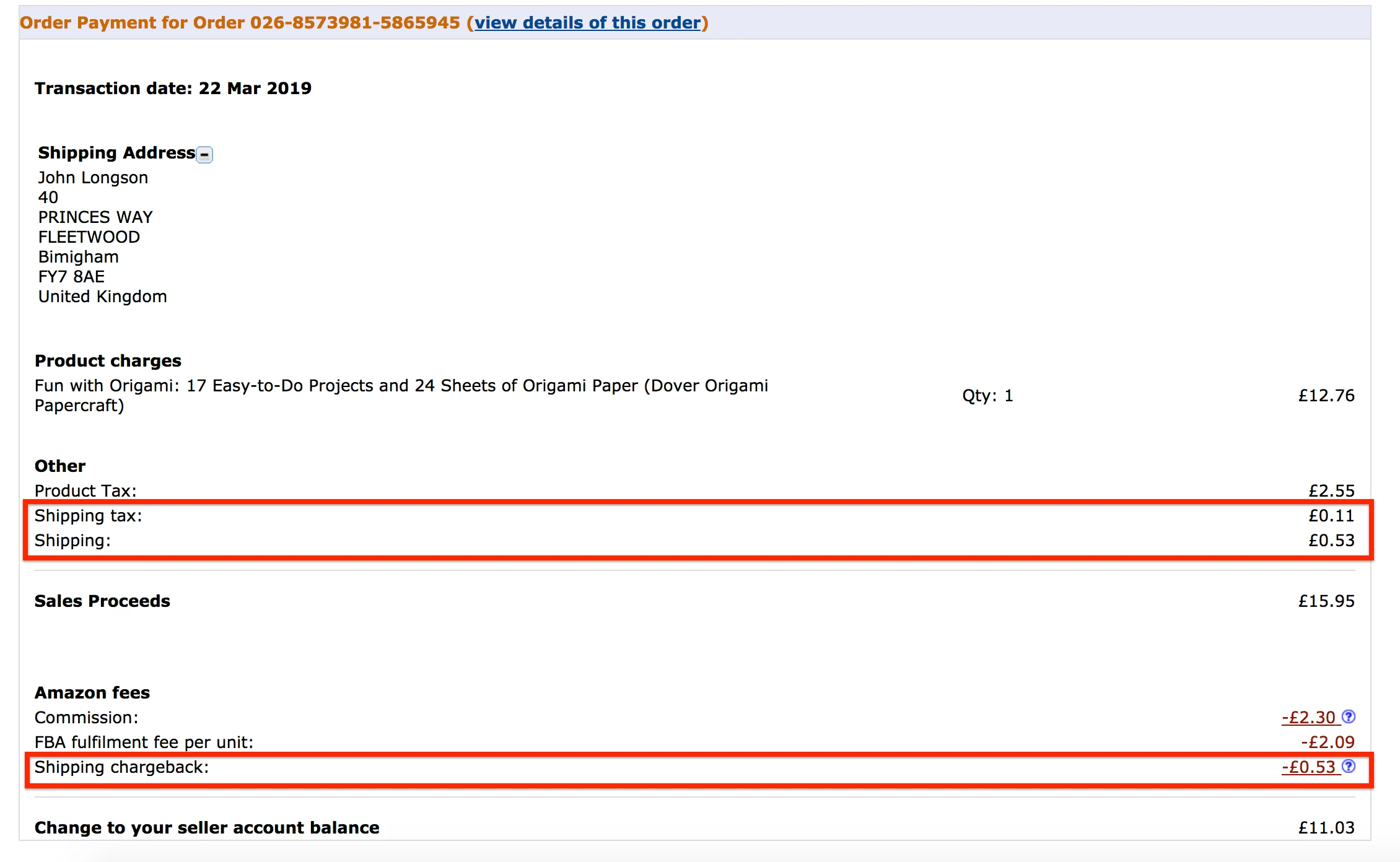
It's best to consult your accountant about this, but just know that this is a standard practice with Shipping Tax on Amazon.
Shopkeeper handles this situation by including the collected Shipping Tax amount in your Tax Payable. That way you see your true profit, and exact amount that you will have to remit at the end of the year:

Shopkeeper includes Shipping Tax into your Tax Payable, and subtracts it from your Profit.
If you sell on Amazon USA, shipping tax can be either collected or not collected, based on state-specific rules and regulations. You as a seller will have to decide whether to collect sales tax on shipping or not.
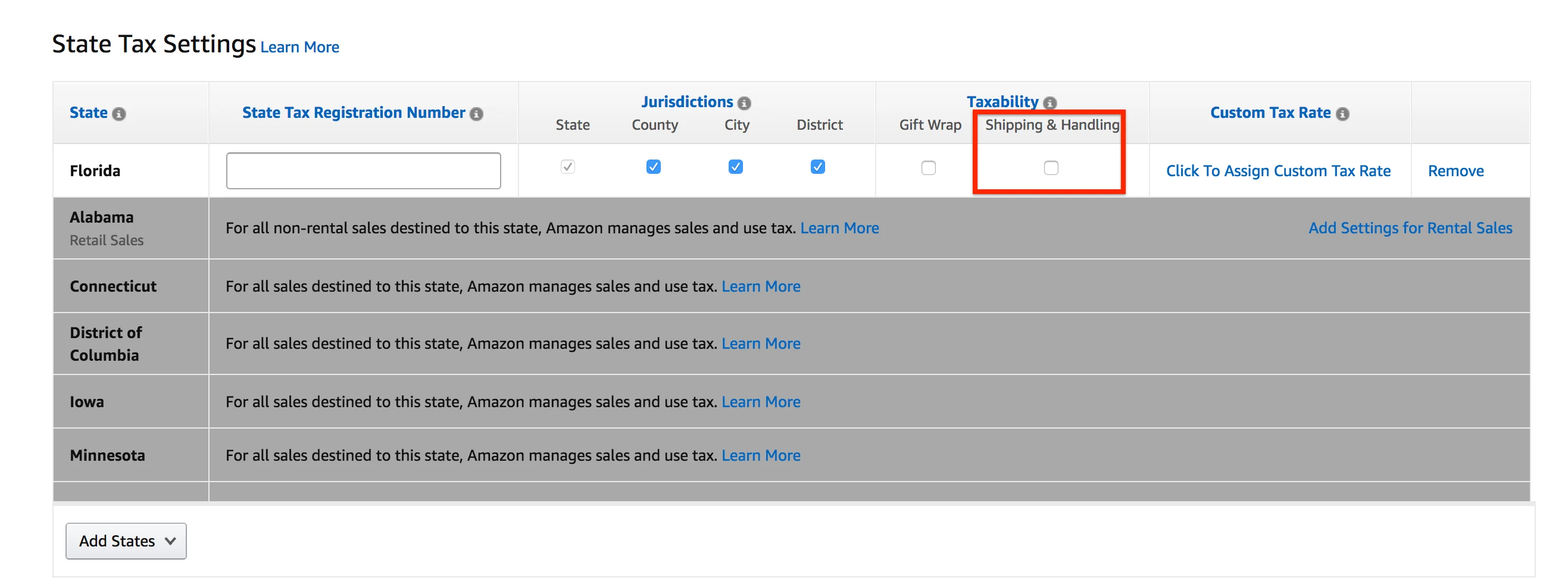
Amazon Seller Central USA Shipping Tax settings for states where Amazon does not automatically collect & remit tax for you
In Amazon USA Seller Central, for those states that Amazon does not have agreements yet to collect sales tax on your behalf automatically, you will need to manually indicate whether you want to collect Shipping Tax or not. I recommend referring to this guide first:
State by State Shipping Tax Guide - Avalara
STAR Storage Billing
STARStorageBilling is most likely referring to the billing event or the total charges calculated and invoiced by Amazon for keeping your products at their fulfillment centers. This invoicing occurs regularly (typically monthly) and depends on the overall storage capacity used by your inventory.
For example, suppose you have 200 units of a product held in an Amazon warehouse. Each unit takes up 0.15 cubic feet, and Amazon charges $0.75 per cubic foot per month for standard-size items held during non-peak months (January to September). For the monthly billing cycle, STARStorageBilling would calculate the following:
Total Storage Volume: 200 units x 0.15 cubic feet = 30 cubic feet
Monthly Storage Fee: 30 cubic feet x $0.75 = $22.50
In this case, STARStorageBilling for the month would be $22.50.
STAR Storage Fee
STARStorageFee indicates the actual storage expenses that Amazon charges for storing your products in their fulfillment centers. These fees are calculated depending on the amount of space your products take up (measured in cubic feet) and the length of time they are stored. The fees vary by product size (standard-size vs. enormous) and season, with higher charges during peak months (October to December).
Let's say your inventory takes up 30 cubic feet in Amazon’s warehouse, and if the standard storage rate is $0.75 per cubic foot in non-peak months, the STARStorageFee would be:
Storage Fee for One Month: 30 cubic feet x $0.75 = $22.50
During a peak season (October-December), the rate might increase to $2.10 per cubic foot, making the storage fee:
Storage Fee in Peak Season: 30 cubic feet x $2.10 = $63.00
Track Your Storage Fees
Subscription
The Subscription fee is what you pay for your Amazon seller account, usually 39 EUR in Germany. Amazon has two types of sellers: individual and professional.
Individual sellers, selling 40 units or fewer monthly, don't pay a subscription fee but have a $1.00 per unit fee for each sale.
Professional sellers, dealing with their products, pay a $40 monthly fee, giving full access to Amazon's platform without the extra $1 per unit cost for each sale.
Subscription Fee Correction
SubscriptionFeeCorrection is an adjustment made to a seller's subscription fee. Amazon often charges sellers a monthly subscription fee to retain their selling accounts, particularly Professional Sellers. If there is an issue, such as an overcharge, undercharge, or other billing mistakes, Amazon may use a SubscriptionFeeCorrection to refund or fix the subscription charging.
This adjustment may occur if there is an error in the monthly billing or if the seller changes their plan (for example, from the Individual plan to the Professional plan or vice versa) during the billing cycle, prompting Amazon to alter the amount paid.
FBA Storage Fee
FBAStorageFee is a monthly charge by Amazon for storing sellers' inventory in their fulfillment centers. Calculated based on the volume (cubic footage) occupied by the products, this fee considers the average volume throughout the month. The tiered fee structure means rates may vary depending on the time of year and the size of the products.
Check Your Monthly Storage Fees
Taping Fee
TapingFee is applied when your products require additional taping during the consolidation process into one container. This fee is necessary for items that might need extra taping to prevent them from falling out of their packaging, leaking, or to ensure complete sealing within the container. It covers the cost of securing products beyond the typical taping used to seal boxes, poly bags, or secure bubble wrap around an item.
Tax
| Tax is also called item-tax, base tax. |
|---|
Tax is the amount of tax that Amazon customers are charged on their orders. Tax amount is directly dependant on your tax settings on Seller Central.
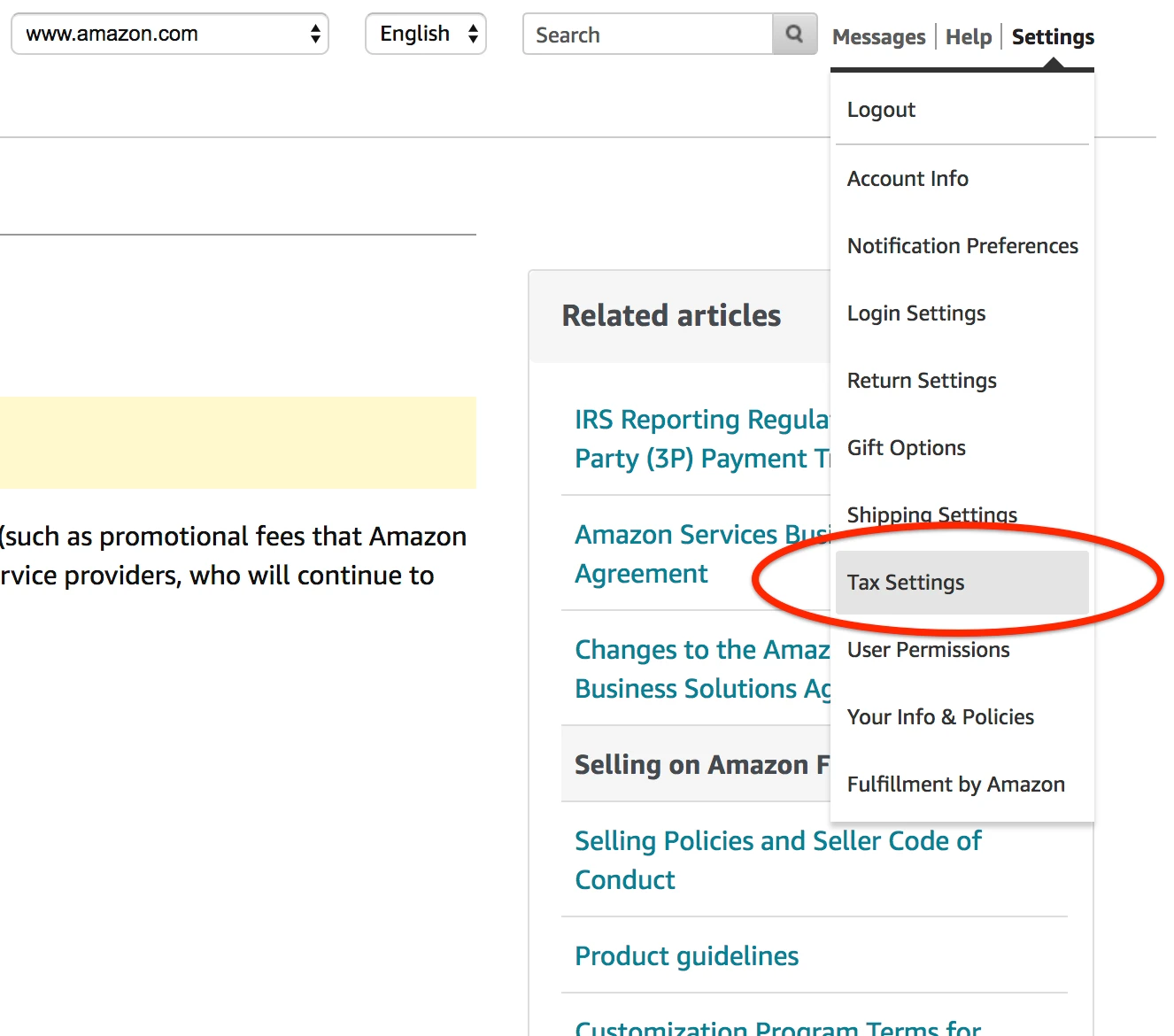
For example, if you collect Sales Tax VAT from your buyers in UK, you include VAT in your price.

Your tax settings in Seller Central will look something like this:
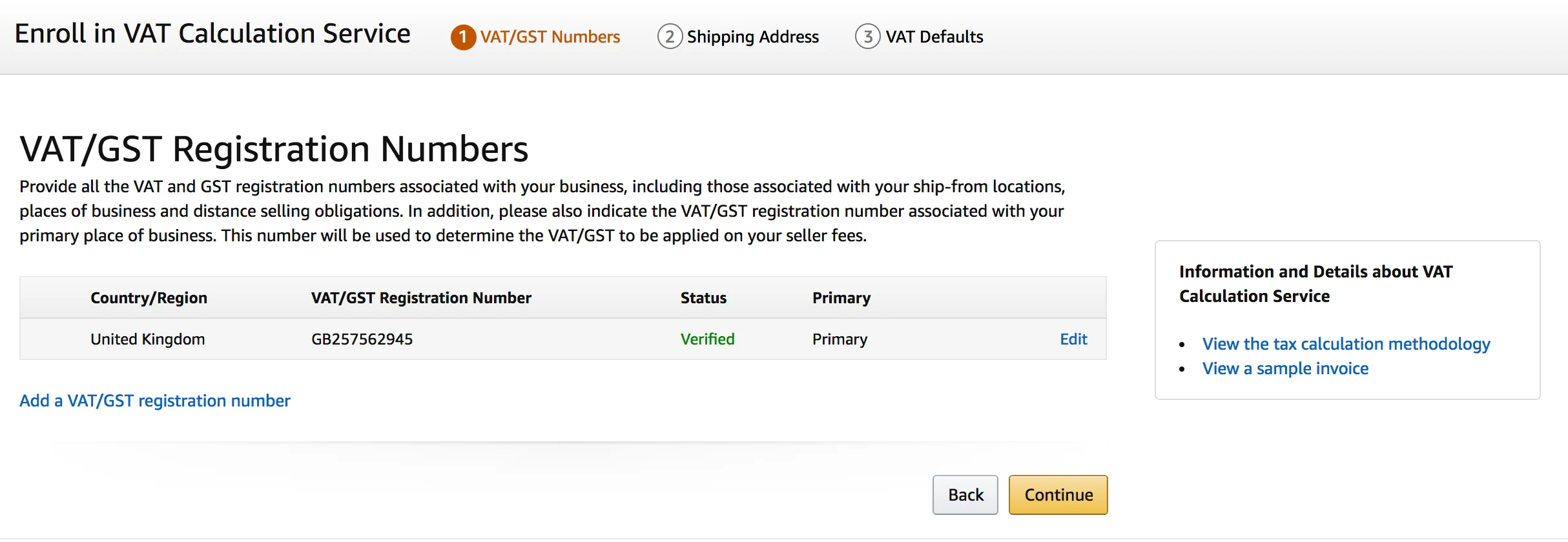
and VAT defaults page will look similar to this:
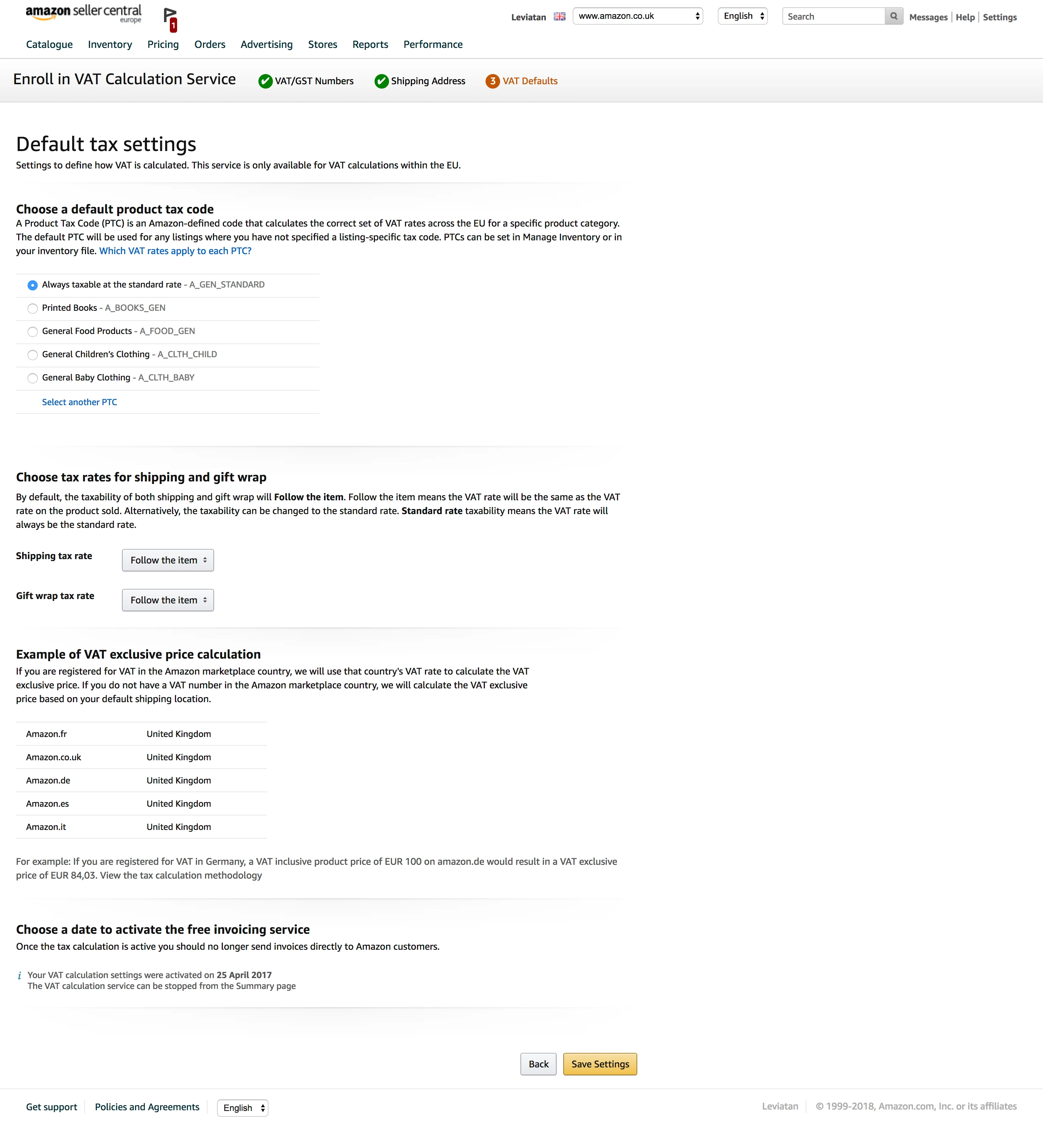
VAT settings on Amazon Seller Central
So if your product price is £15.31, then the VAT amount is £2.55:
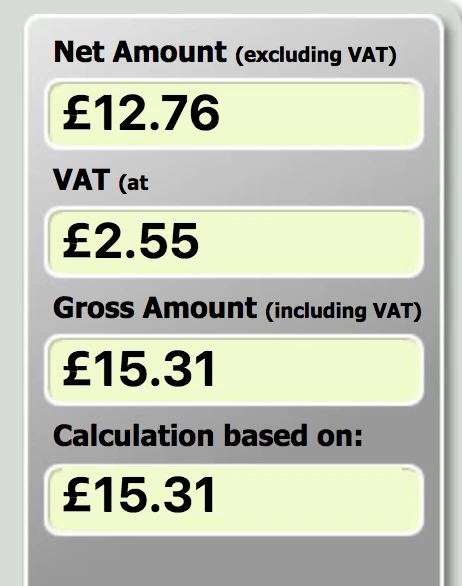
When the order is Shipped, Amazon will show you tax breakdown on Seller Central Order page:
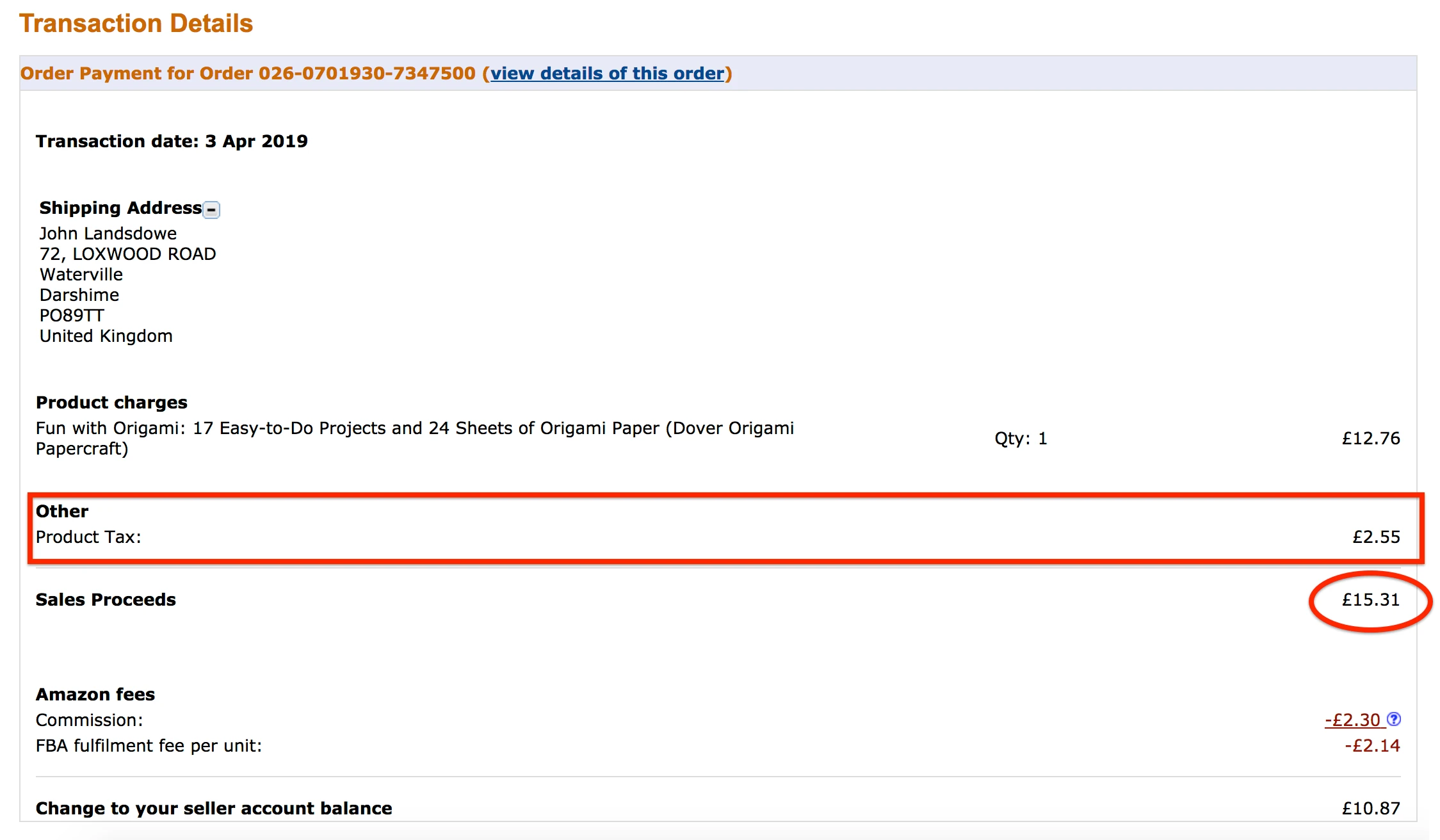
In apps like Shopkeeper, you will see the £12.76 amount being called Principal, and Product Tax will be called Tax - because that is how they appear in your data feed via the Amazon API:
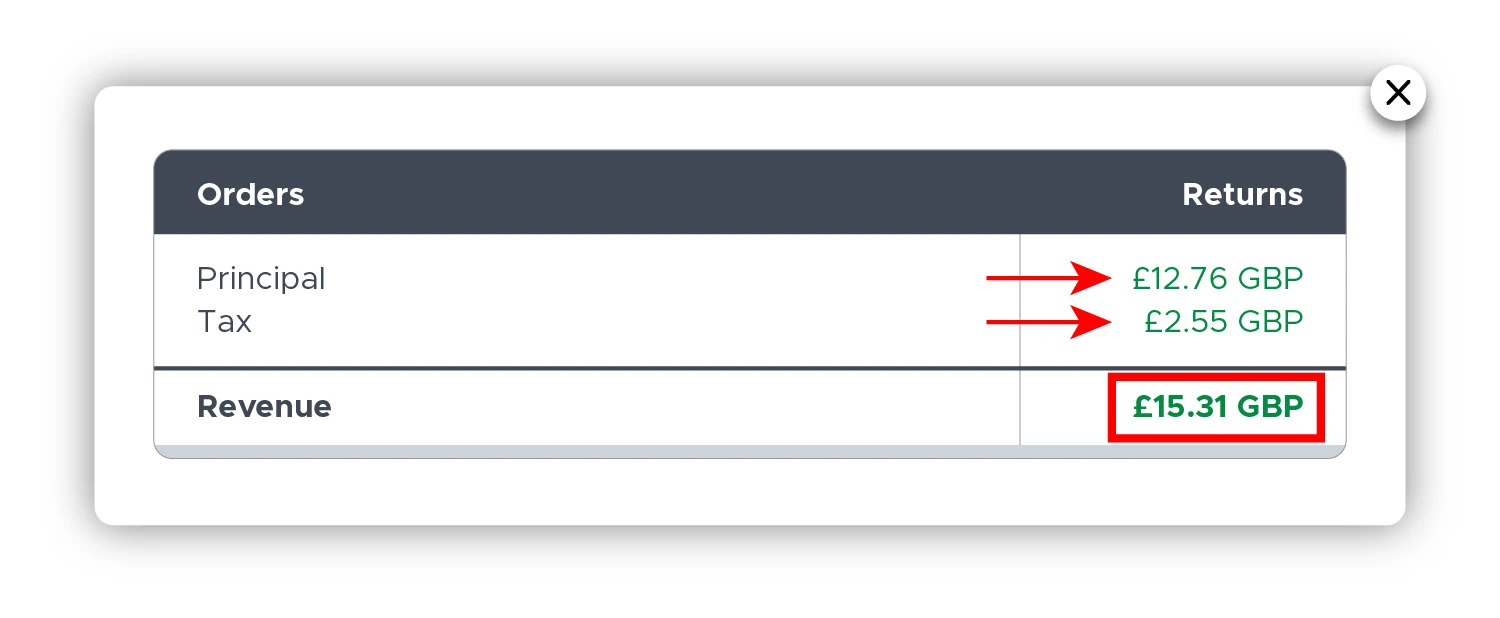
Track Your Tax History
Tax Collected At Source
TaxCollectedAtSource is a tax collected from sellers at the point of sale for transactions made on its platform. This system is intended to minimize tax evasion and expedite tax collection for government authorities.
While sellers do not have to handle the tax collection process themselves, they should take TCS into account when pricing their products. The percentage and regulations for TCS can vary by region, so sellers need to be aware of the applicable tax laws in their area. Overall, TCS makes compliance easier by ensuring taxes are collected upfront during sales. Amazon determines the applicable TCS based on the sale price and local tax rates when a customer makes a purchase, and then remits this tax to the appropriate authorities.
Technology Fee
TechnologyFee is a charge paid by sellers for the use of Amazon's technology infrastructure and services, which covers the expenses of platform maintenance, security, and other critical backend tasks that support Amazon sales.
FBA Transportation Fee
The FBATransportationFee on Amazon is the cost of shipping items from a seller's location to an Amazon fulfillment center.
Example: Assume a seller in New York ships 200 units of a product to an Amazon fulfillment center in Ohio. If the transportation fee is $0.30 per unit, the total FBATransportationFee will be:
-
Transportation Fee: 200 units x $0.30 each = $60
The seller pays a $60 fee to Amazon for transporting the merchandise to the fulfillment center.
Uncover Your FBA Transportation Fees
FBA Try Before You Buy Multitier Per Unit Fee
The FBATryBeforeYouBuyMultitierPerUnitFee is a per-unit cost for items in the "Try Before You Buy" program. The fee varies depending on the item's category, size, and weight.
Variable Closing Fee & Fixed Closing Fee
| Variable Closing Fee and Fixed Closing Fee is also called VariableClosingFee, FixedClosingFee |
|---|
Closing Fee is essentially an additional Amazon Referral Fee, charged on Media items like books, DVDs, Video Games and Music.
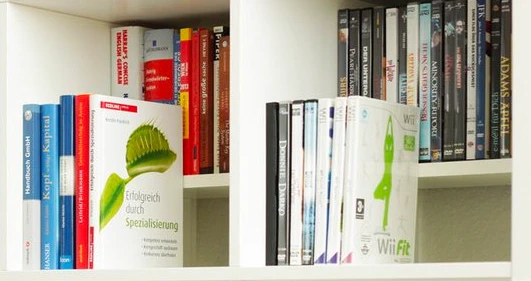
Books, Games, DVDs have an additional referral fee, called Closing Fee
There are two kinds of closing fees:
-
Variable Closing Fee
-
Fixed Closing Fee
Amazon keeps changing the way they charge closing fees, it used to be based on percentage of the price, later it had minimums and maximums, then it became only one fixed charge.. So they sometimes call it Variable, sometimes Fixed - but it’s all about the same thing, a Closing Fee.
Whatever the calculation formula Amazon uses, Closing Fee is just an extra Referral Fee that they charge for media items.
I am not so sure why Amazon is charging additional fee for all Media items. Maybe it’s because they originally started as an online bookstore, and feel that they are the best place for selling books and video games, so therefore charge a premium for that category?
For example, if you sell a book for $9.99, you will get charged a flat $1.80 Closing Fee, in addition to Referral and FBA fee:

It's very hard to make money with Media items priced under $10. Amazon Seller Fees, Shipping costs and Storage fees basically eat up all your profit margins and there is not much left for you at the end.
Tip: Avoid selling low priced items on Amazon, as your dreams may not come true...

VAT Amazon Technology Fee
VatAmazonTechnologyFee covers the VAT on Amazon's technology services, such as cloud computing and platform tools. Sellers or businesses who utilize these services are responsible for paying the fee, which includes any relevant VAT based on their region.
VAT Fiscal Representation Fee
VatFiscalRepFee covers the expense of establishing a fiscal representative, which certain EU nations like France, Italy, Poland, and Spain demand for non-EU sellers to manage their VAT duties. Non-EU sellers wishing to sell in these countries are responsible for paying the fee.
VAT Manufacturing
VAT manufacturing is the value-added tax applied to the cost of products manufactured. Manufacturers pay value-added tax (VAT) on the goods and services they use to produce goods in many different nations.
VAT Partner Fee
VatPartnerFee applies when sellers use Amazon's associated VAT compliance services. These services assist with activities such as VAT registration, filing, and continuing compliance. Sellers who choose to use these services are the ones that pay the cost.
Calculate Your VAT Tax
VAT Product Cost
The advertised price of the goods at the time of purchase includes VAT product cost. At checkout, it's included in the final amount the customer pays.
VAT Purchase
VAT purchase usually refers to the VAT that is applied to the total amount you pay, which may include not only the cost of the product but also, if necessary, the shipping and handling charges.
VAT Registration Fee
The VatRegistrationFee is a one-time fee levied when a seller registers for VAT in a new country. This fee entitles the merchant to lawfully offer products in that market.
VAT Transfer Fee
VatTransferFee is applicable in any country where VAT is transmitted or remitted, often inside the EU. It refers to the process of transferring VAT collected from sales to the appropriate tax authorities in nations such as Germany, France, Italy, and Spain.
Track All Your Amazon VAT
Vine Fee
Sellers who take part in the Vine program on Amazon are required to pay a fee known as the VineFee. Through this initiative, they can give out free products to verified reviewers on Amazon called Vine Voices. Vine Voices provides independent, truthful reviews of the things they receive in return. The administrative costs of running the program, guaranteeing adherence to Amazon's review guidelines, and streamlining the review procedure are all covered by the Vine fee. When choosing to be a part of the Vine program, suppliers should take this price into account because it adds to the total expense of getting positive product ratings on the Amazon marketplace.
As of October 19, 2023, Amazon implemented changes to the Vine enrollment fee rates. Under this updated fee structure, vendors are charged a one-time enrollment fee per parent ASIN based on the number of units enrolled. This fee is invoiced seven days after the publication of the first review. The fee rates are as follows:
-
For 1 to 2 units enrolled, there is no Vine enrollment fee.
-
For 3 to 10 units enrolled, the Vine enrollment fee is $75.
-
For 11 to 30 units enrolled, the Vine enrollment fee is $200.
Warehouse Damage
WAREHOUSE_DAMAGE occurs when your items are damaged while in Amazon's warehouse. In such cases, Amazon will automatically reimburse you without requiring any action on your part. Amazon usually sells damaged items at a lower price or disposes of them. If you notice damage, you can request a manual reimbursement, but this falls into the exception category and is not the usual process.
Warehouse Damage Exception
WAREHOUSE_DAMAGE_EXCEPTION involves compensating sellers for damaged goods in the warehouse. If a seller identifies an item as damaged in the warehouse, they can initiate a reimbursement request through an investigation. Manual reimbursements, particularly for damaged items, fall within the exception category. This fee ensures sellers receive proper compensation for any damage incurred during the fulfillment process.
Warehouse Lost
WAREHOUSE_LOST refers to instances where your items are lost in Amazon's warehouse. In these cases, Amazon will compensate you for the loss. Amazon's policy has changed, and they may pay a reduced amount for lost goods. The reimbursement criteria include factors like the average market price, and the final decision rests with Amazon.
Warehouse Lost Manual
WAREHOUSE_LOST_MANUAL is a fee or inventory adjustment that occurs when Amazon manually records an item as lost in their fulfillment center. It usually follows an audit or investigation, and if Amazon is at fault, they may reimburse you.
Sign up for Shopkeeper
We hope that you liked this comprehensive breakdown of all Amazon seller fees. Make sure to bookmark this page for future reference and sign up for Shopkeeper so that you will never have to worry about complicated or inaccurate fees displays!



